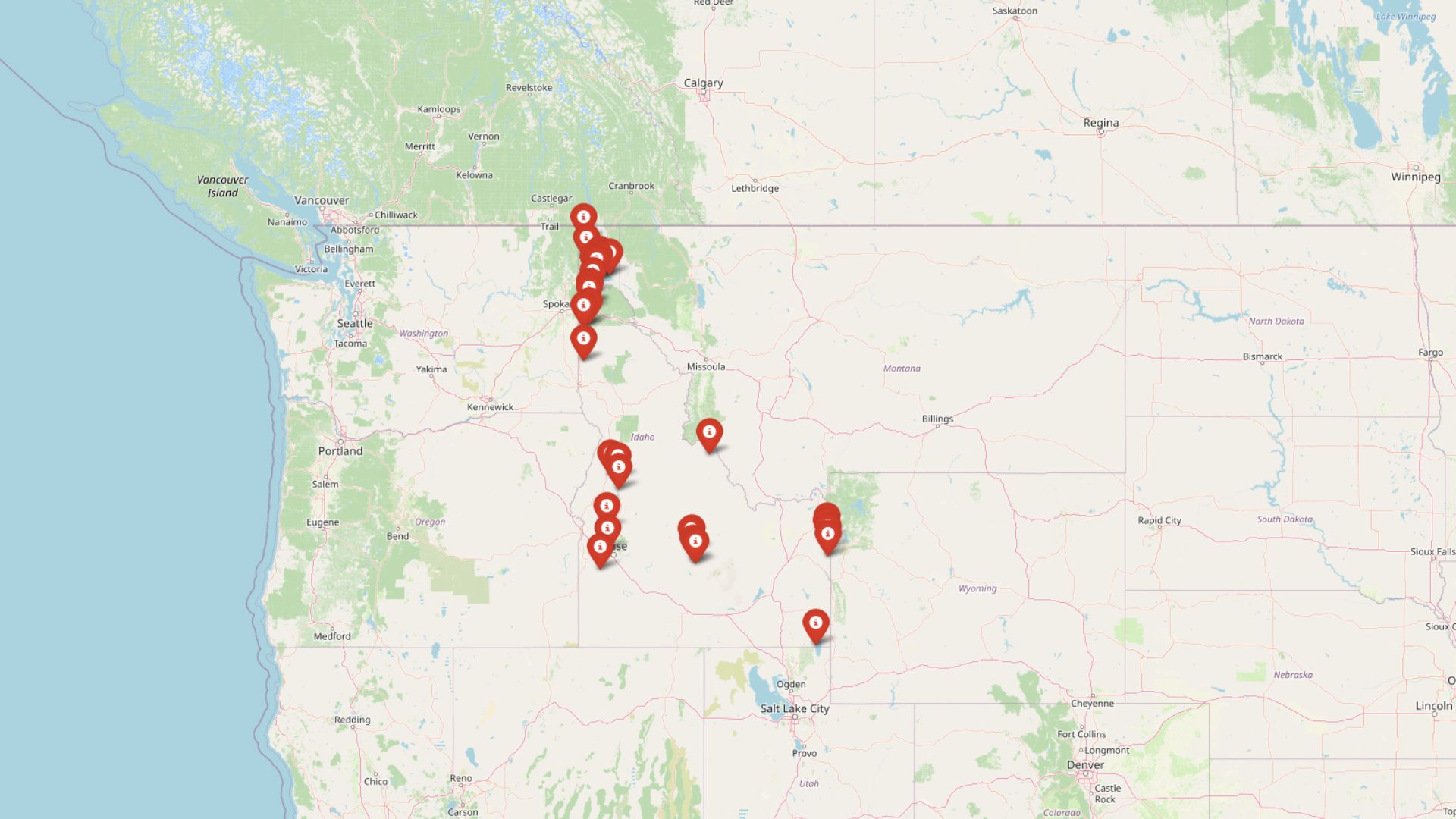
California’s housing market continues to break records across exclusive communities from Silicon Valley to luxury beach towns. Using the latest Zillow Home Value Index data from July 2025, these 30 towns represent the pinnacle of American real estate prices. Each location tells a story of wealth concentration, technological innovation, and coastal desirability.
From Atherton’s tech executive estates to Montecito’s celebrity hideaways, home values in these communities have surged dramatically over the past 15 years. Whether driven by proximity to Silicon Valley, beachfront access, or prestigious school districts, these towns showcase where America’s wealthiest choose to live. Understanding these markets provides insight into broader economic trends and investment patterns shaping California’s future.
30. Palos Verdes Estates – 94% Home Price Increase Since 2010
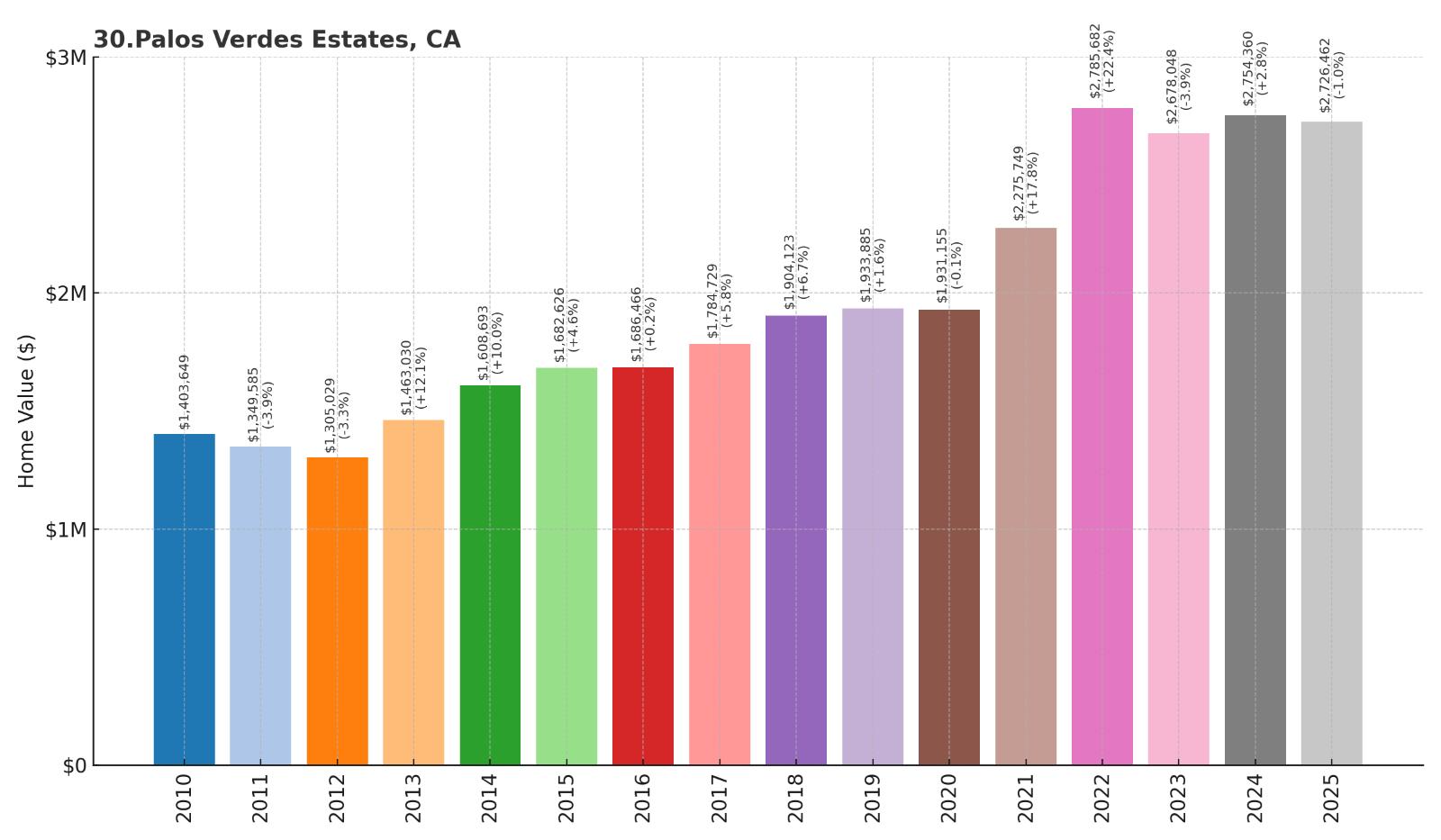
- 2010: $1,403,649
- 2011: $1,349,585
- 2012: $1,305,029
- 2013: $1,463,030
- 2014: $1,608,693
- 2015: $1,682,626
- 2016: $1,686,466
- 2017: $1,784,729
- 2018: $1,904,123
- 2019: $1,933,885
- 2020: $1,931,155
- 2021: $2,275,749
- 2022: $2,785,682
- 2023: $2,678,048
- 2024: $2,754,360
- 2025: $2,726,462
Palos Verdes Estates has shown remarkable resilience with steady growth through 2025, reaching $2.7 million after weathering early 2010s market corrections. The community experienced its biggest jump during the pandemic years, gaining nearly $850,000 between 2020 and 2022. Recent price stabilization reflects broader market cooling while maintaining its position as one of Southern California’s premier coastal enclaves.
Why Palos Verdes Estates?
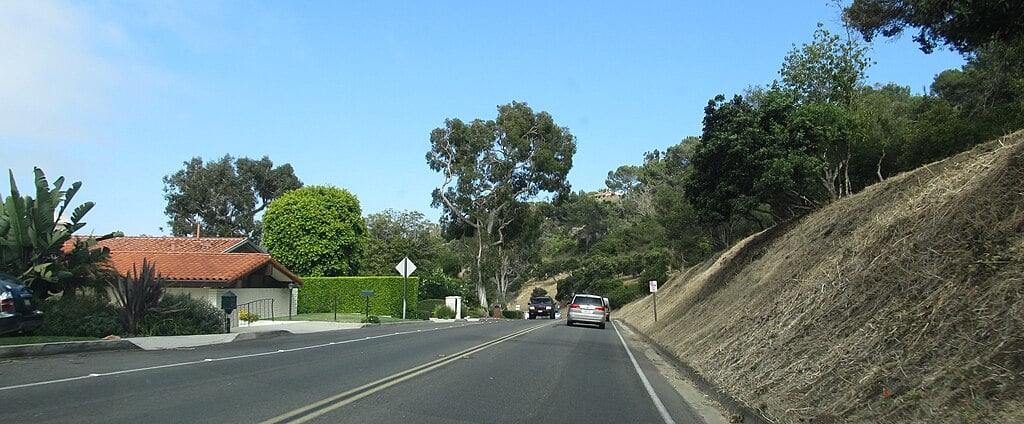
Why are people willing to pay so much to live here? What’s special about it?
Families choose Palos Verdes Estates for its rare combination of ocean views, top-rated schools, and gated community privacy. The city sits atop dramatic coastal bluffs offering panoramic Pacific vistas while maintaining strict architectural controls that preserve its Mediterranean character. Unlike denser Los Angeles neighborhoods, residents enjoy larger lots, horse trails, and a small-town atmosphere just 30 minutes from downtown LA.
The community’s exclusivity stems from its limited housing stock and restrictive zoning that prevents overdevelopment. Buyers pay premium prices for access to some of California’s best public schools, private golf courses, and direct beach access. The area’s natural beauty and proximity to major employment centers create sustained demand that consistently outpaces supply.
How Palos Verdes Estates Rose to Prominence
Palos Verdes Estates was conceived in the 1920s as a planned community by landscape architect Frederick Law Olmsted Jr., who designed it to rival the finest Mediterranean coastal towns. The development attracted wealthy families seeking an escape from increasingly urbanized Los Angeles while maintaining business connections to the city. Early residents included oil executives, real estate developers, and entertainment industry pioneers who valued the community’s architectural covenants and natural setting.
Post-World War II suburban expansion brought new residents but the community maintained its exclusive character through careful planning and zoning restrictions. The establishment of excellent schools and the preservation of open space cemented its reputation as one of the South Bay’s most desirable addresses. By the 1970s and 1980s, Palos Verdes Estates had become synonymous with upscale coastal living, attracting executives from aerospace, entertainment, and finance industries.
3 Interesting Tidbits
1. Architectural Harmony – The city maintains strict Mediterranean Revival architectural guidelines established in the 1920s, requiring white stucco walls and red tile roofs on all homes.
2. Equestrian Heritage – Miles of bridle trails wind through the community, reflecting its origins as a place where wealthy families could keep horses and enjoy rural pursuits.
3. Nature Preserve – The Palos Verdes Nature Preserve encompasses over 1,400 acres of coastal sage scrub habitat, providing hiking trails and protecting native California ecosystems.
29. Emerald Lake Hills – 124% Home Price Increase Since 2010
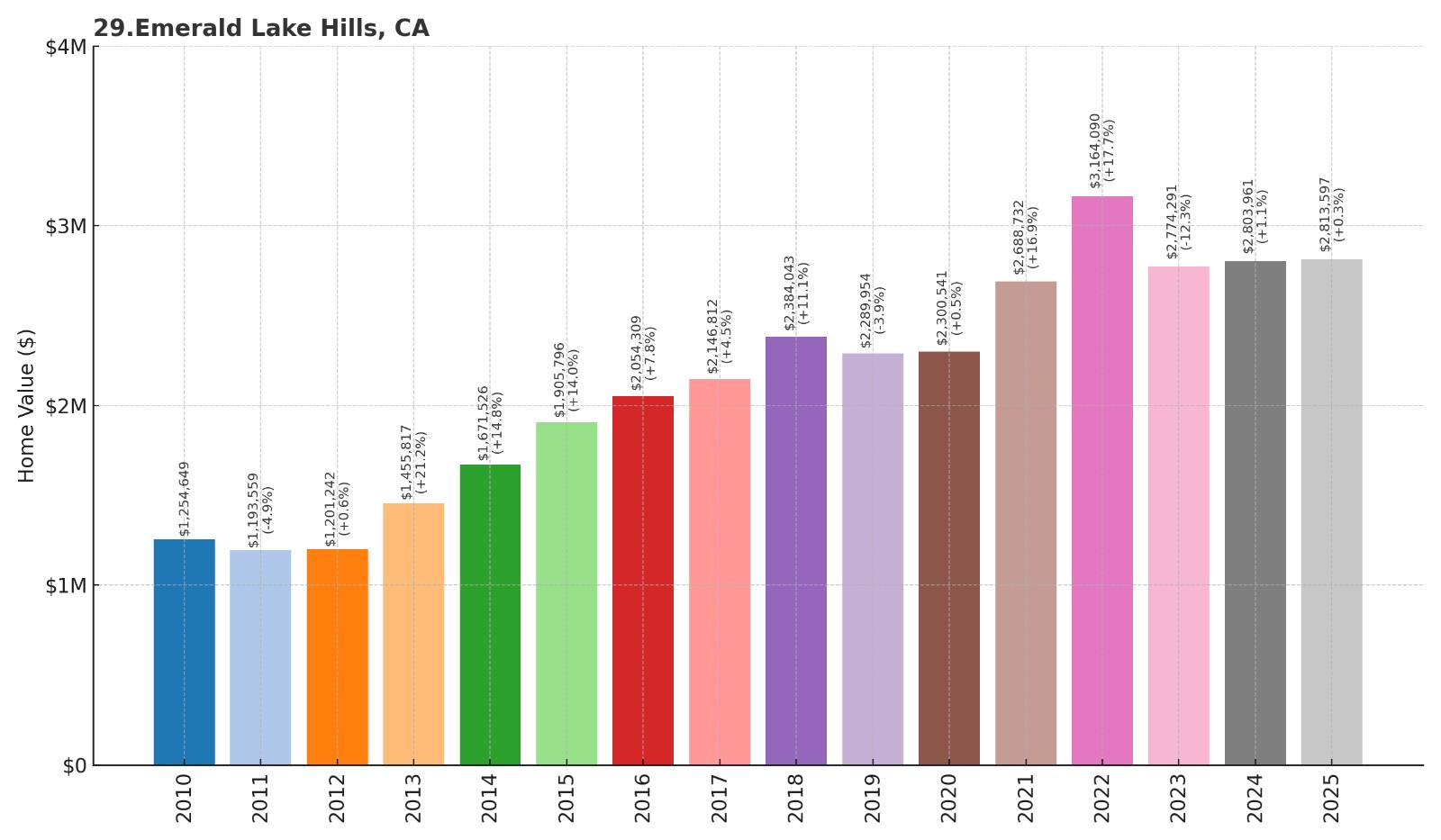
- 2010: $1,254,649
- 2011: $1,193,559
- 2012: $1,201,242
- 2013: $1,455,817
- 2014: $1,671,526
- 2015: $1,905,796
- 2016: $2,054,309
- 2017: $2,146,812
- 2018: $2,384,043
- 2019: $2,289,954
- 2020: $2,300,541
- 2021: $2,688,732
- 2022: $3,164,090
- 2023: $2,774,291
- 2024: $2,803,961
- 2025: $2,813,597
Emerald Lake Hills has doubled in value since 2010, reaching $2.8 million by 2025 despite some volatility in recent years. The community peaked at over $3.1 million in 2022 before settling into a more moderate range. This San Mateo County enclave has shown consistent appeal to tech executives seeking privacy and natural beauty within commuting distance of Silicon Valley.
Why Emerald Lake Hills?
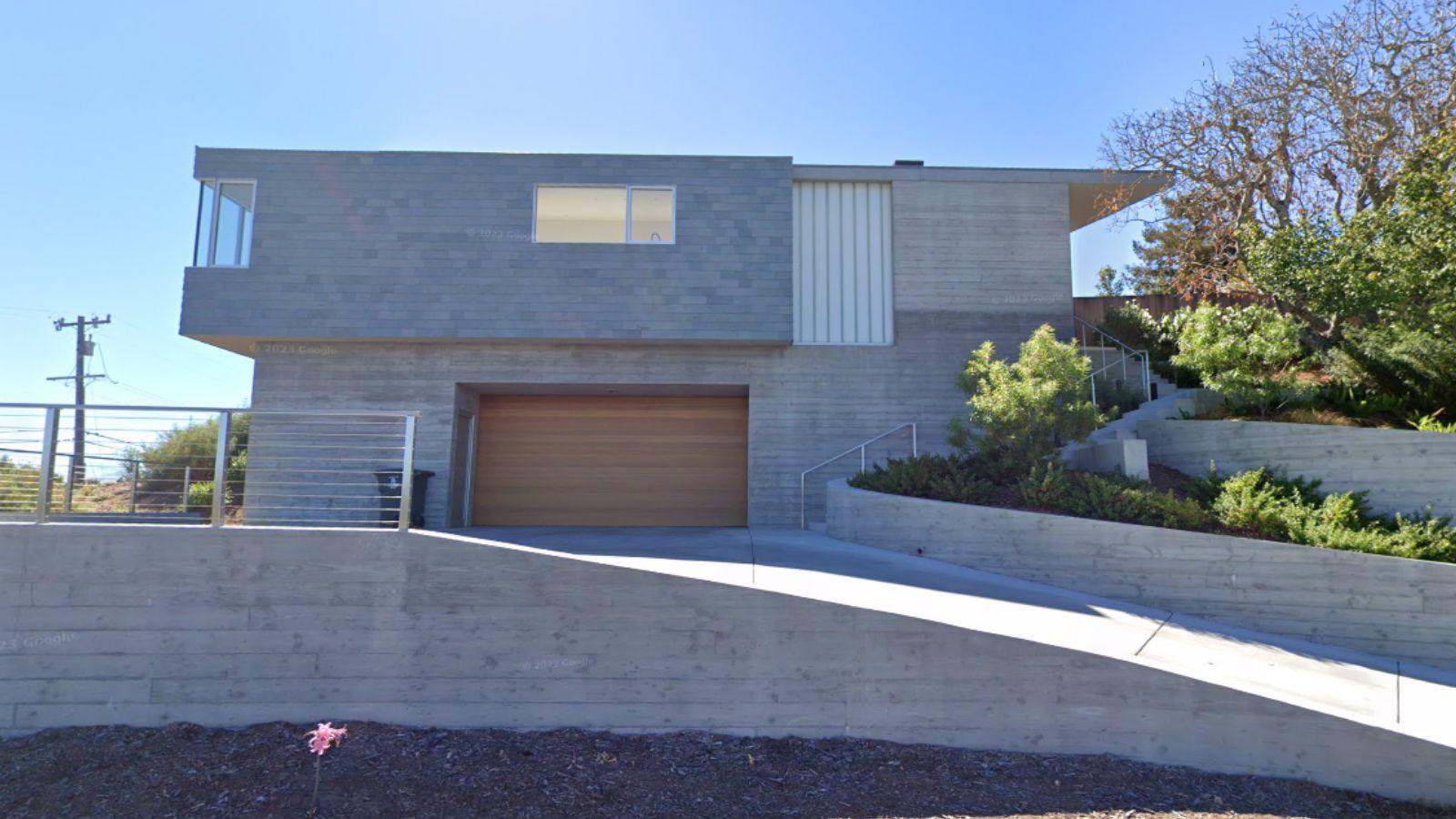
Why are people willing to pay so much to live here? What’s special about it?
Emerald Lake Hills offers a rare combination of rural tranquility and Silicon Valley accessibility that appeals to tech executives and venture capitalists. The community features large, custom homes on heavily wooded lots with private lakes and hiking trails throughout. Residents value the area’s complete lack of commercial development and its carefully maintained country atmosphere just minutes from Highway 280.
The neighborhood’s exclusivity comes from its limited number of homes and strict architectural review processes that maintain property values. Many lots span multiple acres, providing privacy that’s impossible to find in denser Peninsula communities. The area’s natural beauty, combined with excellent schools and low crime rates, justifies premium pricing for buyers seeking a retreat-like setting.
How Emerald Lake Hills Rose to Prominence
Emerald Lake Hills developed in the 1960s as a luxury residential community designed around natural lakes and rolling hills in unincorporated San Mateo County. Early developers marketed it as a “country estate” alternative to suburban tract housing, attracting executives from San Francisco’s financial district and Peninsula technology companies. The community’s design preserved existing oak trees and natural topography, creating a park-like setting that distinguished it from neighboring developments.
As Silicon Valley expanded in the 1980s and 1990s, Emerald Lake Hills became increasingly attractive to technology entrepreneurs and venture capitalists who valued its privacy and natural setting. The community’s proximity to Sand Hill Road, home to many prestigious venture capital firms, made it particularly appealing to investment professionals. Careful stewardship by the homeowners association has maintained the area’s rural character while property values have steadily appreciated.
3 Interesting Tidbits
1. Private Lakes – The community features several small private lakes that residents can use for kayaking, fishing, and swimming, creating a resort-like atmosphere.
2. Horse Country – Many properties include stables and riding areas, maintaining the community’s rural heritage despite its proximity to major tech centers.
3. Wildlife Sanctuary – The heavily wooded environment supports diverse wildlife including deer, wild turkeys, and various bird species, creating a natural sanctuary within the urbanized Peninsula.
28. Del Monte Forest – 108% Home Price Increase Since 2010
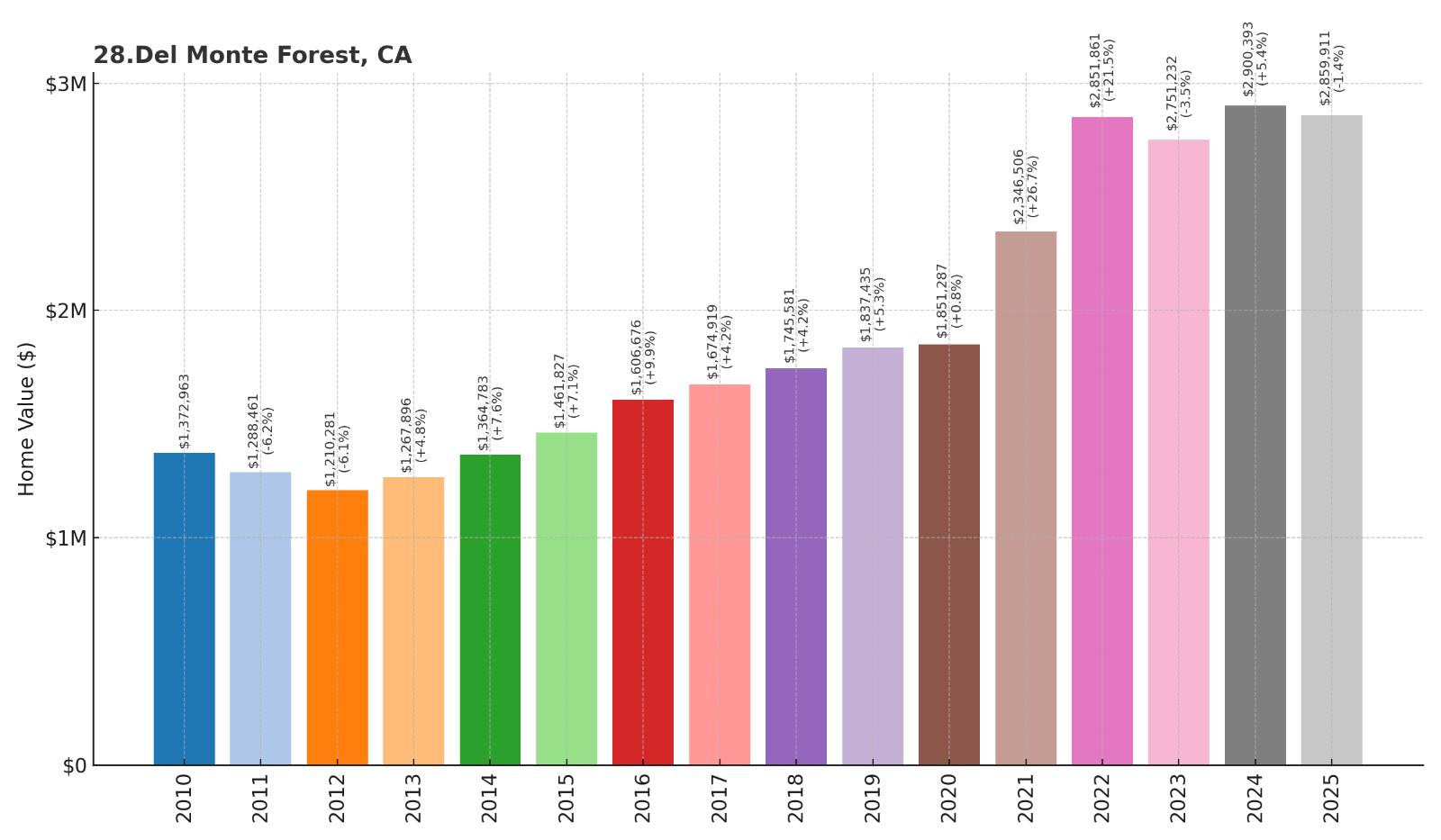
- 2010: $1,372,963
- 2011: $1,288,461
- 2012: $1,210,281
- 2013: $1,267,896
- 2014: $1,364,783
- 2015: $1,461,827
- 2016: $1,606,676
- 2017: $1,674,919
- 2018: $1,745,581
- 2019: $1,837,435
- 2020: $1,851,287
- 2021: $2,346,506
- 2022: $2,851,861
- 2023: $2,751,232
- 2024: $2,900,393
- 2025: $2,859,911
Del Monte Forest has more than doubled in value since 2010, climbing steadily to $2.9 million by 2025. The community experienced significant acceleration during the pandemic years, jumping from $1.8 million to nearly $2.9 million in just four years. This Monterey Peninsula location remains one of California’s most prestigious coastal addresses, combining luxury golf courses with dramatic Pacific coastline.
Why Del Monte Forest?
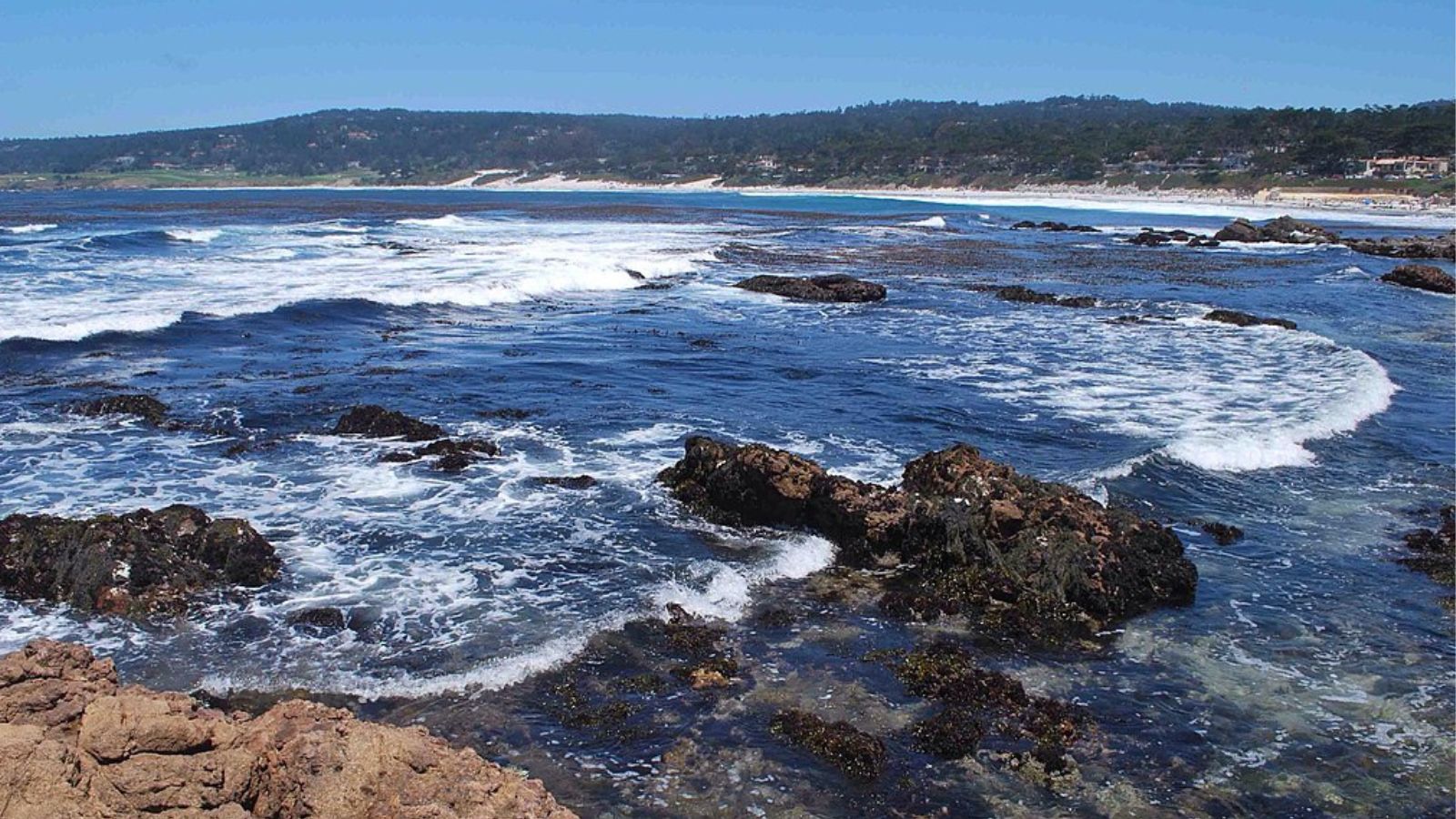
Why are people willing to pay so much to live here? What’s special about it?
Del Monte Forest offers unparalleled access to world-class golf courses including Pebble Beach and Spyglass Hill, making it a golfer’s paradise. The community sits on some of California’s most dramatic coastline, with homes featuring direct ocean access and views of Carmel Bay. Residents enjoy a resort-like lifestyle with private beaches, hiking trails, and exclusive club memberships that create a sense of permanent vacation.
The area’s exclusivity stems from its limited development within the forest preserve and its association with prestigious golf tournaments and luxury resorts. Property owners gain access to amenities typically reserved for resort guests, including private dining, spa services, and concierge assistance. The combination of natural beauty, recreational opportunities, and luxury services creates a unique lifestyle that justifies premium pricing.
How Del Monte Forest Rose to Prominence
Del Monte Forest originated in the late 1800s when the Pacific Improvement Company, a subsidiary of the Southern Pacific Railroad, developed it as a luxury resort destination for wealthy San Francisco families. The company built the famous Hotel Del Monte and created recreational amenities including golf courses and equestrian facilities. Early visitors included railroad barons, mining magnates, and entertainment celebrities who were drawn to the area’s natural beauty and exclusive atmosphere.
The development of Pebble Beach Golf Links in 1919 elevated the area’s profile as a luxury destination and residential community. As California’s economy grew in the mid-20th century, more business leaders and celebrities established permanent residences within the forest. The community’s careful balance of development and conservation has maintained its appeal to successive generations of wealthy buyers seeking a premium coastal lifestyle.
3 Interesting Tidbits
1. Golf Legacy – The community is home to five world-renowned golf courses, including Pebble Beach Golf Links, which regularly hosts major PGA tournaments.
2. Seal Sanctuary – The coastline provides habitat for harbor seals and sea otters, with several protected coves where marine wildlife can be observed year-round.
3. Monterey Cypress – The forest features ancient Monterey cypress trees found nowhere else in the world, some over 250 years old and protected by conservation easements.
27. Tiburon – 108% Home Price Increase Since 2010

- 2010: $1,374,959
- 2011: $1,289,263
- 2012: $1,402,724
- 2013: $1,618,908
- 2014: $1,796,243
- 2015: $2,019,623
- 2016: $2,122,416
- 2017: $2,147,975
- 2018: $2,316,890
- 2019: $2,305,483
- 2020: $2,297,382
- 2021: $2,785,375
- 2022: $3,214,620
- 2023: $2,944,333
- 2024: $2,978,783
- 2025: $2,860,604
Tiburon has doubled in value since 2010, reaching $2.9 million despite some recent moderation from its 2022 peak above $3.2 million. This Marin County peninsula community has shown remarkable consistency over 15 years, with steady appreciation punctuated by significant gains during the pandemic. The town’s waterfront location and ferry connections to San Francisco continue to drive demand among affluent buyers.
Why Tiburon?
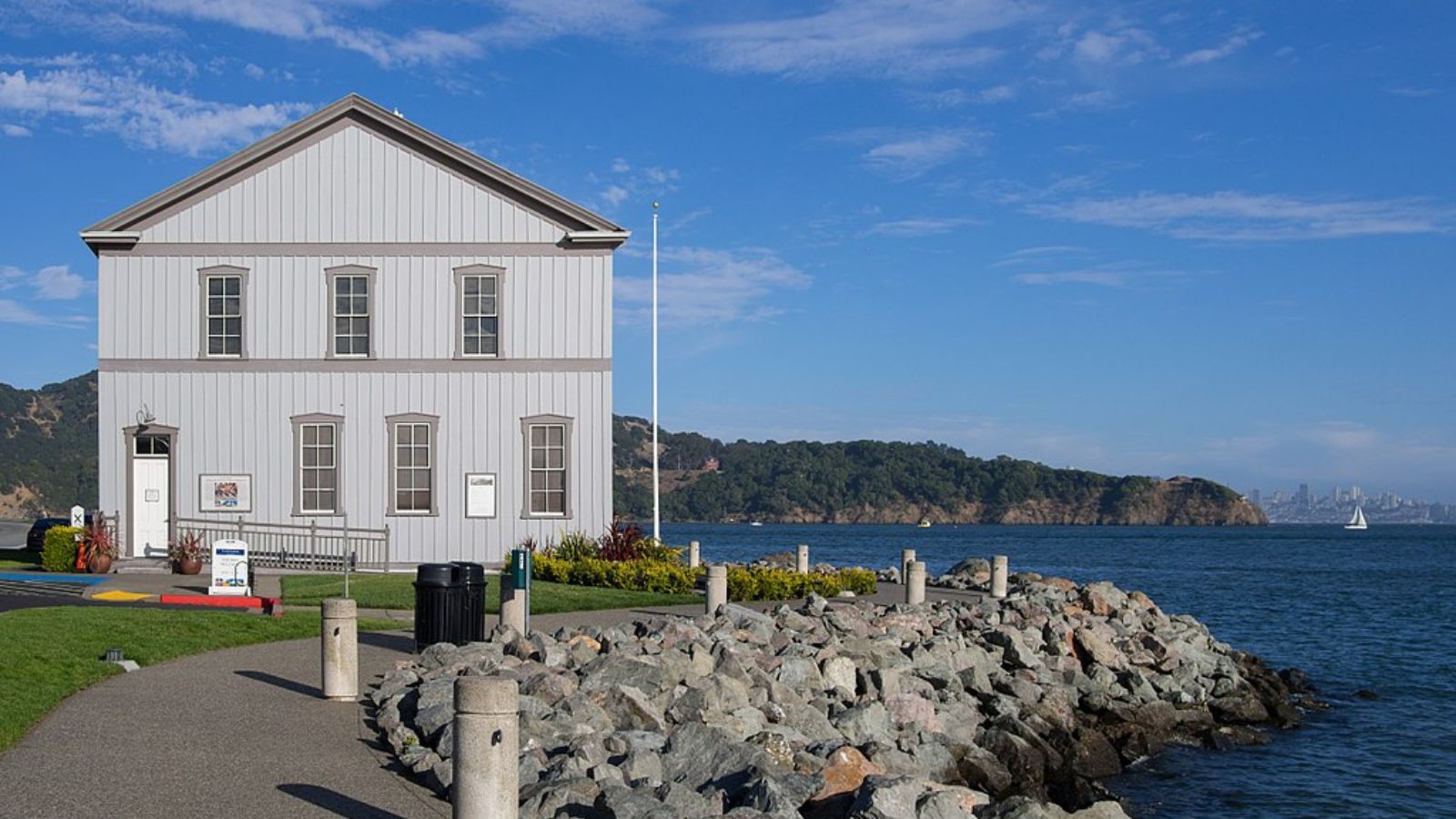
Why are people willing to pay so much to live here? What’s special about it?
Tiburon’s peninsula location provides stunning 360-degree views of San Francisco Bay, the Golden Gate Bridge, and Mount Tamalpais. The community offers a relaxed, small-town atmosphere while maintaining easy ferry access to downtown San Francisco for commuters. Residents enjoy waterfront dining, sailing, and hiking while living in architecturally distinctive homes that take advantage of the dramatic natural setting.
The town’s exclusivity comes from its limited landmass and strict development controls that preserve its character and views. Many homes feature private docks and beach access, creating a resort-like lifestyle for residents. The combination of natural beauty, recreational opportunities, and proximity to San Francisco jobs makes Tiburon particularly appealing to finance executives and technology leaders.
How Tiburon Rose to Prominence
Tiburon began as a railroad terminus in the 1880s, serving ferries that transported passengers and freight between Marin County and San Francisco. The town’s deep-water harbor and scenic location attracted wealthy San Francisco families who built summer homes on the peninsula. Early development was carefully planned to take advantage of water views and natural topography, establishing architectural standards that continue today.
The completion of the Golden Gate Bridge in 1937 and subsequent ferry service improvements made Tiburon increasingly accessible to San Francisco workers. Post-war prosperity brought new residents seeking waterfront living within commuting distance of the city. The town’s incorporation in 1964 allowed residents to maintain local control over development, preserving the small-town character that continues to attract affluent buyers.
3 Interesting Tidbits
1. Ferry Heritage – The historic ferry service to San Francisco continues today, providing a scenic commute option that many residents prefer to driving across the Golden Gate Bridge.
2. Ark Row – Historic houseboats from the early 1900s were converted into charming waterfront shops and restaurants, creating the town’s distinctive commercial district.
3. Ring Mountain – This open space preserve within Tiburon protects rare native plants and provides hiking trails with panoramic Bay Area views.
26. Summerland – 115% Home Price Increase Since 2010
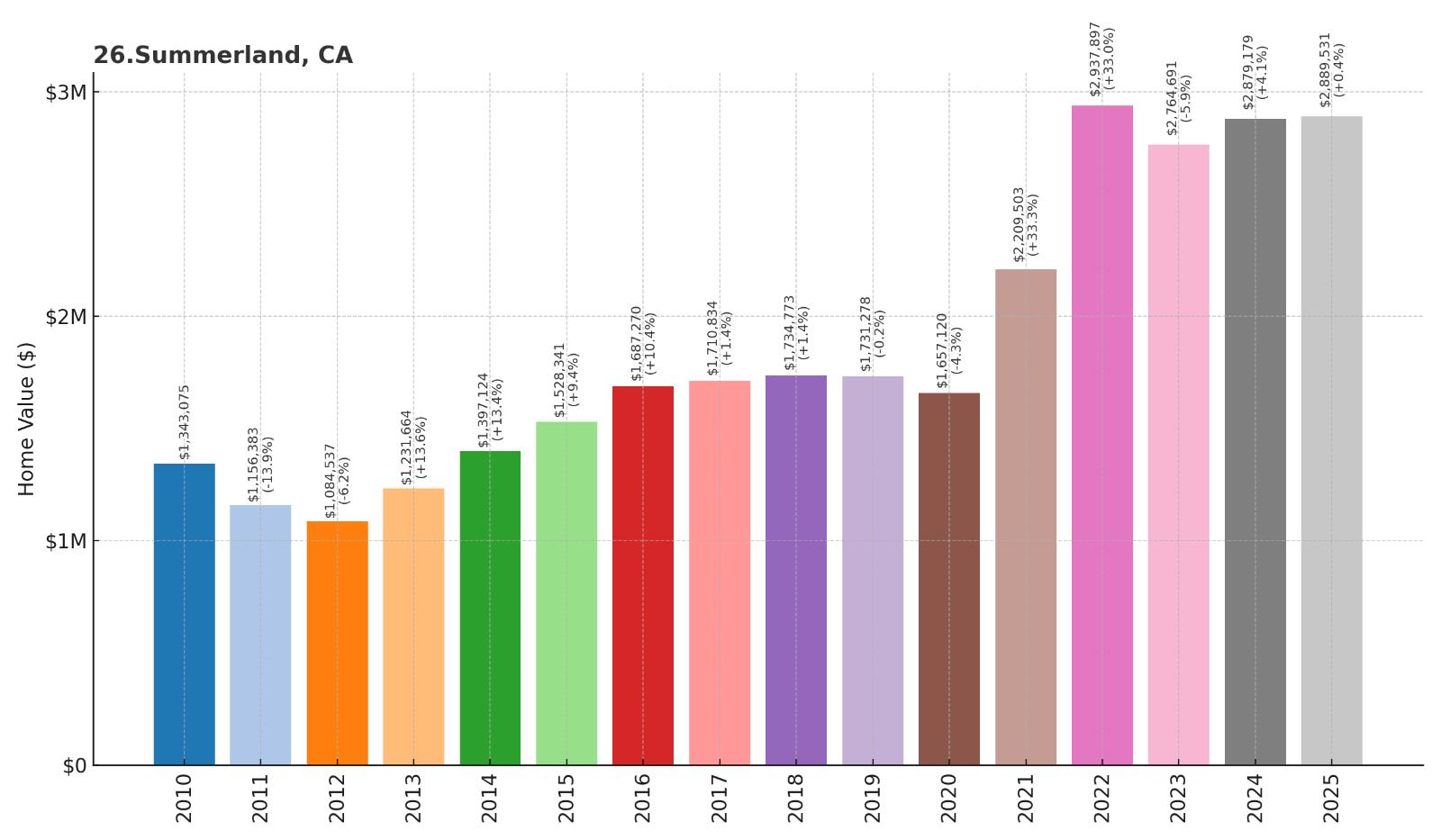
- 2010: $1,343,075
- 2011: $1,156,383
- 2012: $1,084,537
- 2013: $1,231,664
- 2014: $1,397,124
- 2015: $1,528,341
- 2016: $1,687,270
- 2017: $1,710,834
- 2018: $1,734,773
- 2019: $1,731,278
- 2020: $1,657,120
- 2021: $2,209,503
- 2022: $2,937,897
- 2023: $2,764,691
- 2024: $2,879,179
- 2025: $2,889,531
Summerland has more than doubled in value since 2010, experiencing dramatic growth from $1.7 million to nearly $2.9 million in recent years. The community saw its biggest surge during the pandemic, jumping over $1.2 million between 2020 and 2022. This Santa Barbara County coastal enclave has stabilized at nearly $2.9 million, reflecting continued demand for beachfront living in one of California’s most scenic areas.
Why Summerland?

Why are people willing to pay so much to live here? What’s special about it?
Summerland offers direct beach access and ocean views in a intimate community setting between Santa Barbara and Carpinteria. The unincorporated area features charming beach cottages and modern coastal homes with a relaxed, artistic atmosphere that attracts creative professionals and retirees. Residents enjoy year-round mild weather, excellent surfing, and a small-town feel while remaining close to Santa Barbara’s cultural amenities.
The community’s appeal stems from its authentic beach town character and limited development along a pristine stretch of coastline. Unlike larger beach cities, Summerland maintains a quiet, residential atmosphere with walkable access to cafes, antique shops, and art galleries. The area’s natural beauty and artistic heritage create a unique lifestyle that commands premium prices from buyers seeking coastal authenticity.
How Summerland Rose to Prominence
Summerland was founded in 1889 by H.L. Williams, a spiritualist who envisioned it as a seaside resort community for followers of the spiritualist movement. The town attracted visitors seeking both spiritual enlightenment and coastal recreation, with the original hotel and cottages designed to accommodate summer visitors from across California. Early residents included artists, writers, and spiritual seekers who were drawn to the area’s natural beauty and alternative lifestyle.
The discovery of oil in the early 1900s brought temporary industrial activity, but the community returned to its residential character as the oil boom ended. Post-World War II development brought new residents seeking a quiet coastal lifestyle away from larger cities. The area’s association with artistic and spiritual movements has continued to attract creative professionals and affluent retirees who value its unique character and scenic setting.
3 Interesting Tidbits
1. Spiritualist Origins – The town was originally founded as a spiritualist colony, and some original Victorian cottages built for spiritual retreats still exist today.
2. Offshore Oil – Historic oil platforms visible from the beach are remnants of early 20th-century oil drilling that helped fund the community’s development.
3. Artist Haven – The community has long attracted artists and craftspeople, with several galleries and studios operating in converted beach cottages and historic buildings.
25. Laguna Beach – 128% Home Price Increase Since 2010

- 2010: $1,285,917
- 2011: $1,193,555
- 2012: $1,160,507
- 2013: $1,371,506
- 2014: $1,543,283
- 2015: $1,650,253
- 2016: $1,653,907
- 2017: $1,775,424
- 2018: $1,925,812
- 2019: $1,864,311
- 2020: $1,879,180
- 2021: $2,298,124
- 2022: $2,834,521
- 2023: $2,761,368
- 2024: $2,948,371
- 2025: $2,926,886
Laguna Beach has shown strong growth over 15 years, more than doubling from $1.3 million to nearly $3 million by 2025. The community experienced steady appreciation through the 2010s followed by significant acceleration during the pandemic years. Recent stabilization around $2.9 million reflects continued appeal of this Orange County coastal arts community among affluent buyers seeking beachfront living with cultural amenities.
Why Laguna Beach?
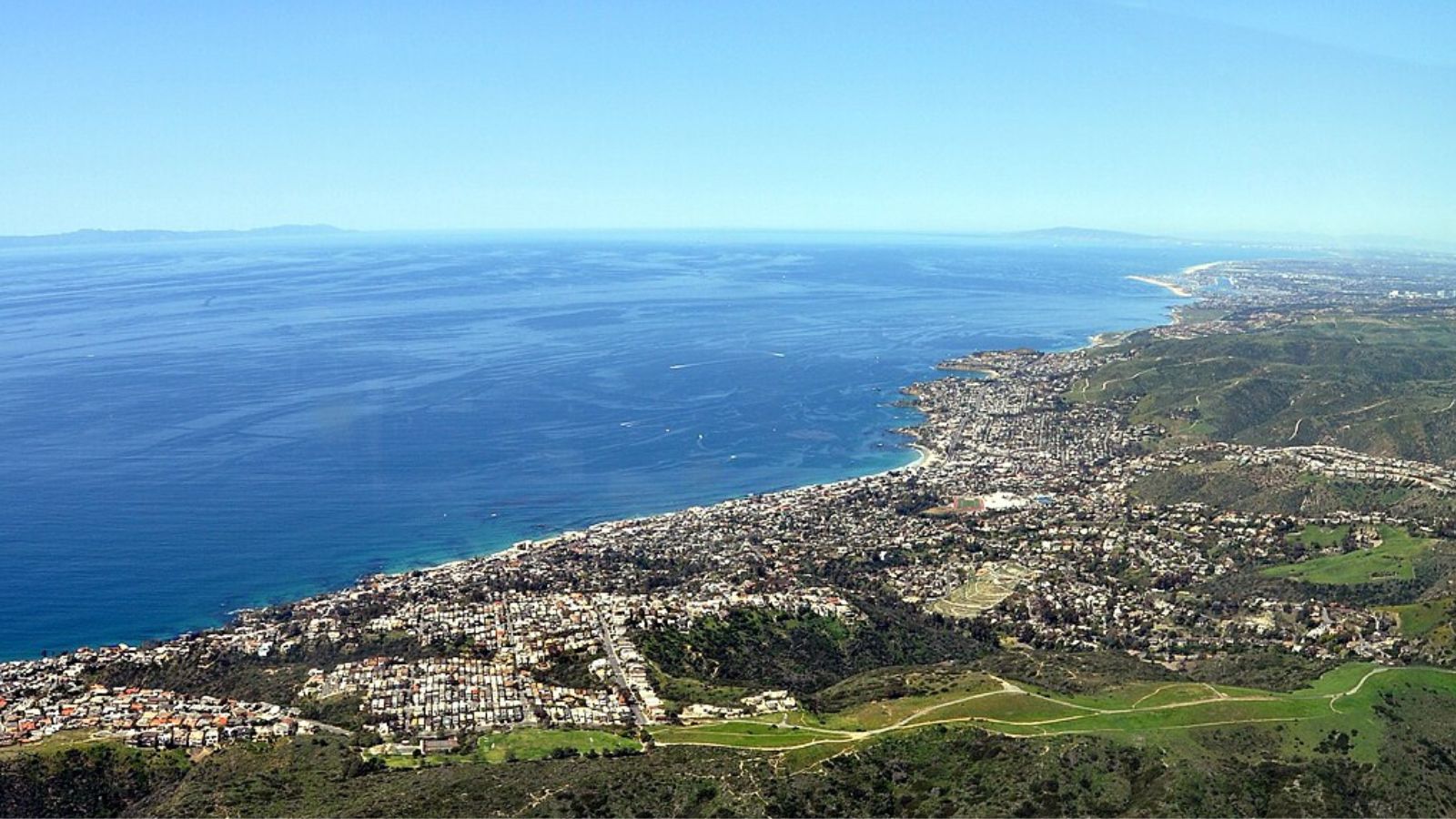
Why are people willing to pay so much to live here? What’s special about it?
Laguna Beach combines stunning Pacific coastline with a thriving arts scene that creates a sophisticated small-town atmosphere. The community features numerous art galleries, festivals, and cultural events alongside pristine beaches and dramatic coastal cliffs. Residents enjoy year-round outdoor activities including surfing, hiking, and beach walking while living in architecturally diverse homes that reflect the area’s creative heritage.
The town’s exclusivity comes from its natural boundaries—hills and ocean—that limit development and preserve its intimate scale. Many homes feature ocean views and private beach access, while the downtown area offers walkable access to restaurants, galleries, and shops. The combination of natural beauty, cultural sophistication, and small-town charm appeals to artists, executives, and retirees willing to pay premium prices for coastal living.
How Laguna Beach Rose to Prominence
Laguna Beach began as an artists’ colony in the early 1900s when painters discovered its dramatic coastline and favorable light conditions. The community attracted plein air artists who established studios and galleries, creating a bohemian atmosphere that distinguished it from other coastal towns. Early residents included both artists and wealthy patrons who supported the growing arts scene and built vacation homes in the scenic canyons.
The establishment of the Laguna Beach Art Association in 1918 and subsequent art festivals cemented the town’s reputation as a cultural destination. Post-war development brought new residents while the community maintained its artistic character through careful planning and historic preservation. The town’s incorporation in 1927 allowed residents to control growth and maintain the small-scale character that continues to attract affluent buyers seeking an authentic beach town experience.
3 Interesting Tidbits
1. Artist Paradise – The city hosts over 100 art galleries and studios, more per capita than any other California city, maintaining its century-long tradition as an artists’ colony.
2. Pageant Heritage – The annual Pageant of the Masters features live models recreating famous artworks, a tradition that began in 1933 and continues to draw visitors worldwide.
3. Natural Sanctuary – Crystal Cove State Park borders the city, providing over 3,000 acres of wilderness and pristine coastline protected from development.
24. Cupertino – 224% Home Price Increase Since 2010

- 2010: $919,727
- 2011: $889,184
- 2012: $974,735
- 2013: $1,181,522
- 2014: $1,386,972
- 2015: $1,661,217
- 2016: $1,700,990
- 2017: $1,759,045
- 2018: $2,187,556
- 2019: $2,028,421
- 2020: $2,022,596
- 2021: $2,405,512
- 2022: $2,880,936
- 2023: $2,561,628
- 2024: $2,923,662
- 2025: $2,981,797
Cupertino has shown the most dramatic growth on this list, more than tripling from $920,000 in 2010 to nearly $3 million by 2025. The community experienced steady acceleration through the 2010s as Apple’s expansion drove demand for nearby housing. Despite some volatility in recent years, Cupertino remains one of Silicon Valley’s most sought-after residential addresses for technology professionals and their families.
Why Cupertino?
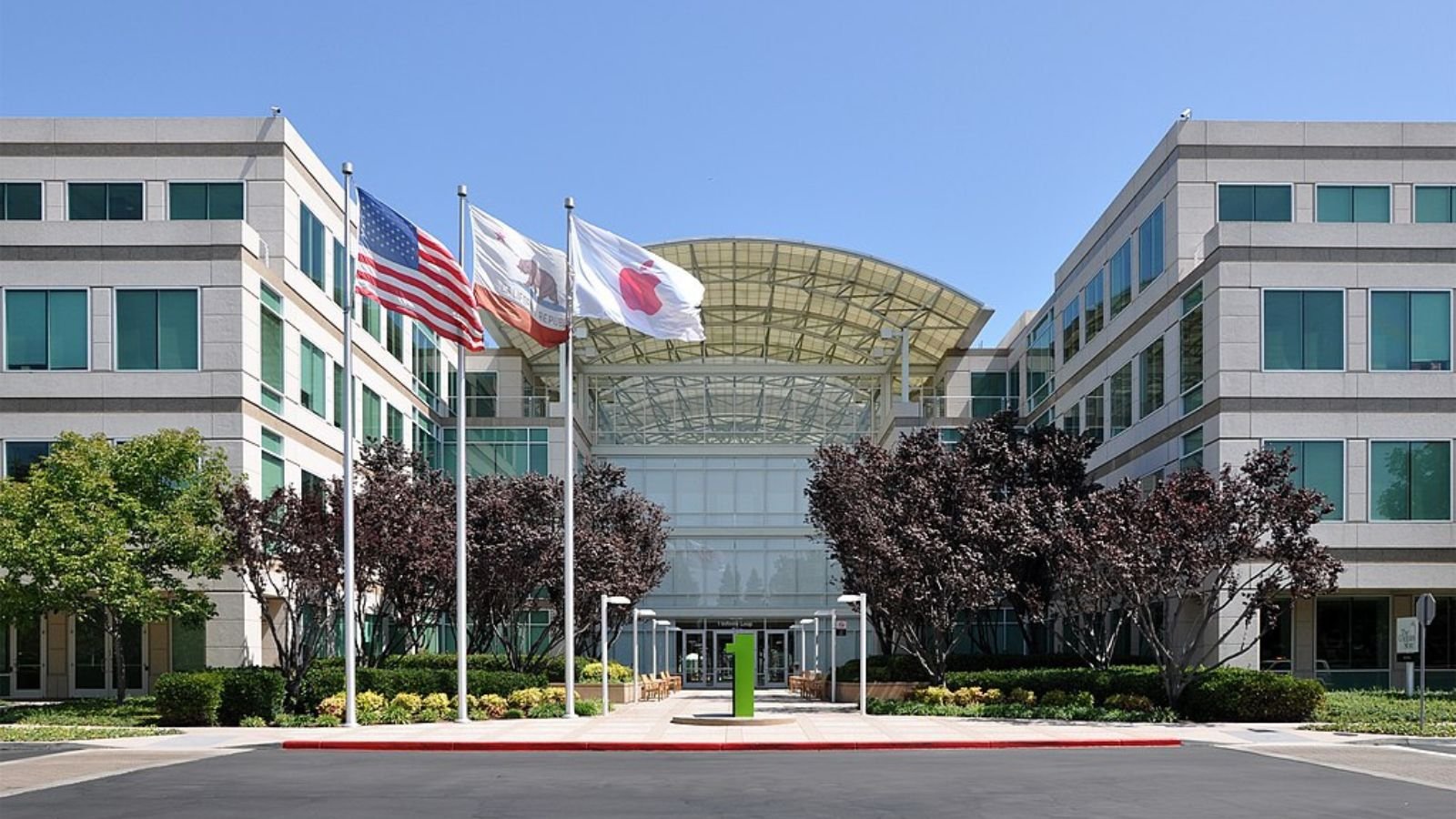
Why are people willing to pay so much to live here? What’s special about it?
Cupertino attracts families with its exceptional public schools, which consistently rank among California’s best and feed into top universities. The city serves as Apple’s headquarters, creating a concentration of high-tech wealth and innovation that drives premium housing demand. Residents enjoy a family-friendly suburban environment with excellent parks, libraries, and community centers while maintaining easy access to Silicon Valley employment opportunities.
The community’s appeal stems from its combination of educational excellence and technology industry proximity that creates exceptional career and investment opportunities. Many families choose Cupertino specifically for its schools, viewing high housing costs as an investment in their children’s futures. The area’s safety, diversity, and suburban amenities provide a stable environment for raising families in the heart of the world’s technology capital.
How Cupertino Rose to Prominence
Cupertino originated as an agricultural community in the Santa Clara Valley, known for its orchards and small-town character through the mid-20th century. The transformation began in the 1960s and 1970s as technology companies located in the area, with early computer firms choosing Cupertino for its educated workforce and proximity to Stanford University. The establishment of excellent public schools attracted technology professionals who valued education and suburban living.
Apple’s founding in nearby garages in 1976 and subsequent growth into the world’s most valuable company cemented Cupertino’s status as a technology center. The opening of Apple Park in 2017 brought thousands of high-paying jobs directly to the city, intensifying competition for local housing. The community’s careful planning and investment in schools and infrastructure has maintained its appeal to successive generations of technology workers and their families.
3 Interesting Tidbits
1. Apple Headquarters – The city is home to Apple Park, the company’s $5 billion headquarters featuring the world’s largest glass panels and on-site theater named after Steve Jobs.
2. School Excellence – Cupertino High School consistently ranks in the top 1% of California schools, with graduates attending prestigious universities at exceptional rates.
3. Tech History – The city was named after Spanish explorer Juan Bautista de Anza’s scout, who camped here in 1776, long before it became the epicenter of personal computing innovation.
23. Stinson Beach – 199% Home Price Increase Since 2010
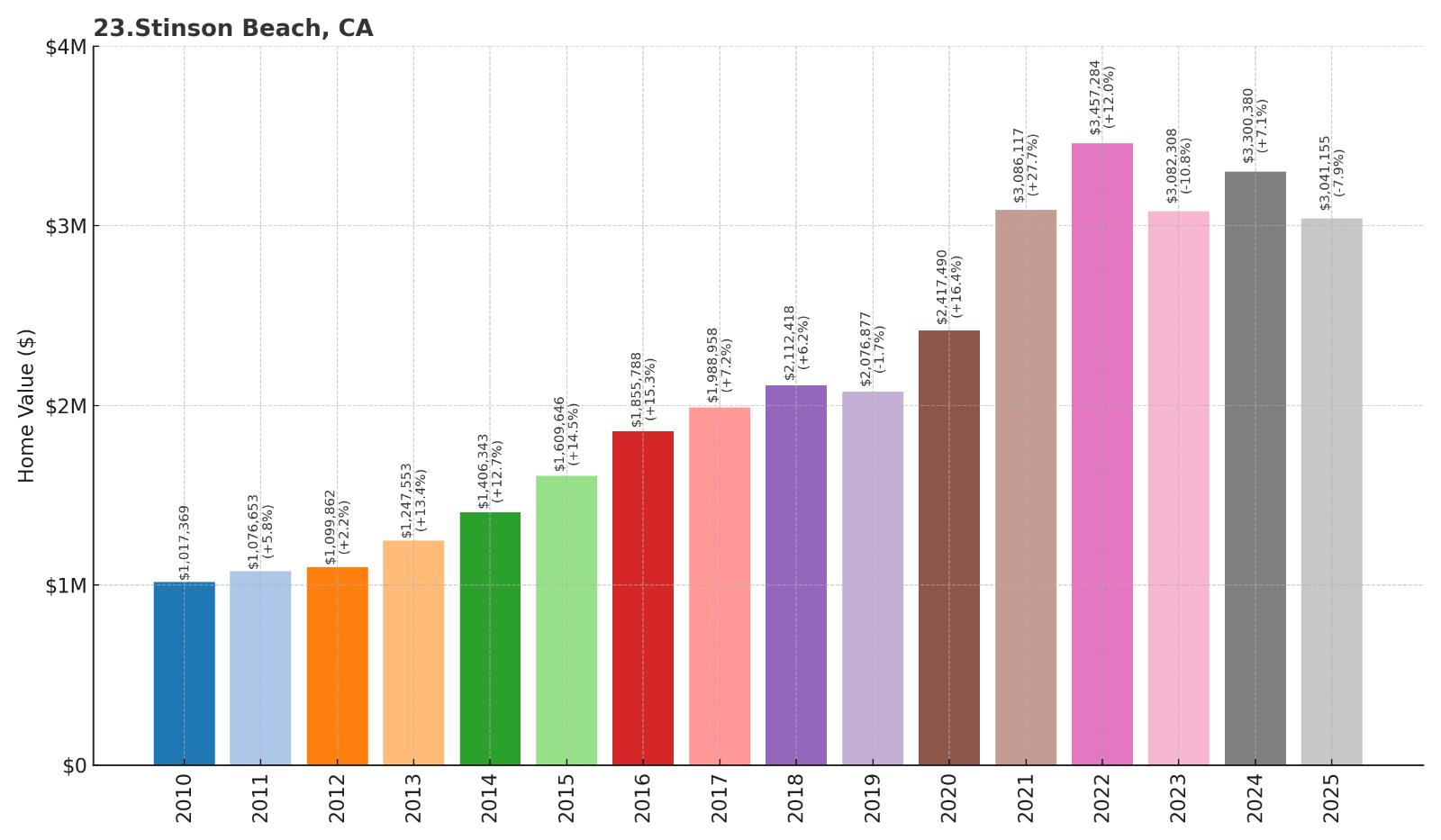
- 2010: $1,017,369
- 2011: $1,076,653
- 2012: $1,099,862
- 2013: $1,247,553
- 2014: $1,406,343
- 2015: $1,609,646
- 2016: $1,855,788
- 2017: $1,988,958
- 2018: $2,112,418
- 2019: $2,076,877
- 2020: $2,417,490
- 2021: $3,086,117
- 2022: $3,457,284
- 2023: $3,082,308
- 2024: $3,300,380
- 2025: $3,041,155
Stinson Beach has nearly tripled in value since 2010, reaching over $3 million despite recent price fluctuations. The community saw exceptional growth during the pandemic years, jumping from $2.4 million to over $3.4 million in just two years. This Marin County beach town represents one of California’s most dramatic coastal real estate markets, combining remote natural beauty with proximity to San Francisco.
Why Stinson Beach?
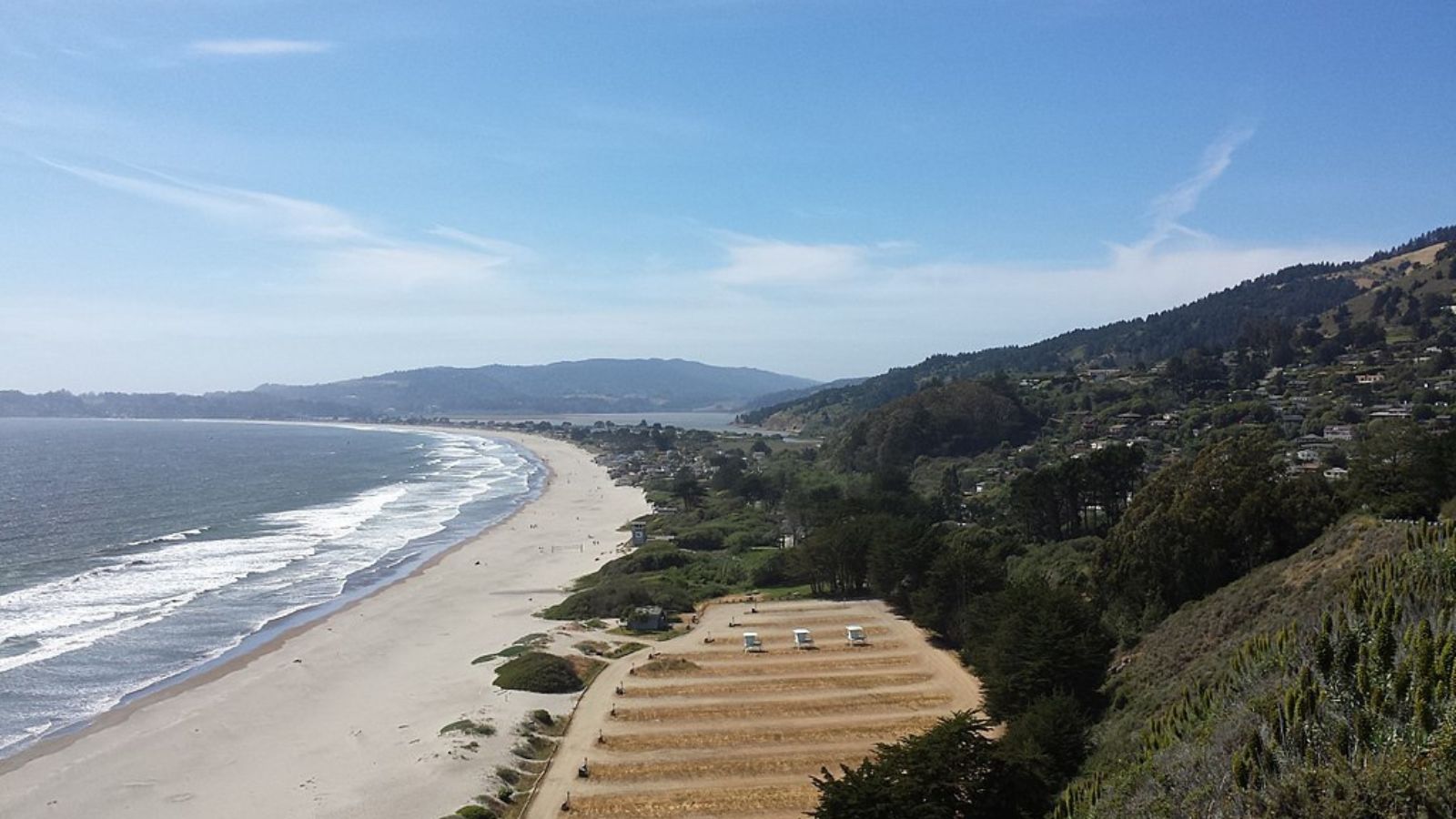
Why are people willing to pay so much to live here? What’s special about it?
Stinson Beach offers a rare combination of wide sandy beaches and small-town isolation just an hour from downtown San Francisco. The community attracts buyers seeking a retreat-like atmosphere with direct beach access and stunning coastal hiking trails in adjacent Mount Tamalpais State Park. Residents enjoy a laid-back lifestyle with excellent surfing, organic local restaurants, and an artistic community that values environmental preservation and coastal living.
The area’s exclusivity stems from its geographic isolation and limited housing stock in a narrow coastal valley between mountains and ocean. Many homes feature dramatic ocean views and private beach access that’s impossible to find elsewhere in the Bay Area. The combination of natural beauty, recreational opportunities, and proximity to San Francisco creates unique value for buyers willing to pay premium prices for coastal authenticity.
How Stinson Beach Rose to Prominence
Stinson Beach developed as a weekend retreat destination in the early 1900s when the railroad brought San Francisco families seeking coastal recreation. The community remained largely seasonal until the 1960s and 1970s when counterculture movements discovered its natural beauty and relaxed atmosphere. Artists, musicians, and writers established permanent residences, creating a bohemian community that valued environmental protection and alternative lifestyles.
The establishment of Golden Gate National Recreation Area in 1972 protected surrounding lands from development while increasing the area’s profile as a natural destination. Technology boom wealth in the 1990s and 2000s brought new residents who could afford to live in remote locations while maintaining Bay Area career connections. The community’s careful balance of development and conservation has preserved its character while property values have appreciated dramatically.
3 Interesting Tidbits
1. Shark Research – The nearby waters are part of the “Red Triangle,” a prime great white shark habitat where marine biologists conduct ongoing research at the nearby Point Reyes Marine Station.
2. Hippie Heritage – The town was a gathering place for 1960s counterculture, with many original residents establishing organic farms and alternative communities that continue today.
3. Fire Danger – The community is surrounded by wildfire-prone chaparral and grasslands, requiring careful emergency planning and specialized insurance for residents.
22. Manhattan Beach – 143% Home Price Increase Since 2010
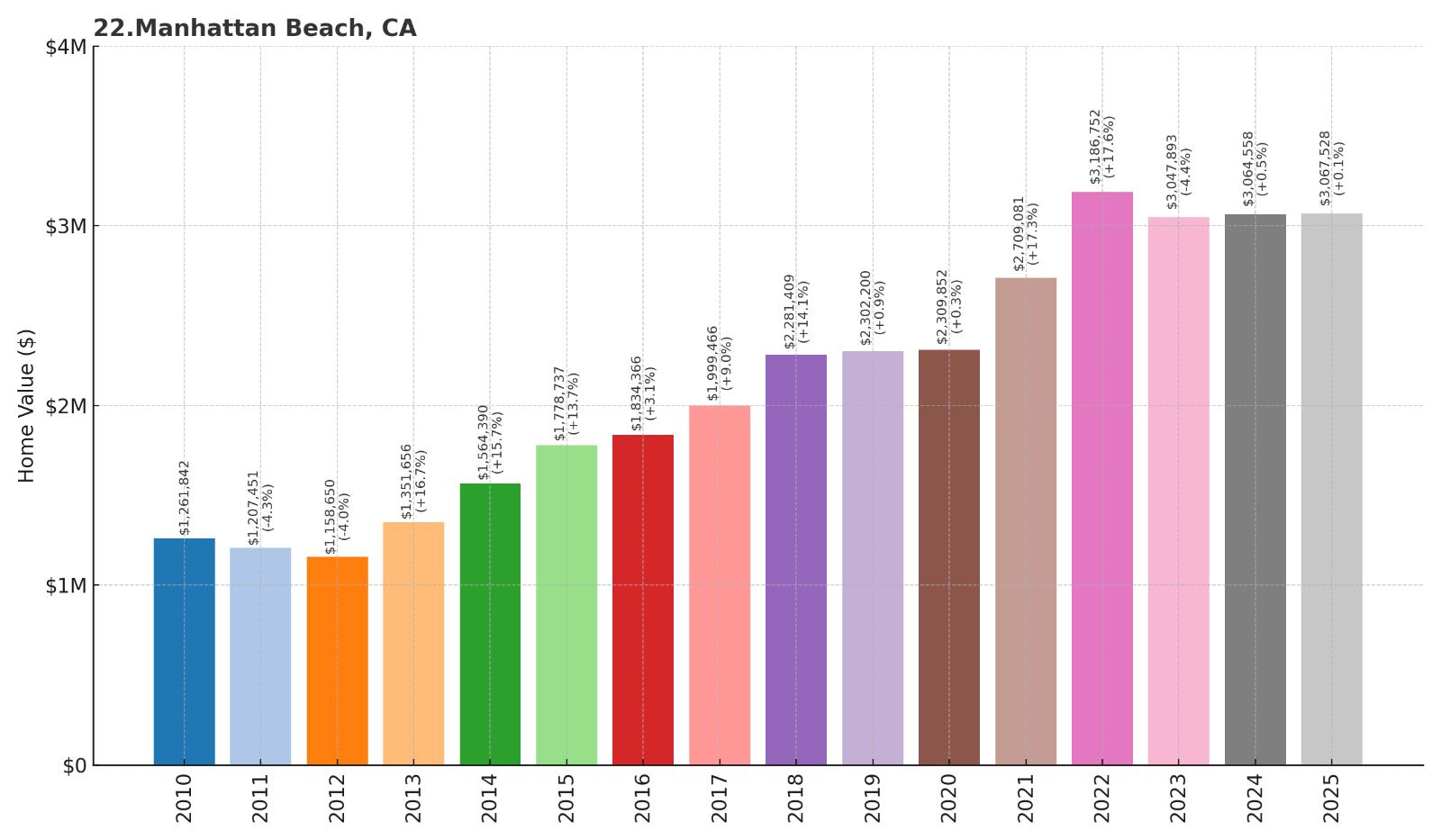
- 2010: $1,261,842
- 2011: $1,207,451
- 2012: $1,158,650
- 2013: $1,351,656
- 2014: $1,564,390
- 2015: $1,778,737
- 2016: $1,834,366
- 2017: $1,999,466
- 2018: $2,281,409
- 2019: $2,302,200
- 2020: $2,309,852
- 2021: $2,709,081
- 2022: $3,186,752
- 2023: $3,047,893
- 2024: $3,064,558
- 2025: $3,067,528
Manhattan Beach has shown steady growth over 15 years, more than doubling from $1.3 million to over $3 million by 2025. The community experienced consistent appreciation through the 2010s followed by significant acceleration during pandemic years. This South Bay coastal city has maintained stable pricing above $3 million, reflecting sustained demand from affluent families seeking beachfront living with excellent schools and recreational amenities.
Why Manhattan Beach?
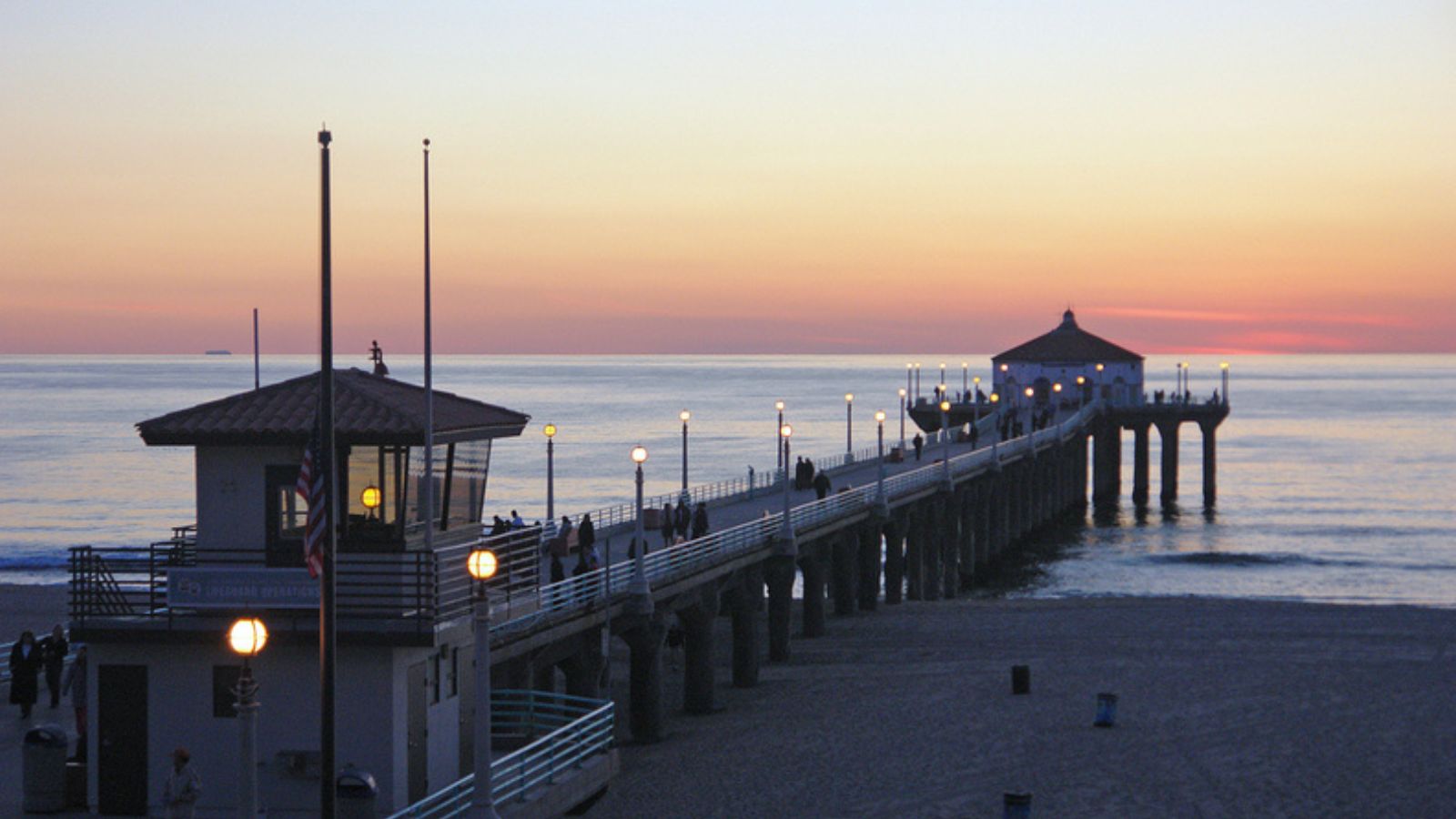
Why are people willing to pay so much to live here? What’s special about it?
Manhattan Beach offers a perfect combination of wide sandy beaches, top-rated schools, and family-friendly atmosphere that appeals to affluent professionals and athletes. The community features excellent volleyball courts, surfing, and beach activities while maintaining a safe, walkable downtown with upscale restaurants and shops. Residents enjoy year-round outdoor living with easy access to Los Angeles employment centers and entertainment.
The city’s appeal stems from its successful balance of beach town relaxation and suburban sophistication that attracts executives, athletes, and entertainment professionals. Many homes offer ocean views and beach access while the community maintains excellent public services and low crime rates. The combination of lifestyle amenities, educational quality, and beachfront location creates exceptional value for families willing to invest in coastal living.
How Manhattan Beach Rose to Prominence
Manhattan Beach was developed in 1912 as a planned beach resort community designed to attract wealthy Los Angeles families seeking coastal recreation. Early development focused on beachfront hotels and vacation homes, with the famous Manhattan Beach Pier serving as a focal point for fishing and entertainment. The community’s grid street pattern and beach-focused amenities established its character as an upscale coastal destination.
Post-World War II suburban expansion brought year-round residents who valued the area’s beaches, schools, and proximity to aerospace industry jobs. The establishment of excellent public schools and recreational facilities attracted families throughout the latter 20th century. Beach volleyball’s popularity and the city’s role in professional sports culture have enhanced its appeal to athletes and sports enthusiasts, contributing to sustained property value growth.
3 Interesting Tidbits
1. Volleyball Capital – The city is considered the birthplace of beach volleyball, with professional tournaments and training facilities that attract world-class athletes.
2. Aerospace Legacy – Many early residents worked for nearby aerospace companies including Hughes Aircraft, Northrop, and TRW, establishing the area’s connection to high-tech industries.
3. Movie Magic – The iconic pier and beachfront have appeared in countless movies and TV shows, making it one of the most recognizable beaches in popular culture.
21. Diablo – 39.9% Home Price Increase Since 2016
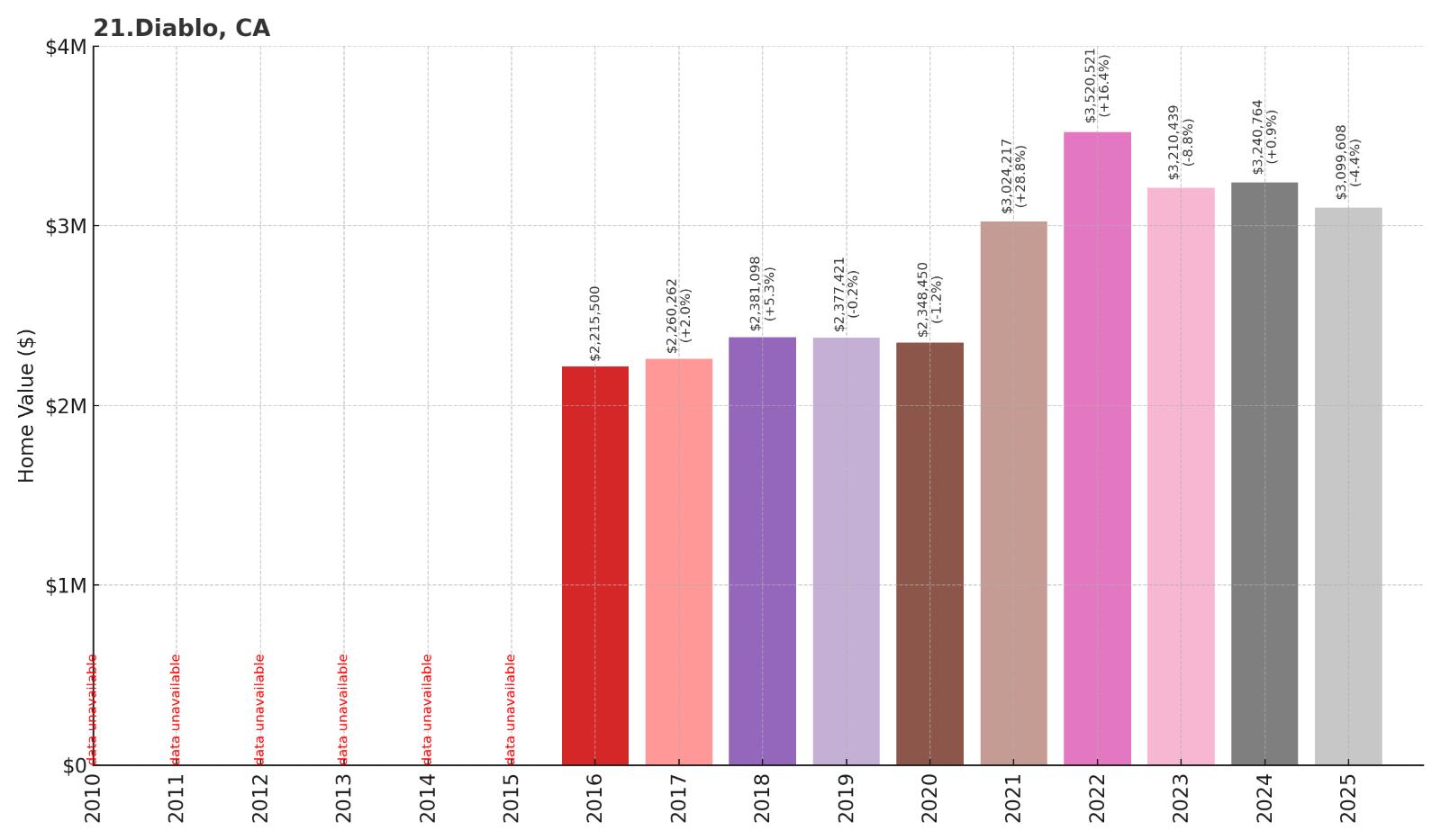
- 2010: N/A
- 2011: N/A
- 2012: N/A
- 2013: N/A
- 2014: N/A
- 2015: N/A
- 2016: $2,215,500
- 2017: $2,260,262
- 2018: $2,381,098
- 2019: $2,377,421
- 2020: $2,348,450
- 2021: $3,024,217
- 2022: $3,520,521
- 2023: $3,210,439
- 2024: $3,240,764
- 2025: $3,099,608
Diablo shows limited historical data starting from 2016, but demonstrates strong growth from $2.2 million to over $3 million by 2025. The community experienced significant appreciation during pandemic years, peaking above $3.5 million in 2022 before stabilizing around $3.1 million. This East Bay enclave represents one of California’s most exclusive gated communities, combining privacy with proximity to San Francisco Bay Area employment centers.
Why Diablo?
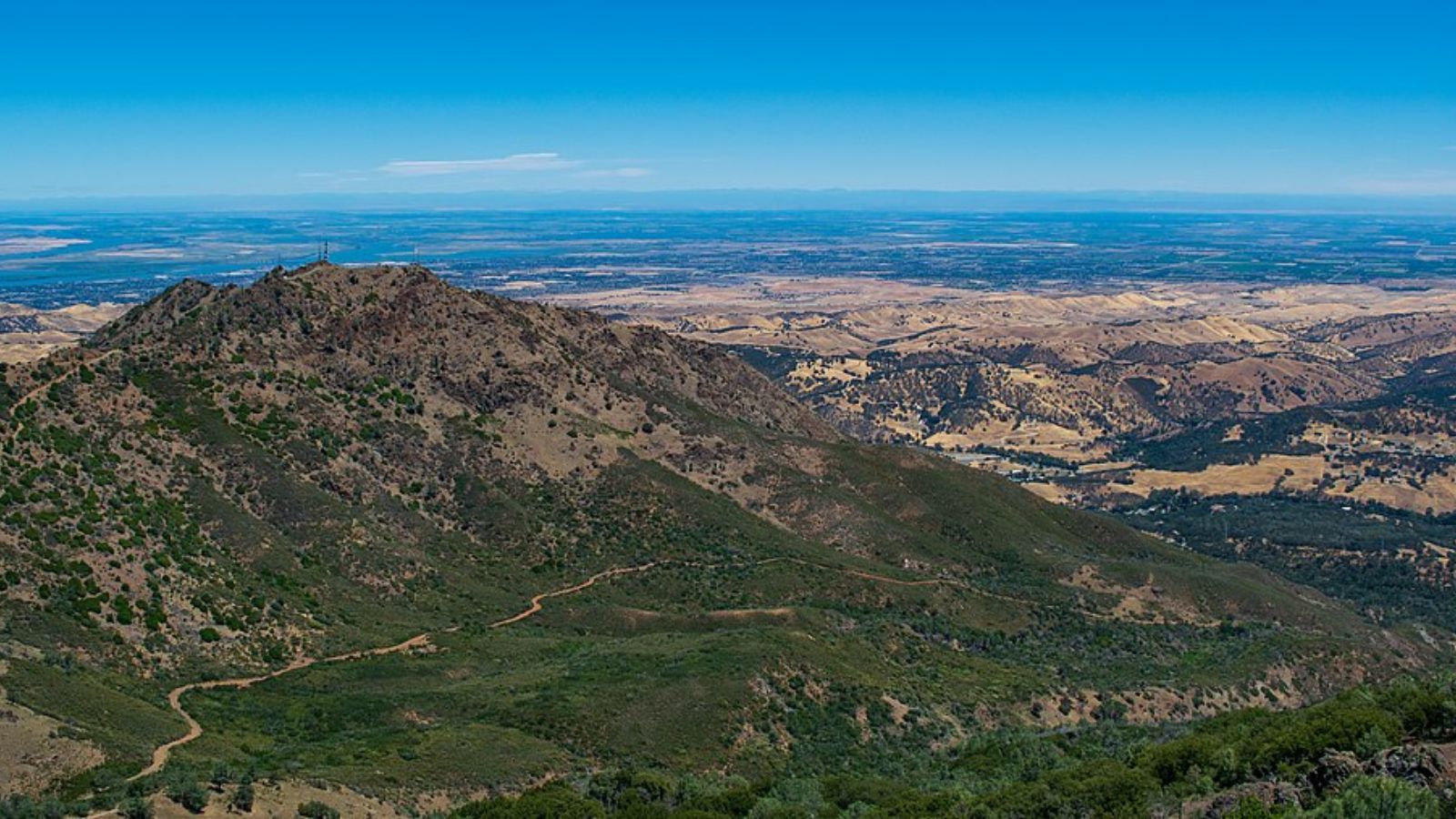
Why are people willing to pay so much to live here? What’s special about it?
Diablo offers ultimate privacy and security within a gated community featuring large custom estates and championship golf courses. The exclusive enclave attracts executives and entrepreneurs who value discretion, with homes set on multi-acre lots surrounded by protected open space. Residents enjoy access to the prestigious Diablo Country Club and extensive hiking trails while maintaining easy commutes to San Francisco and Silicon Valley.
The community’s exclusivity stems from its limited membership and strict architectural controls that maintain property values and community character. Many estates feature panoramic views of Mount Diablo and San Francisco Bay, with custom amenities including private tennis courts, pools, and guest houses. The combination of luxury, privacy, and recreational amenities justifies premium pricing for buyers seeking the ultimate in exclusive living.
How Diablo Rose to Prominence
Diablo was developed in the 1910s as an exclusive country club community by Robert Noble Burgess, who envisioned it as a retreat for San Francisco’s business elite. The original development centered around the Diablo Country Club, with carefully planned estates designed to take advantage of natural topography and views. Early residents included railroad executives, mining magnates, and financial leaders who valued the area’s privacy and recreational amenities.
The community maintained its exclusive character through careful membership selection and architectural controls that preserved its upscale atmosphere. Post-war prosperity brought new generations of business leaders while the area’s gated structure provided security and privacy increasingly valued by wealthy families. The preservation of surrounding open space and continued investment in club facilities has maintained Diablo’s appeal to successive generations of affluent buyers.
3 Interesting Tidbits
1. Golf Legacy – The Diablo Country Club, established in 1914, features one of Northern California’s oldest and most prestigious golf courses designed by renowned architect Willie Watson.
2. Architectural Standards – All homes must be approved by a strict architectural review board that maintains the community’s Spanish Colonial and Mediterranean Revival character.
3. Wildlife Preserve – The community borders Mount Diablo State Park, providing access to over 20,000 acres of protected wilderness and hiking trails.
20. Stanford – 176% Home Price Increase Since 2010
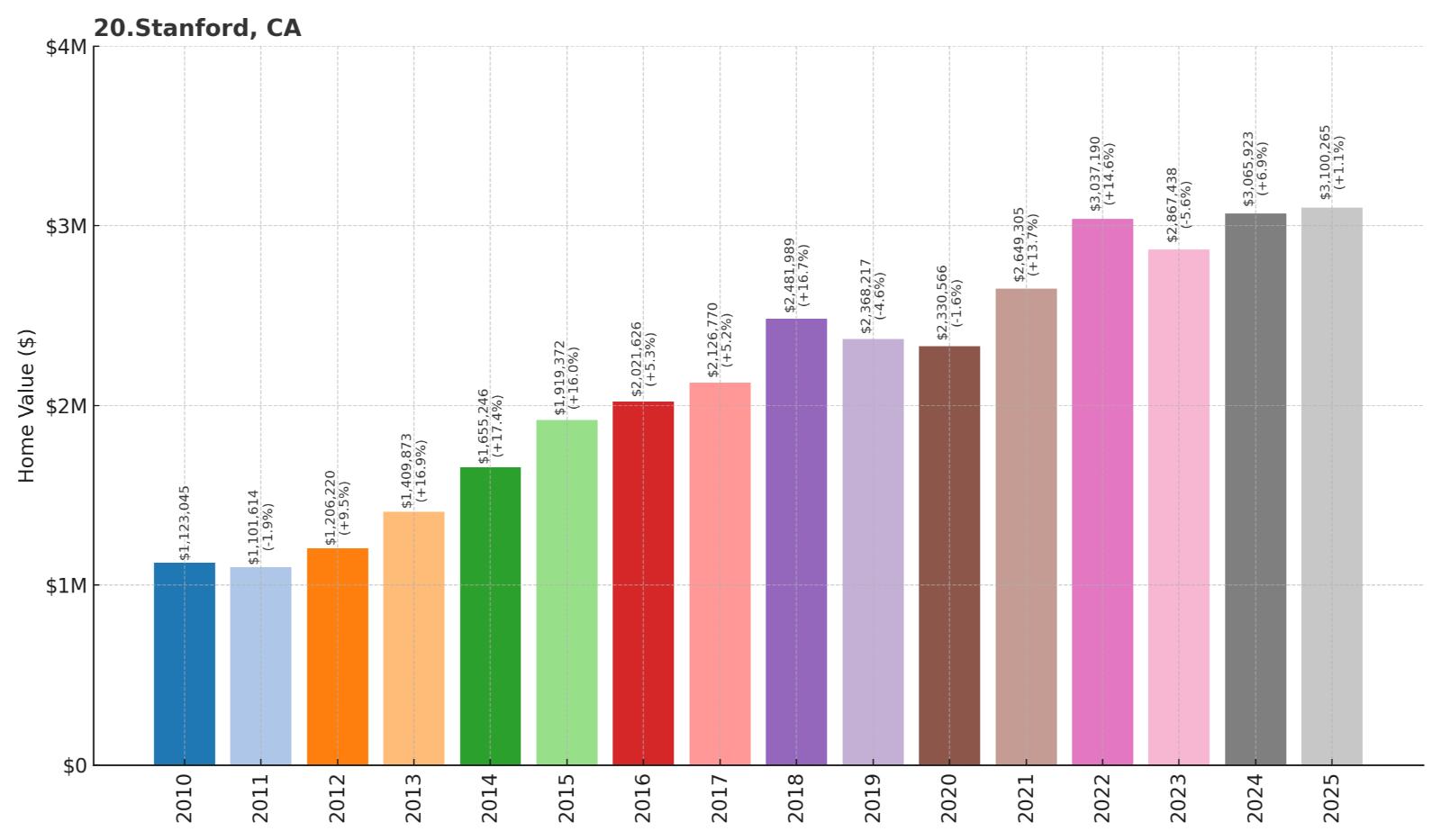
- 2010: $1,123,045
- 2011: $1,101,614
- 2012: $1,206,220
- 2013: $1,409,873
- 2014: $1,655,246
- 2015: $1,919,372
- 2016: $2,021,626
- 2017: $2,126,770
- 2018: $2,481,989
- 2019: $2,368,217
- 2020: $2,330,566
- 2021: $2,649,305
- 2022: $3,037,190
- 2023: $2,867,438
- 2024: $3,065,923
- 2025: $3,100,265
Stanford has shown exceptional growth, nearly tripling from $1.1 million in 2010 to $3.1 million by 2025. The community experienced steady acceleration through the 2010s as Silicon Valley expansion drove demand for university-adjacent housing. Recent years have shown continued strength above $3 million, reflecting sustained appeal of this prestigious academic community among technology professionals and university affiliates.
Why Stanford?
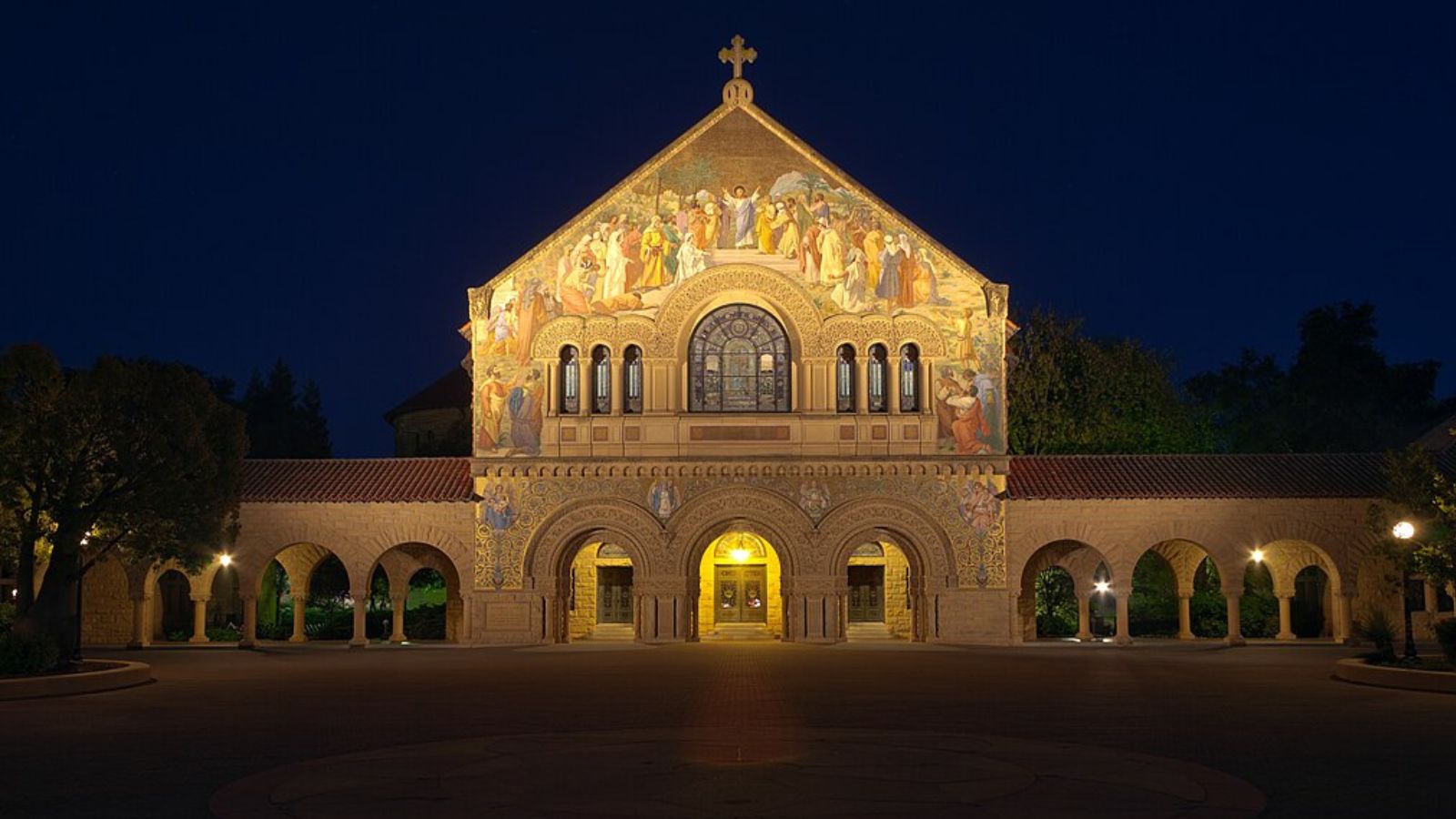
Why are people willing to pay so much to live here? What’s special about it?
Stanford offers unparalleled access to one of the world’s leading universities, creating opportunities for intellectual engagement and cultural enrichment. The community attracts faculty, technology executives, and entrepreneurs who value proximity to cutting-edge research and innovation. Residents enjoy beautiful campus architecture, extensive recreational facilities, and a sophisticated environment that combines academic excellence with Silicon Valley dynamism.
The area’s exclusivity stems from its limited housing stock and association with prestigious academic and business communities. Many residents have connections to Stanford University or nearby technology companies, creating a concentration of highly educated professionals. The combination of intellectual stimulation, natural beauty, and proximity to innovation centers creates unique value for buyers seeking an academically oriented lifestyle.
How Stanford Rose to Prominence
Stanford was established in 1885 when Leland Stanford founded the university in memory of his son, creating one of the world’s premier institutions of higher education. The campus was designed as a self-contained community with faculty housing, academic buildings, and recreational facilities integrated into a cohesive whole. Early development attracted leading academics and researchers who valued the university’s resources and California’s favorable climate.
The university’s emergence as a technology powerhouse in the latter 20th century transformed the surrounding area into the heart of Silicon Valley innovation. Faculty and graduates founded major technology companies while maintaining connections to campus research and development. The symbiotic relationship between university excellence and business innovation has created sustained demand for housing from academics, entrepreneurs, and technology executives.
3 Interesting Tidbits
1. Innovation Hub – Stanford Research Park, established in 1951, was one of the first university-affiliated technology parks and helped create the modern Silicon Valley ecosystem.
2. Academic Excellence – The university consistently ranks among the world’s top institutions, with faculty and alumni including numerous Nobel Prize winners and technology pioneers.
3. Campus Beauty – The 8,180-acre campus features Mission Revival architecture and extensive open space that creates a unique blend of academic and natural environments.
19. Rolling Hills – 125% Home Price Increase Since 2010
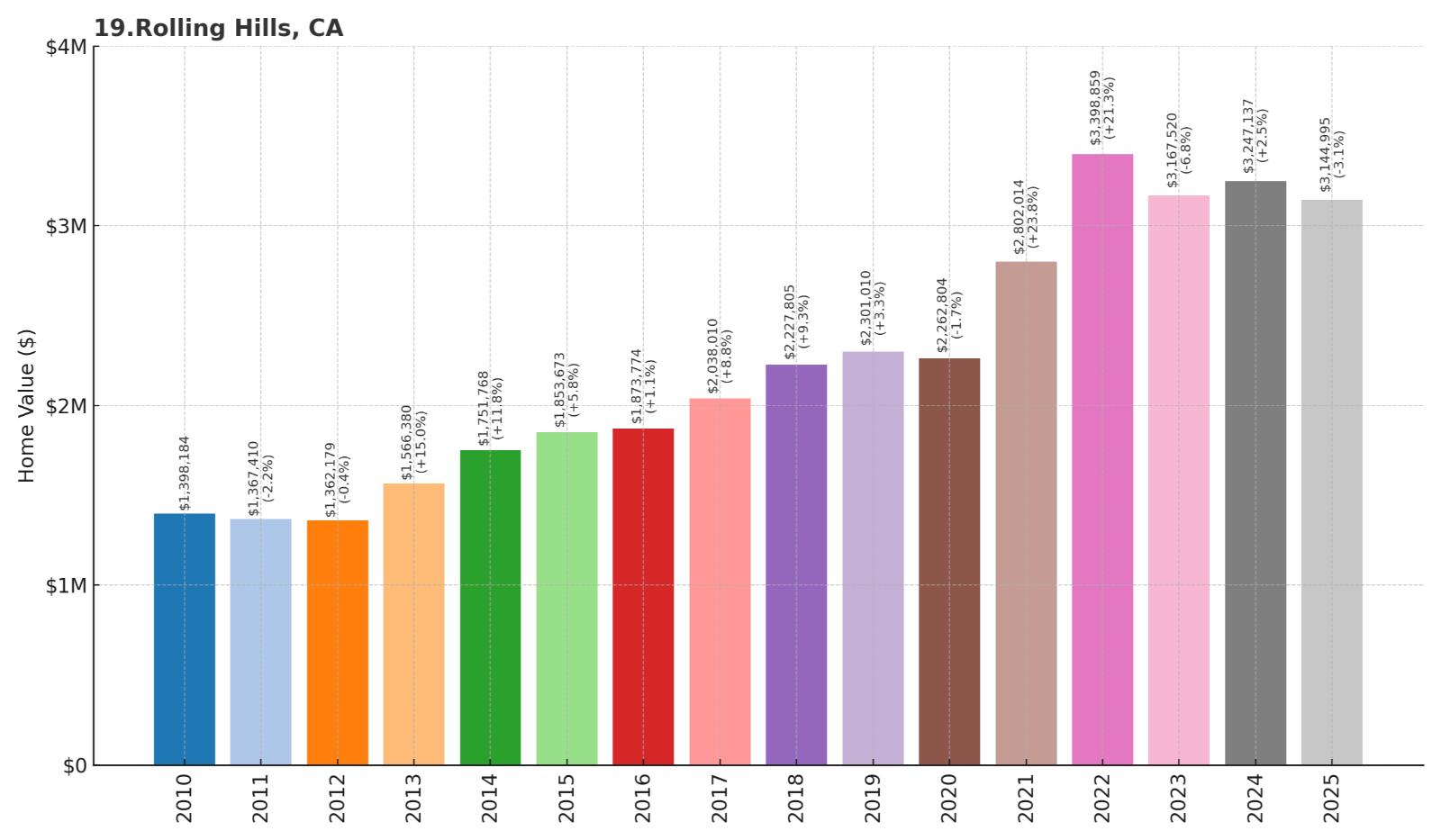
- 2010: $1,398,184
- 2011: $1,367,410
- 2012: $1,362,179
- 2013: $1,566,380
- 2014: $1,751,768
- 2015: $1,853,673
- 2016: $1,873,774
- 2017: $2,038,010
- 2018: $2,227,805
- 2019: $2,301,010
- 2020: $2,262,804
- 2021: $2,802,014
- 2022: $3,398,859
- 2023: $3,167,520
- 2024: $3,247,137
- 2025: $3,144,995
Rolling Hills has more than doubled in value since 2010, reaching over $3.1 million by 2025 after peaking above $3.4 million in 2022. The community has shown consistent appreciation over 15 years with particularly strong growth during the pandemic years. This exclusive Palos Verdes Peninsula enclave represents one of Southern California’s most private and restrictive residential communities.
Why Rolling Hills?

Why are people willing to pay so much to live here? What’s special about it?
Rolling Hills offers ultimate privacy and rural character within Los Angeles County through its gated community structure and equestrian lifestyle. The city requires minimum one-acre lots and maintains extensive bridle trails that create a countryside atmosphere minutes from urban centers. Residents enjoy custom estates with panoramic ocean and mountain views while maintaining access to excellent schools and metropolitan amenities.
The community’s exclusivity stems from its unique municipal structure that operates more like a private club than a traditional city. All residents must be approved by existing members, and strict architectural and landscaping controls maintain property values and character. The combination of privacy, space, and proximity to Los Angeles creates exceptional value for buyers seeking luxury and seclusion.
How Rolling Hills Rose to Prominence
Rolling Hills was incorporated in 1957 as a planned community designed to preserve rural character within Los Angeles County’s urban expansion. The founders established strict zoning requirements including minimum acreage, architectural controls, and equestrian facilities to create an exclusive enclave. Early residents included entertainment executives, business leaders, and professionals who valued privacy and space while maintaining access to Los Angeles employment opportunities.
The community’s unique governance structure, which combines municipal services with private club membership, has maintained its exclusive character for over six decades. Careful development controls and preservation of open space have created a stable environment that attracts successive generations of wealthy families. The area’s association with equestrian sports and rural lifestyle has enhanced its appeal to buyers seeking alternatives to traditional suburban living.
3 Interesting Tidbits
1. Equestrian Paradise – The city maintains over 50 miles of bridle trails and requires all properties to accommodate horses, preserving its rural heritage.
2. Exclusive Membership – All residents must be approved by existing community members, making it one of the most exclusive residential areas in California.
3. White Fence Requirement – All properties must maintain white wooden fencing along street frontages, creating the distinctive appearance that gives the community its character.
18. Malibu – 170% Home Price Increase Since 2010

- 2010: $1,193,754
- 2011: $1,168,511
- 2012: $1,134,535
- 2013: $1,242,263
- 2014: $1,401,472
- 2015: $1,532,190
- 2016: $1,536,040
- 2017: $1,770,884
- 2018: $2,249,322
- 2019: $2,359,821
- 2020: $2,260,412
- 2021: $2,967,473
- 2022: $3,477,677
- 2023: $3,227,356
- 2024: $3,278,554
- 2025: $3,218,294
Malibu has shown dramatic growth, nearly tripling from $1.2 million in 2010 to over $3.2 million by 2025. The community experienced steady appreciation through the 2010s followed by exceptional acceleration during pandemic years. Despite recent moderation from its 2022 peak, Malibu remains one of California’s most recognizable and expensive coastal communities, attracting celebrities, executives, and affluent buyers seeking beachfront luxury.
Why Malibu?

Why are people willing to pay so much to live here? What’s special about it?
Malibu offers world-famous beaches, dramatic coastal mountains, and celebrity culture that creates an aspirational lifestyle destination. The community features 27 miles of pristine coastline with excellent surfing, hiking, and outdoor recreation opportunities. Residents enjoy privacy and natural beauty while maintaining access to Los Angeles entertainment industry and business centers, making it particularly appealing to celebrities and executives.
The area’s exclusivity stems from its natural boundaries and limited development along the narrow coastal corridor between mountains and ocean. Many properties offer direct beach access and panoramic ocean views that are impossible to replicate elsewhere in Southern California. The combination of natural beauty, celebrity culture, and recreational opportunities creates unique lifestyle value that justifies premium pricing for affluent buyers.
How Malibu Rose to Prominence
Malibu’s development began in the 1920s when May Rindge sold beachfront lots to create an exclusive coastal colony for wealthy Los Angeles families. Early residents included movie stars and business executives who were attracted to the area’s natural beauty and isolation from urban pressures. The construction of Pacific Coast Highway improved access while maintaining the community’s secluded character along the dramatic coastline.
Hollywood’s golden age brought numerous celebrities who established beach homes and helped create Malibu’s glamorous reputation. The community’s incorporation in 1991 allowed residents to control development and preserve the area’s natural character. Continued association with entertainment industry success and luxury lifestyle has maintained Malibu’s appeal to successive generations of wealthy buyers seeking coastal prestige.
3 Interesting Tidbits
1. Surf Culture – Malibu’s beaches helped popularize surfing in California, with legendary surf spots like Surfrider Beach attracting enthusiasts worldwide.
2. Fire Resilience – The community regularly faces wildfire threats due to its location between dry mountains and ocean, requiring specialized building materials and emergency planning.
3. Celebrity Haven – The area has been home to countless entertainment industry figures, from classic Hollywood stars to contemporary musicians and actors seeking privacy and luxury.
17. Newport Beach – 158% Home Price Increase Since 2010
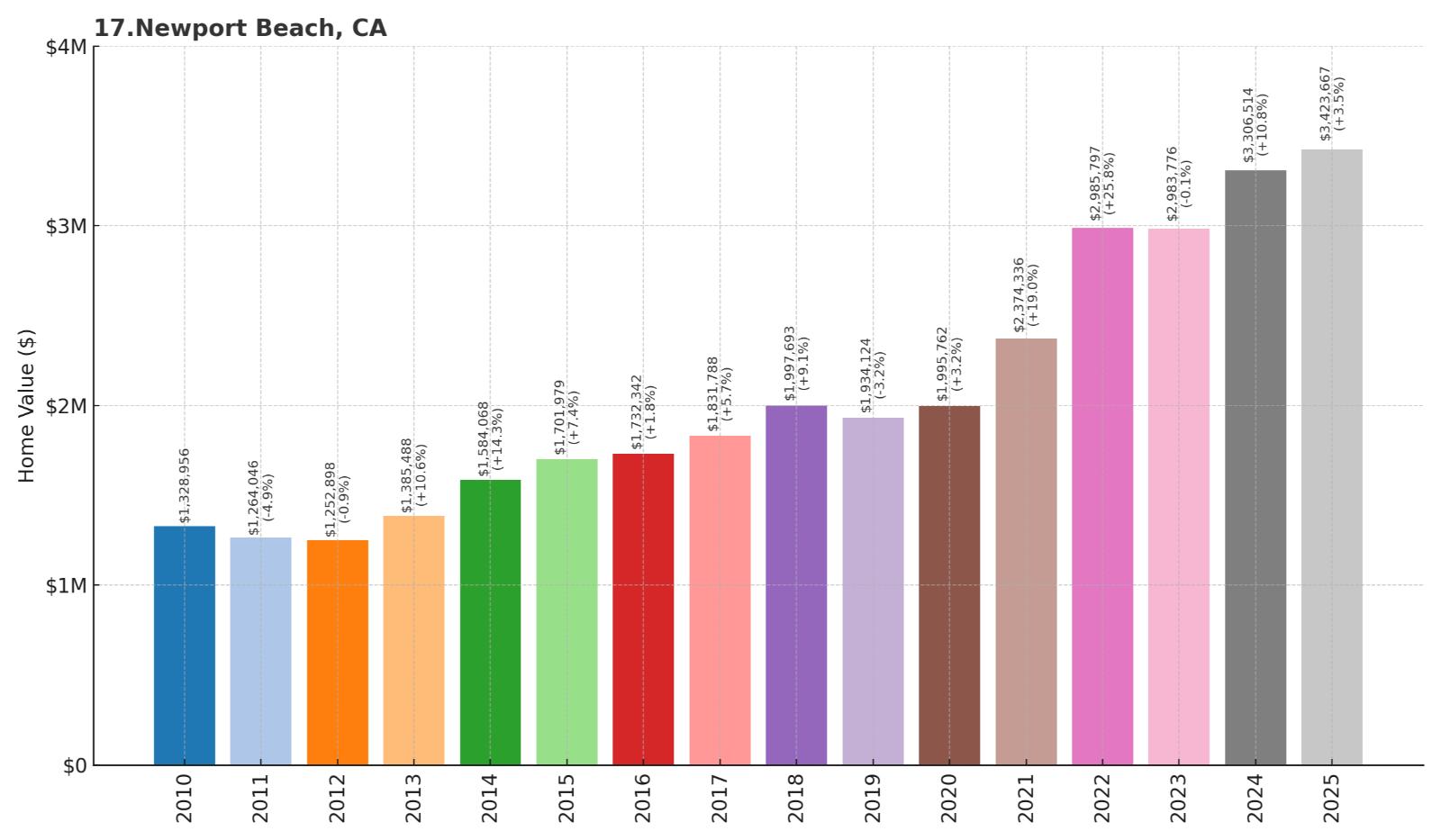
- 2010: $1,328,956
- 2011: $1,264,046
- 2012: $1,252,898
- 2013: $1,385,488
- 2014: $1,584,068
- 2015: $1,701,979
- 2016: $1,732,342
- 2017: $1,831,788
- 2018: $1,997,693
- 2019: $1,934,124
- 2020: $1,995,762
- 2021: $2,374,336
- 2022: $2,985,797
- 2023: $2,983,776
- 2024: $3,306,514
- 2025: $3,423,667
Newport Beach has shown strong growth over 15 years, rising from $1.3 million to over $3.4 million by 2025. The community experienced steady appreciation through the 2010s followed by significant acceleration during and after the pandemic years. Recent gains have pushed values above $3.4 million, reflecting continued demand for this Orange County coastal destination among affluent families and retirees seeking luxury waterfront living.
Why Newport Beach?

Why are people willing to pay so much to live here? What’s special about it?
Newport Beach offers a sophisticated coastal lifestyle with world-class sailing, dining, and shopping in an upscale resort-like environment. The community features one of California’s largest recreational harbors, excellent beaches, and luxury amenities that appeal to boating enthusiasts and beach lovers. Residents enjoy year-round outdoor activities while maintaining access to Orange County’s business centers and cultural attractions.
The city’s appeal stems from its successful balance of luxury resort amenities with residential sophistication that attracts executives, retirees, and affluent families. Many neighborhoods offer waterfront living with private docks and beach access, while inland areas provide custom homes with golf course and harbor views. The combination of recreational opportunities, luxury amenities, and coastal location creates exceptional lifestyle value for buyers seeking upscale living.
How Newport Beach Rose to Prominence
Newport Beach developed in the early 1900s as a seaside resort destination when railroad connections brought wealthy Los Angeles families to the area’s natural harbor and beaches. The construction of Balboa Pavilion and the famous Balboa Fun Zone established the community as a premier recreational destination. Early development focused on waterfront hotels, summer homes, and recreational facilities that attracted affluent visitors from across Southern California.
Post-war prosperity brought year-round residents who valued the area’s boating culture, beaches, and upscale atmosphere. The development of Fashion Island shopping center in the 1960s and subsequent luxury residential projects cemented Newport Beach’s reputation as Orange County’s premier coastal community. Continued investment in marina facilities, luxury amenities, and cultural attractions has maintained its appeal to successive generations of affluent buyers.
3 Interesting Tidbits
1. Boating Paradise – Newport Harbor contains over 9,000 boat slips, making it one of the largest recreational marinas in the United States.
2. Balboa Island – This charming man-made island features quaint cottages and waterfront homes accessible by a historic auto ferry that’s been operating since 1919.
3. Shopping Destination – Fashion Island outdoor shopping center attracts visitors from across Southern California with its luxury retailers and oceanview dining.
16. Beverly Hills – 115% Home Price Increase Since 2010

- 2010: $1,600,943
- 2011: $1,569,898
- 2012: $1,529,140
- 2013: $1,740,851
- 2014: $1,990,583
- 2015: $2,179,351
- 2016: $2,148,742
- 2017: $2,369,766
- 2018: $2,865,753
- 2019: $3,191,863
- 2020: $3,218,916
- 2021: $3,516,892
- 2022: $4,036,226
- 2023: $3,735,074
- 2024: $3,568,312
- 2025: $3,435,256
Beverly Hills has more than doubled in value since 2010, reaching $3.4 million by 2025 after peaking above $4 million in 2022. The community experienced steady growth through the 2010s followed by exceptional acceleration during pandemic years. Recent moderation reflects broader luxury market adjustments while maintaining its position as one of the world’s most prestigious residential addresses.
Why Beverly Hills?
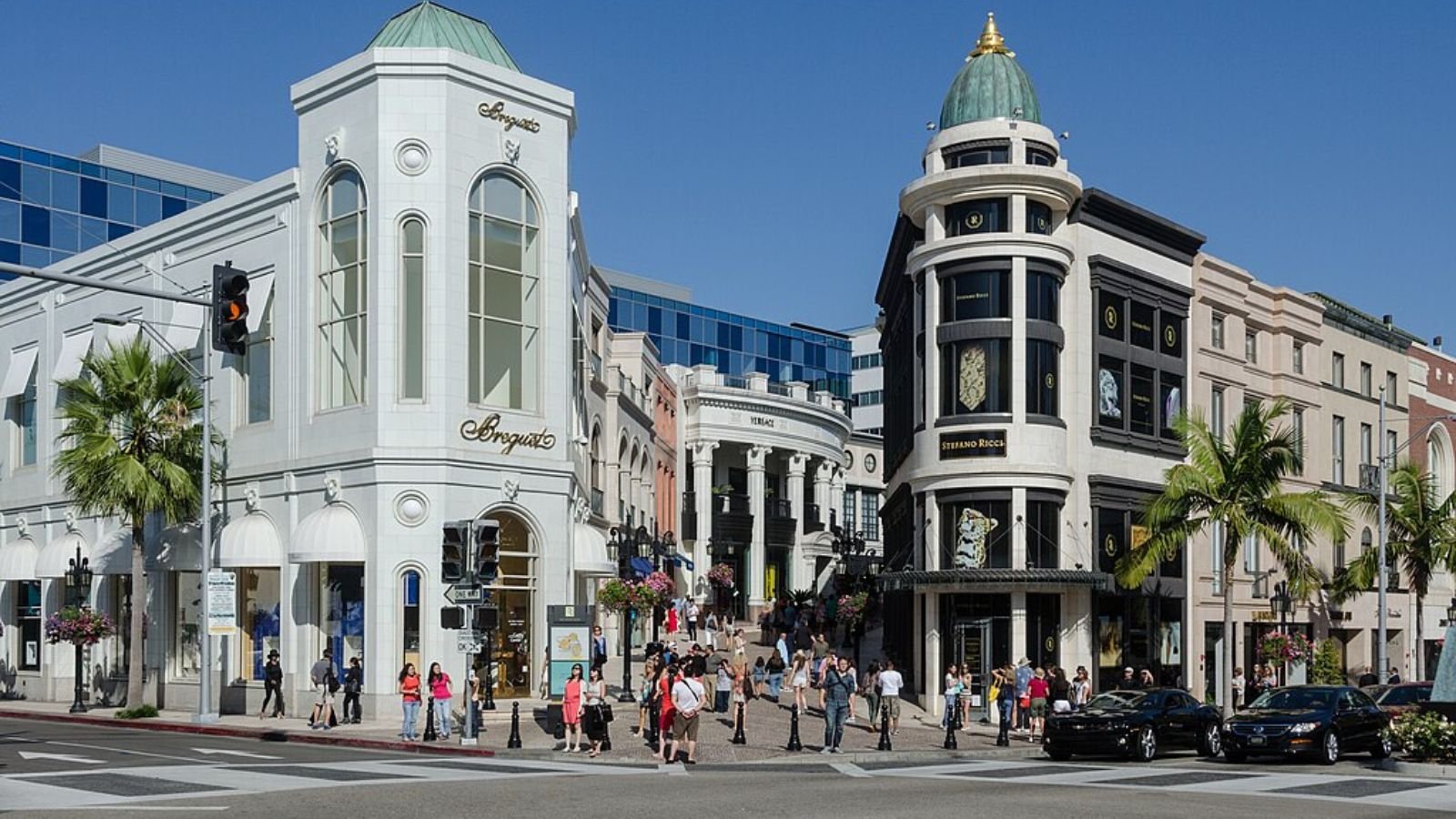
Why are people willing to pay so much to live here? What’s special about it?
Beverly Hills represents the pinnacle of luxury living with world-famous shopping on Rodeo Drive, exceptional dining, and proximity to Hollywood entertainment centers. The community attracts celebrities, executives, and international buyers seeking prestige and glamour in an iconic setting. Residents enjoy beautiful architecture, manicured neighborhoods, and access to exclusive clubs while living in one of the world’s most recognizable luxury destinations.
The city’s appeal stems from its global reputation for wealth and sophistication that creates unparalleled prestige value for property owners. Many homes feature architectural significance and celebrity history, while the community maintains excellent public services and security. The combination of glamour, location, and cultural significance creates unique investment and lifestyle value that justifies premium pricing.
How Beverly Hills Rose to Prominence
Beverly Hills was developed in 1914 as a luxury residential community designed to attract wealthy Los Angeles families seeking elegant suburban living. The construction of the Beverly Hills Hotel established the area’s reputation for luxury and glamour, attracting early Hollywood stars and business magnates. Careful planning and architectural controls created beautiful neighborhoods that became synonymous with California luxury living.
The golden age of Hollywood cemented Beverly Hills’ reputation as a celebrity enclave, with many movie stars establishing elaborate estates that enhanced the community’s glamorous image. The development of Rodeo Drive as a luxury shopping destination in the latter 20th century added international recognition and tourist appeal. Continued association with entertainment industry success and luxury lifestyle has maintained Beverly Hills’ status as a global symbol of affluence.
3 Interesting Tidbits
1. Shopping Legend – Rodeo Drive is considered one of the world’s most expensive shopping streets, featuring flagship stores of luxury brands from around the globe.
2. Architectural Gems – The city features numerous historic mansions and architecturally significant homes designed by renowned architects including Paul Williams and Wallace Neff.
3. Celebrity Central – The area has been home to countless entertainment industry legends, from silent film stars to contemporary actors, musicians, and producers.
15. Palo Alto – 178% Home Price Increase Since 2010
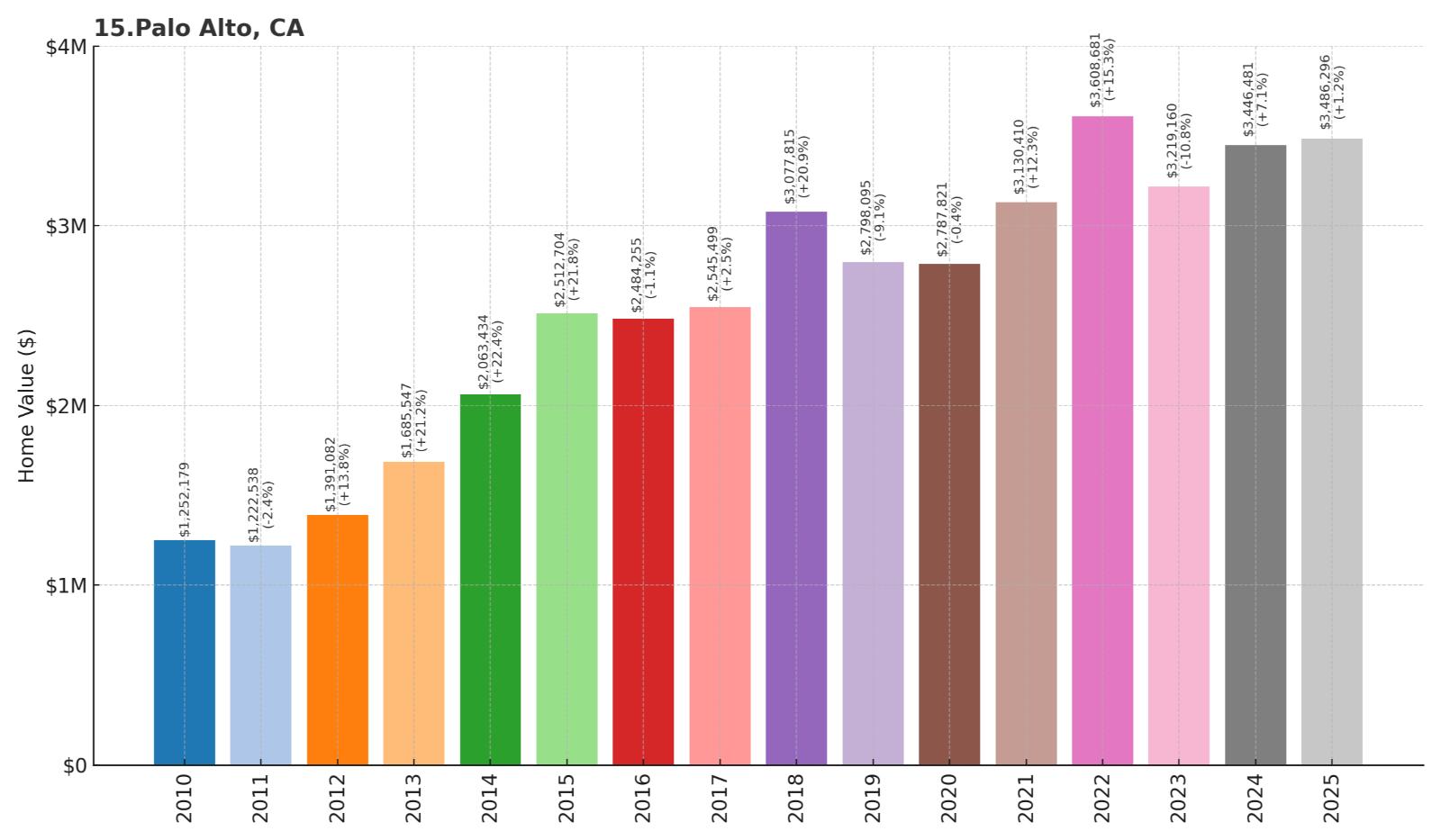
- 2010: $1,252,179
- 2011: $1,222,538
- 2012: $1,391,082
- 2013: $1,685,547
- 2014: $2,063,434
- 2015: $2,512,704
- 2016: $2,484,255
- 2017: $2,545,499
- 2018: $3,077,815
- 2019: $2,798,095
- 2020: $2,787,821
- 2021: $3,130,410
- 2022: $3,608,681
- 2023: $3,219,160
- 2024: $3,446,481
- 2025: $3,486,296
Palo Alto has shown exceptional growth, nearly tripling from $1.3 million in 2010 to $3.5 million by 2025. The community experienced steady acceleration through the 2010s as technology companies expanded and Stanford University’s influence grew. Despite some volatility in recent years, Palo Alto remains at the heart of Silicon Valley innovation and wealth creation, driving sustained demand for housing.
Why Palo Alto?
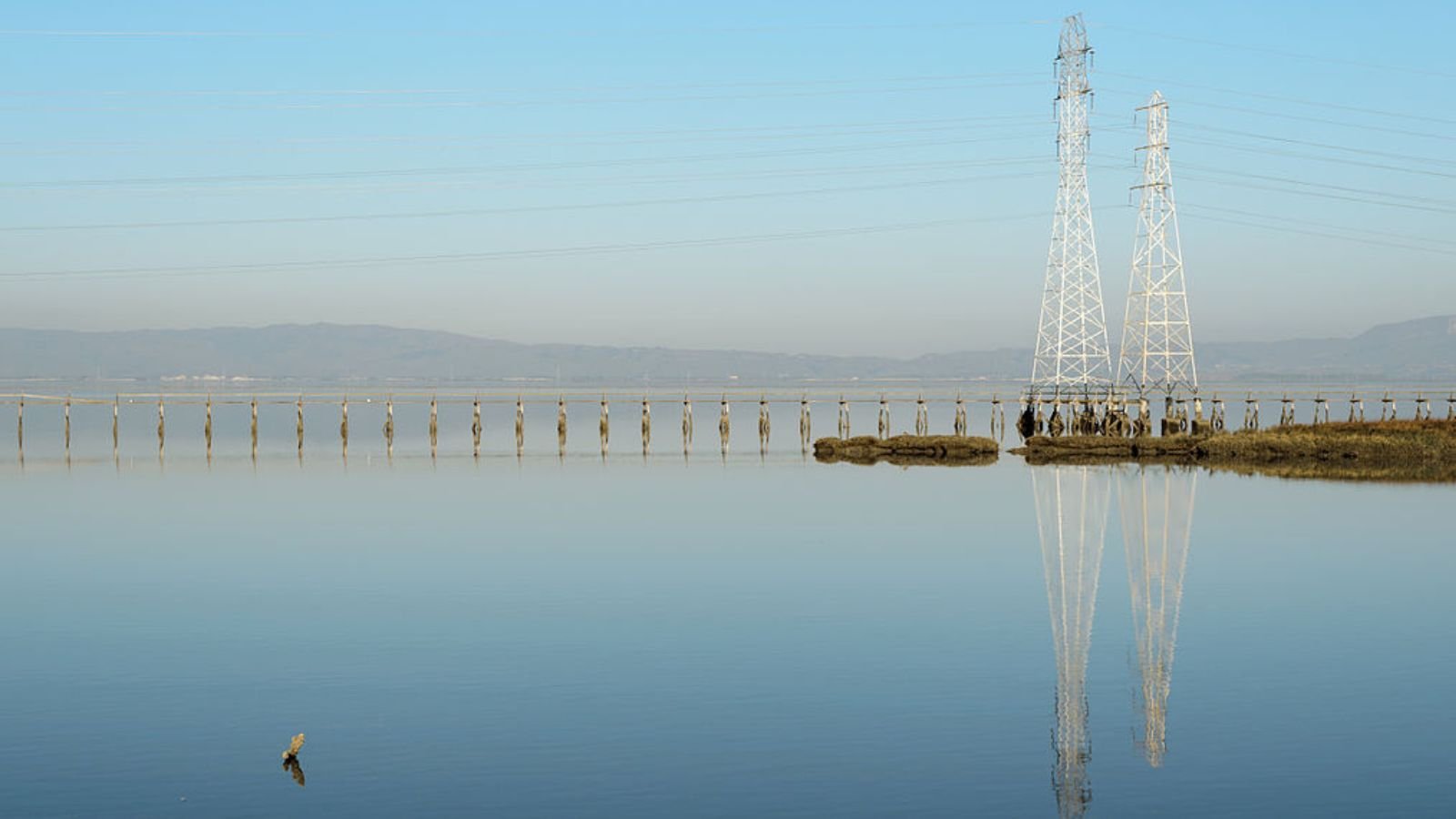
Why are people willing to pay so much to live here? What’s special about it?
Palo Alto offers unmatched access to Silicon Valley innovation and Stanford University resources that create exceptional career and educational opportunities. The community attracts technology executives, entrepreneurs, and academics who value proximity to cutting-edge research and business development. Residents enjoy excellent schools, cultural amenities, and a sophisticated environment that combines academic excellence with entrepreneurial energy.
The city’s appeal stems from its position at the center of global technology innovation where many of the world’s most valuable companies were founded and continue to operate. Many residents have direct connections to major technology firms or Stanford University, creating a concentration of highly educated professionals and substantial wealth. The combination of intellectual stimulation, business opportunity, and quality of life creates unique value for buyers seeking to participate in technology innovation.
How Palo Alto Rose to Prominence
Palo Alto was founded in 1894 around Stanford University, establishing its identity as an academic community from the beginning. The city’s development was closely tied to the university’s growth and research activities, attracting faculty, students, and businesses seeking to benefit from academic resources. Early residents included university professors, administrators, and business leaders who valued the combination of intellectual environment and California’s favorable climate.
The transformation into a technology center began in the 1930s and accelerated after World War II when Stanford encouraged faculty and graduates to start companies near campus. Firms like Hewlett-Packard, founded by Stanford graduates in 1939, established the pattern of university-industry collaboration that would define Silicon Valley. The development of Stanford Research Park in 1951 formalized this relationship and attracted major technology companies that employed local residents and drove housing demand.
3 Interesting Tidbits
1. Garage Legacy – The famous garage where Bill Hewlett and Dave Packard started HP is designated as the “Birthplace of Silicon Valley” and remains a pilgrimage site for technology enthusiasts.
2. Tree City – Palo Alto means “tall stick” in Spanish, referring to a historic redwood tree that still stands in the city and serves as its symbol.
3. Innovation Hub – The city has been home to breakthrough companies including Tesla, Facebook, Google, and countless startups that have shaped modern technology.
14. Del Mar – 177% Home Price Increase Since 2010

- 2010: $1,277,047
- 2011: $1,368,004
- 2012: $1,446,174
- 2013: $1,636,887
- 2014: $1,815,193
- 2015: $2,005,645
- 2016: $2,212,485
- 2017: $2,297,414
- 2018: $2,388,833
- 2019: $2,385,848
- 2020: $2,386,007
- 2021: $2,908,622
- 2022: $3,665,446
- 2023: $3,462,343
- 2024: $3,648,337
- 2025: $3,535,197
Del Mar has shown remarkable growth, nearly tripling from $1.3 million in 2010 to $3.5 million by 2025. The community experienced steady appreciation through the 2010s followed by exceptional acceleration during pandemic years. This San Diego County coastal town has maintained values above $3.5 million, reflecting continued appeal among affluent buyers seeking beachfront living with small-town charm and proximity to major employment centers.
Why Del Mar?
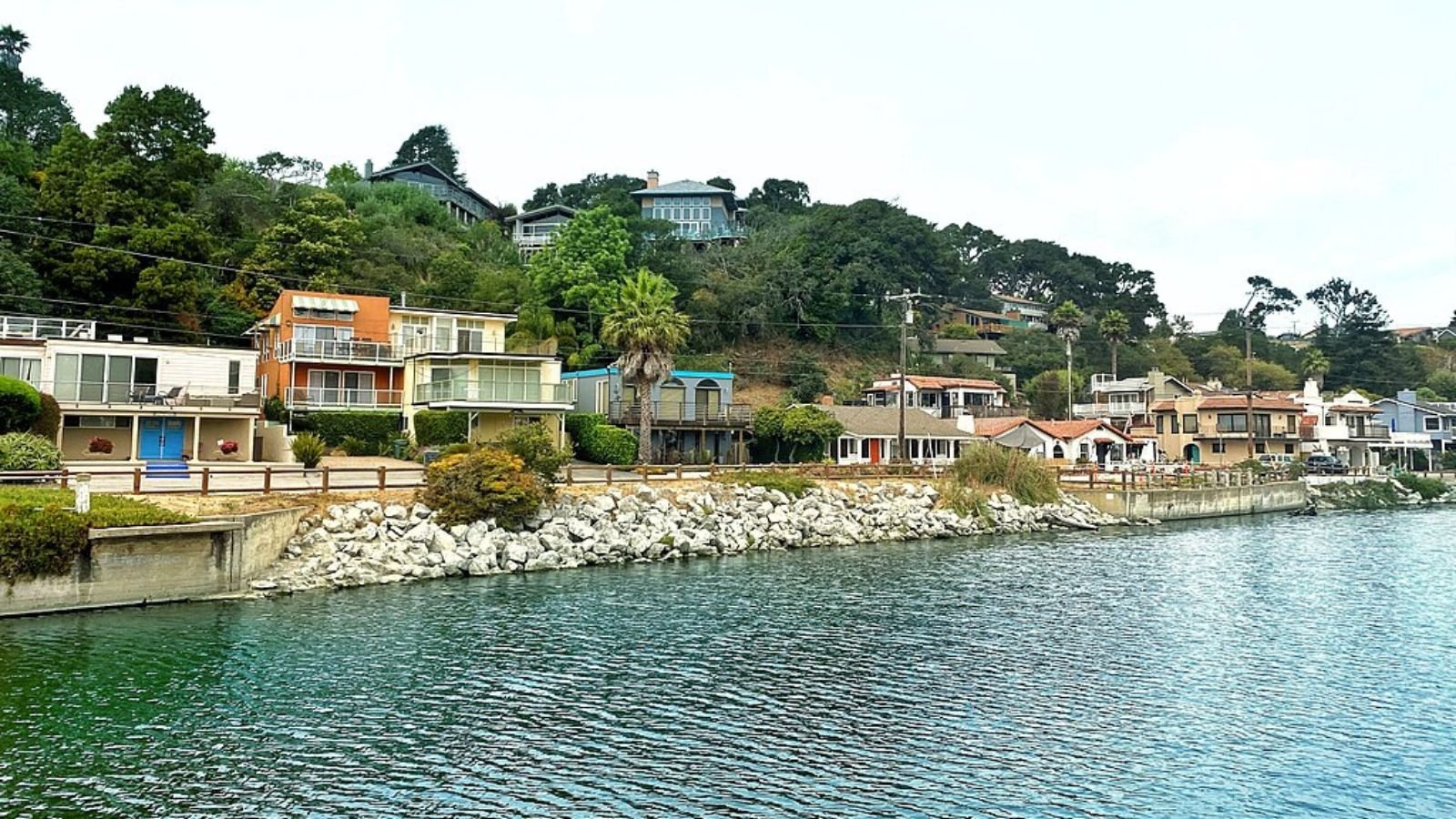
Why are people willing to pay so much to live here? What’s special about it?
Del Mar offers pristine beaches, excellent surfing, and a charming village atmosphere that creates an ideal coastal lifestyle. The community features beautiful bluff-top homes with panoramic ocean views, while the downtown area provides walkable access to fine dining, shopping, and cultural events. Residents enjoy year-round outdoor activities including beach sports, hiking, and golf while maintaining access to San Diego’s business and cultural centers.
The city’s appeal stems from its successful preservation of small-town character while offering luxury amenities and natural beauty that attract affluent families and retirees. Many properties offer direct beach access and dramatic ocean views, while the community maintains excellent schools and low crime rates. The combination of coastal lifestyle, natural beauty, and proximity to employment centers creates exceptional value for buyers seeking upscale beach living.
How Del Mar Rose to Prominence
Del Mar was developed in the 1880s as a seaside resort community designed to attract wealthy visitors from Los Angeles and San Diego. The construction of the Del Mar Racetrack in 1937, with backing from Hollywood celebrities including Bing Crosby, elevated the area’s profile as a glamorous destination. The famous slogan “Where the Turf Meets the Surf” captured the community’s unique combination of horse racing and beach culture.
Post-war development brought permanent residents who valued the area’s beaches, climate, and sophisticated atmosphere. The community’s incorporation in 1959 allowed residents to control growth and maintain the village character that distinguishes it from larger coastal cities. Careful planning and preservation of open space have maintained Del Mar’s appeal while property values have appreciated dramatically due to limited supply and sustained demand.
3 Interesting Tidbits
1. Racing Legacy – Del Mar Racetrack, founded by Hollywood stars, remains one of California’s premier horse racing venues and hosts the prestigious Pacific Classic Stakes.
2. Architectural Harmony – The city maintains strict design guidelines that preserve its Mediterranean and Spanish Colonial Revival character while allowing for modern amenities.
3. Beach Paradise – The two-mile stretch of beach is consistently rated among California’s best, featuring wide sandy shores perfect for surfing, volleyball, and beach activities.
13. Ross – 79% Home Price Increase Since 2010
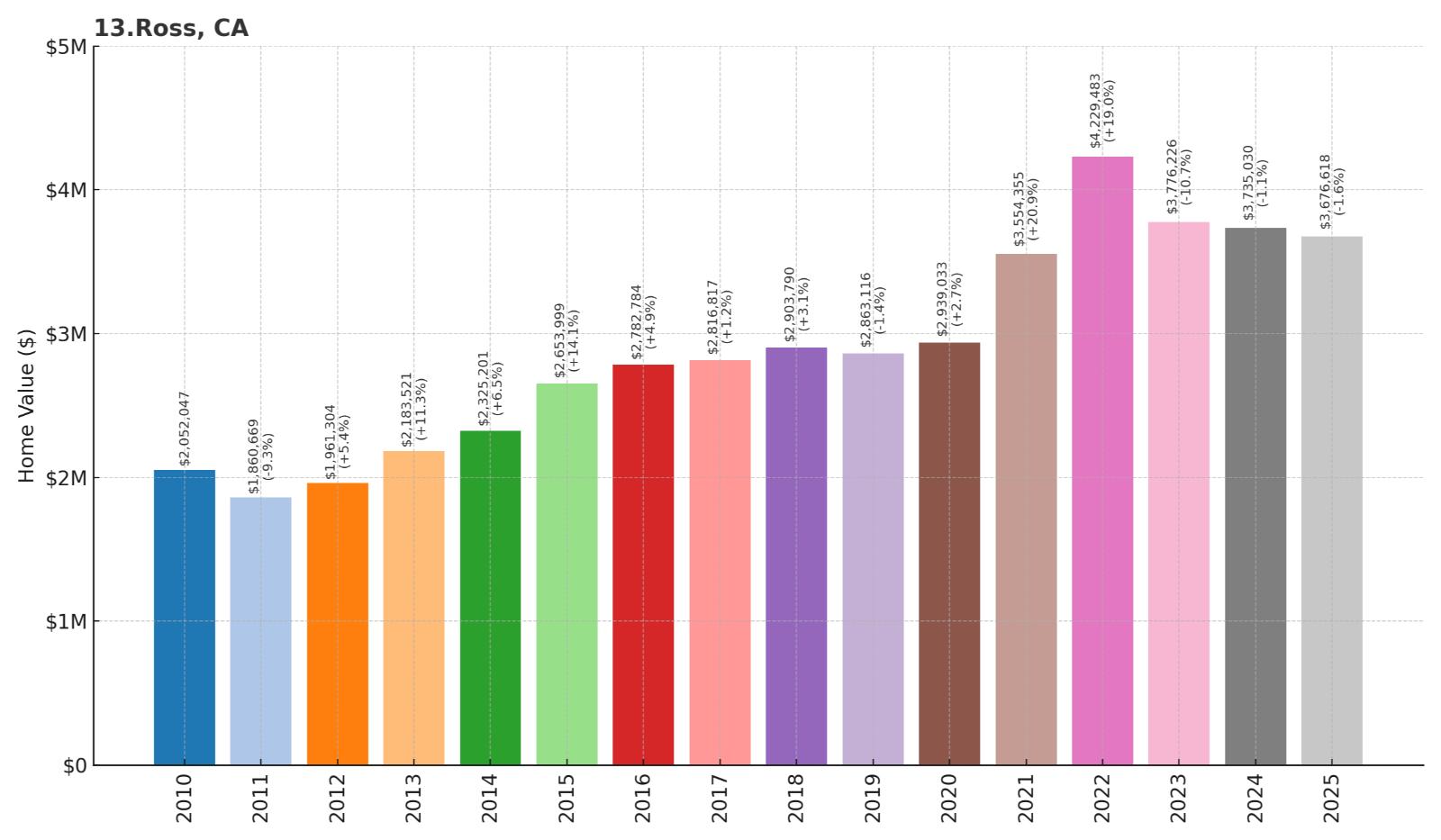
- 2010: $2,052,047
- 2011: $1,860,669
- 2012: $1,961,304
- 2013: $2,183,521
- 2014: $2,325,201
- 2015: $2,653,999
- 2016: $2,782,784
- 2017: $2,816,817
- 2018: $2,903,790
- 2019: $2,863,116
- 2020: $2,939,033
- 2021: $3,554,355
- 2022: $4,229,483
- 2023: $3,776,226
- 2024: $3,735,030
- 2025: $3,676,618
Ross has shown the most modest growth rate on this list at 79%, but started from a high base of $2.1 million in 2010 and reached $3.7 million by 2025. The community experienced steady appreciation through the 2010s followed by significant acceleration during pandemic years when values peaked above $4.2 million. This Marin County enclave represents one of California’s most established wealthy communities with a long history of attracting affluent families.
Why Ross?
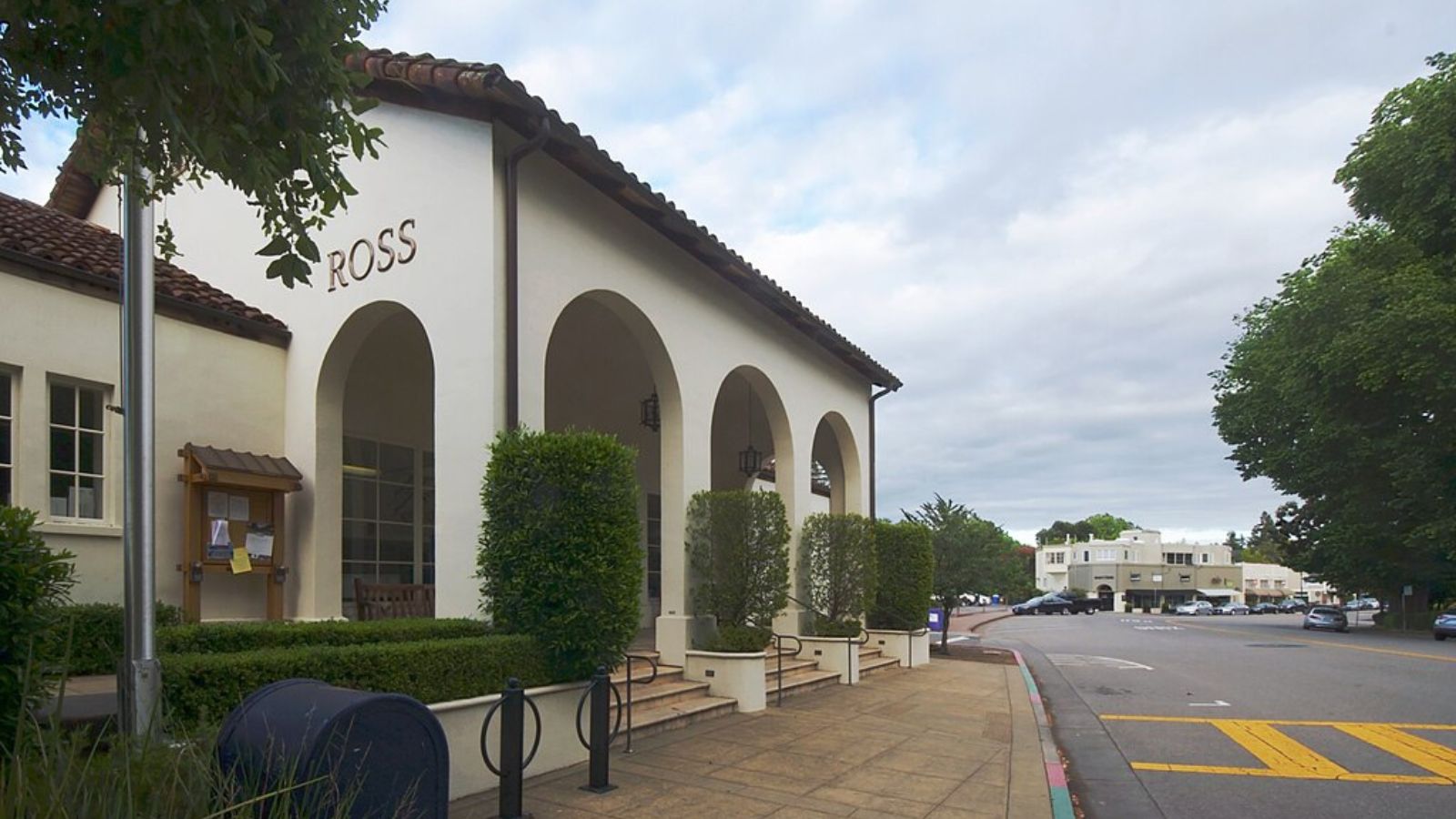
Why are people willing to pay so much to live here? What’s special about it?
Ross offers a rare combination of rural tranquility and San Francisco accessibility that appeals to executives and professionals seeking a country lifestyle. The community features large estates on heavily wooded lots with extensive hiking trails, parks, and recreational facilities throughout. Residents enjoy excellent schools, low crime rates, and a small-town atmosphere while maintaining easy access to San Francisco Bay Area employment and cultural opportunities.
The town’s exclusivity stems from its limited housing stock and strict zoning that preserves open space and rural character within the urbanized Bay Area. Many properties span multiple acres with custom homes designed to integrate with natural surroundings, creating privacy impossible to find in denser communities. The combination of natural beauty, excellent schools, and proximity to major employment centers justifies premium pricing for families seeking suburban tranquility.
How Ross Rose to Prominence
Ross was founded in 1857 by James Ross, a Scotsman who established a trading post and ferry service in the area. The community developed as a summer retreat destination for wealthy San Francisco families seeking escape from urban pressures while maintaining business connections to the city. Early development preserved the area’s natural character with large lots and minimal commercial activity, establishing patterns that continue today.
The construction of railroad connections in the late 1800s improved access while the community maintained its exclusive residential character. Post-earthquake development in 1906 brought new San Francisco residents seeking permanent homes in a safer, more natural setting. The town’s incorporation in 1908 allowed residents to control development and maintain the rural atmosphere that continues to attract affluent families seeking alternatives to urban living.
3 Interesting Tidbits
1. Open Space – Nearly 80% of the town consists of parks, open space, and recreational facilities, creating a rural environment within the metropolitan Bay Area.
2. Historic School – The Ross School, built in 1928, serves as both an excellent elementary school and a community center that brings residents together for events and activities.
3. Equestrian Heritage – Many properties maintain stables and riding facilities, reflecting the community’s long tradition of horse ownership and rural lifestyle.
12. Woodside – 132% Home Price Increase Since 2010
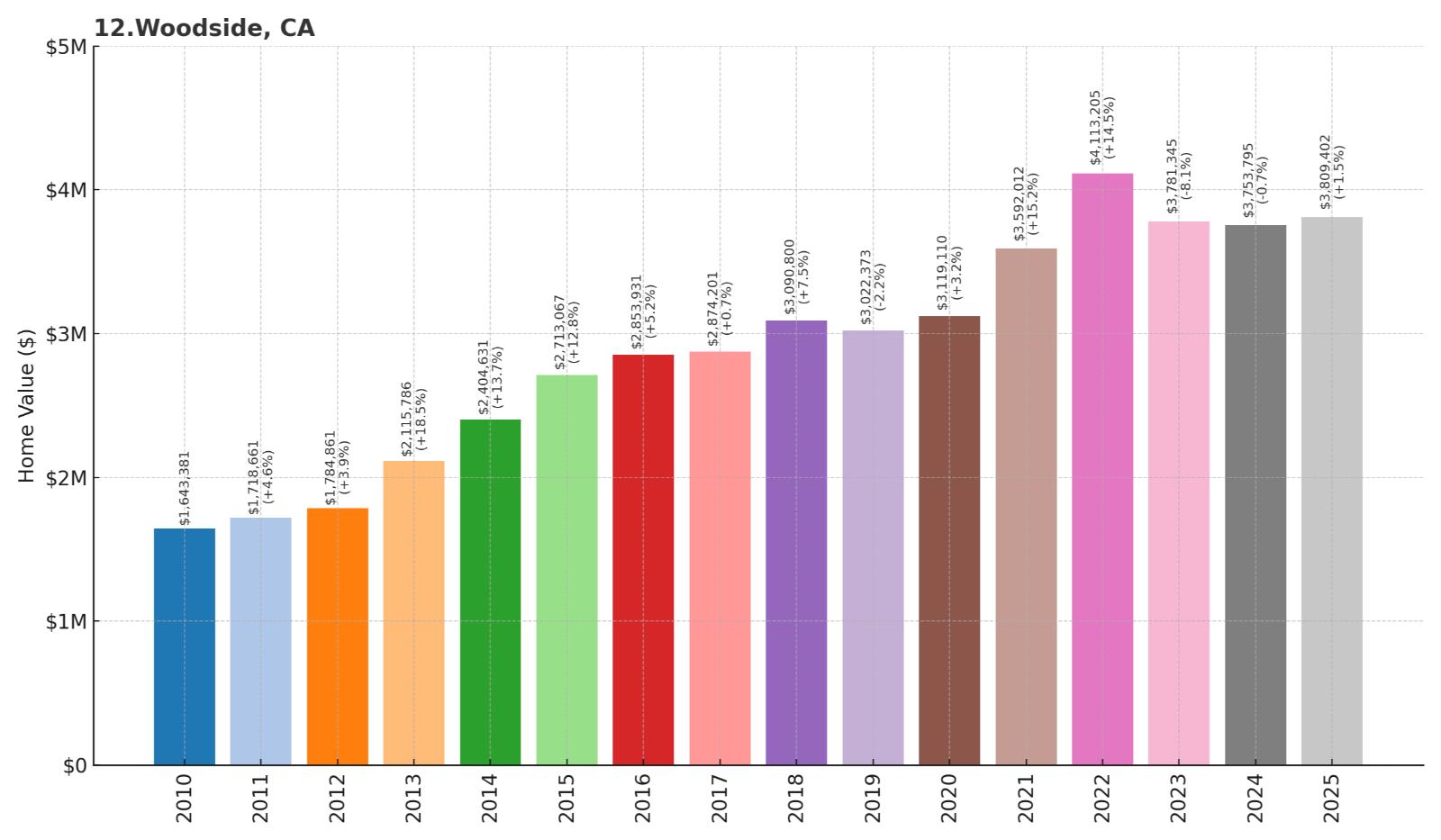
- 2010: $1,643,381
- 2011: $1,718,661
- 2012: $1,784,861
- 2013: $2,115,786
- 2014: $2,404,631
- 2015: $2,713,067
- 2016: $2,853,931
- 2017: $2,874,201
- 2018: $3,090,800
- 2019: $3,022,373
- 2020: $3,119,110
- 2021: $3,592,012
- 2022: $4,113,205
- 2023: $3,781,345
- 2024: $3,753,795
- 2025: $3,809,402
Woodside has more than doubled in value since 2010, reaching $3.8 million by 2025 after peaking above $4.1 million in 2022. The community experienced consistent growth through the 2010s as Silicon Valley wealth expanded into surrounding areas. This San Mateo County town represents one of the Peninsula’s most prestigious addresses, combining rural character with proximity to technology centers and venture capital firms.
Why Woodside?
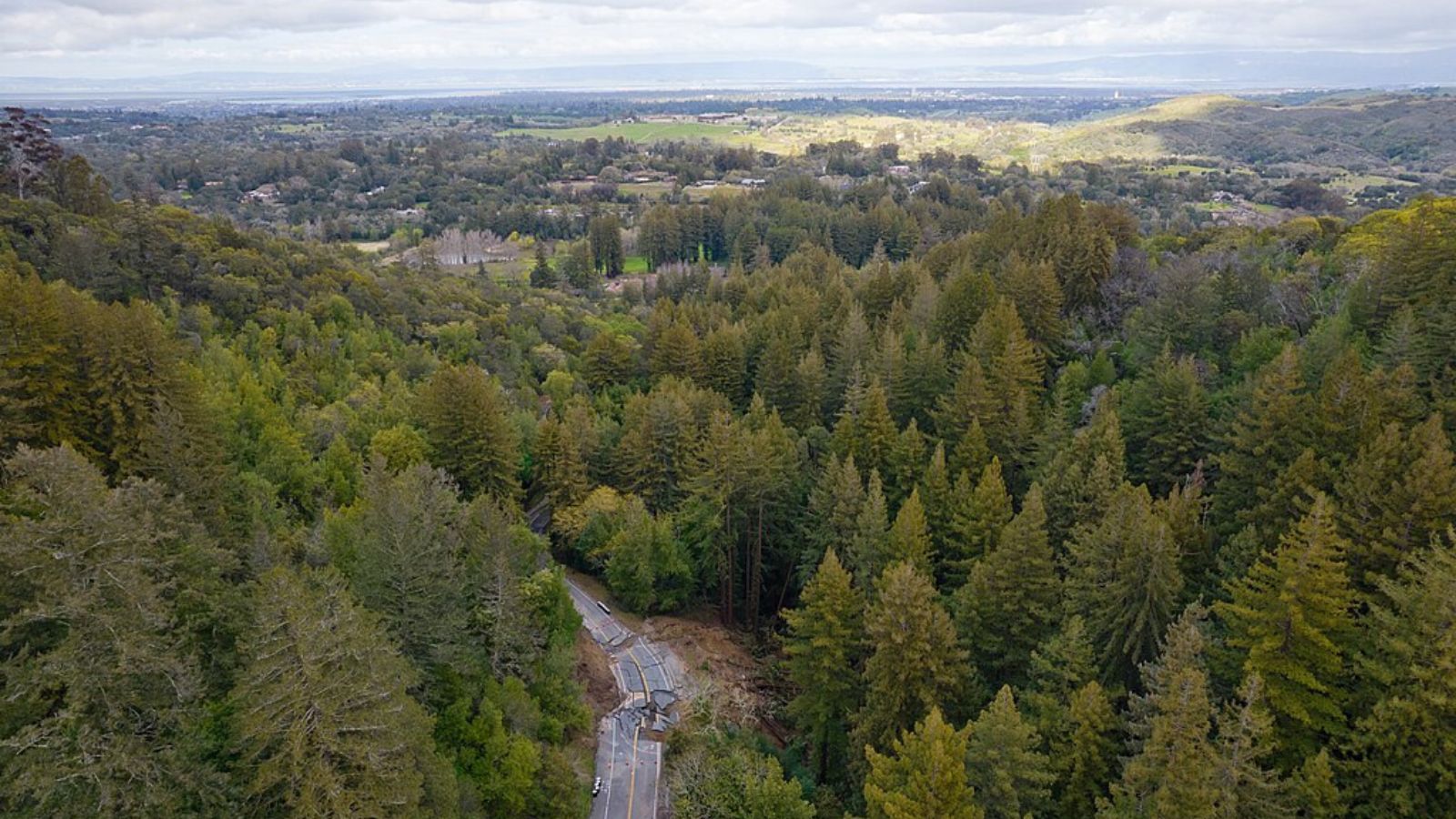
Why are people willing to pay so much to live here? What’s special about it?
Woodside offers expansive estates on heavily forested lots that provide privacy and rural character just minutes from Silicon Valley. The community attracts technology executives, venture capitalists, and entrepreneurs who value space, privacy, and natural beauty while maintaining access to business opportunities. Residents enjoy equestrian facilities, hiking trails, and custom homes designed to integrate with the natural environment.
The town’s appeal stems from its successful preservation of rural character through large-lot zoning and environmental protection that creates a countryside atmosphere within the Bay Area. Many properties span multiple acres with custom amenities including stables, tennis courts, and guest houses, providing resort-like living for affluent families. The combination of natural beauty, privacy, and proximity to wealth centers creates unique lifestyle value.
How Woodside Rose to Prominence
Woodside originated in the 1850s as a logging community that supplied redwood lumber to San Francisco’s growing population. The area’s natural beauty and proximity to the city attracted wealthy families who built country estates among the remaining forests. Early residents included lumber barons, railroad executives, and San Francisco business leaders who valued the area’s privacy and recreational opportunities.
The decline of logging in the early 1900s allowed the community to transform into an exclusive residential area focused on preserving natural character and rural lifestyle. The town’s incorporation in 1956 provided local control over development while the technology boom brought new residents with substantial wealth. Careful planning and environmental protection have maintained Woodside’s appeal to successive generations of business leaders and technology entrepreneurs.
3 Interesting Tidbits
1. Redwood Legacy – The town preserves ancient redwood groves that once supplied lumber for San Francisco’s reconstruction after the 1906 earthquake.
2. Venture Capital Hub – Many prominent venture capitalists and technology leaders maintain estates here, making it an informal center of Silicon Valley power and influence.
3. Equestrian Culture – The community maintains numerous horse trails and facilities, reflecting its rural heritage and appeal to residents who enjoy riding and horse ownership.
11. Saratoga – 198% Home Price Increase Since 2010
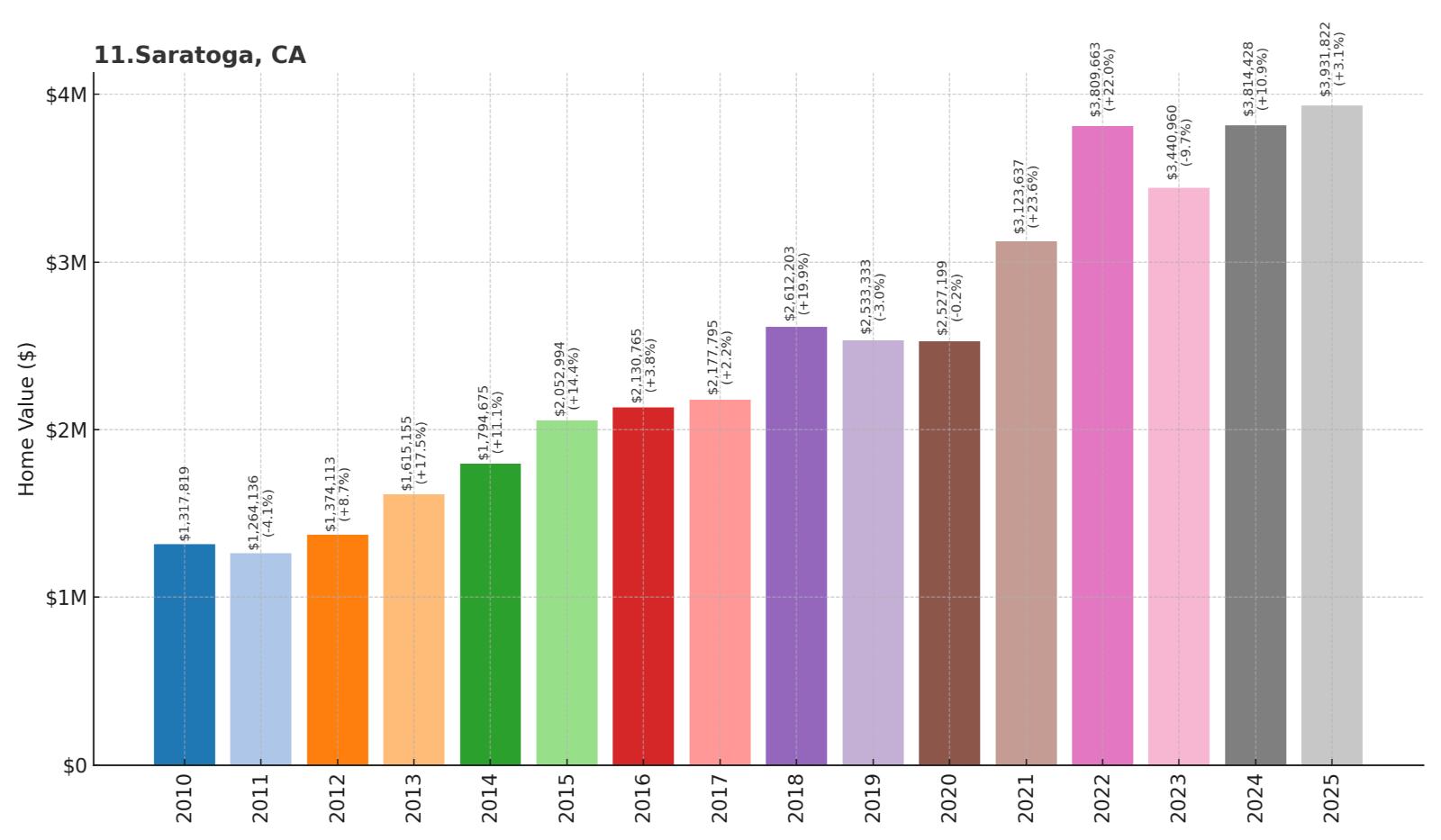
- 2010: $1,317,819
- 2011: $1,264,136
- 2012: $1,374,113
- 2013: $1,615,155
- 2014: $1,794,675
- 2015: $2,052,994
- 2016: $2,130,765
- 2017: $2,177,795
- 2018: $2,612,203
- 2019: $2,533,333
- 2020: $2,527,199
- 2021: $3,123,637
- 2022: $3,809,663
- 2023: $3,440,960
- 2024: $3,814,428
- 2025: $3,931,822
Saratoga has shown exceptional growth, nearly tripling from $1.3 million in 2010 to $3.9 million by 2025. The community experienced steady acceleration through the 2010s as Silicon Valley expansion drove demand for luxury suburban housing. Recent growth has pushed values above previous peaks, reflecting continued appeal of this Santa Clara County community among technology professionals and affluent families seeking excellent schools and natural beauty.
Why Saratoga?
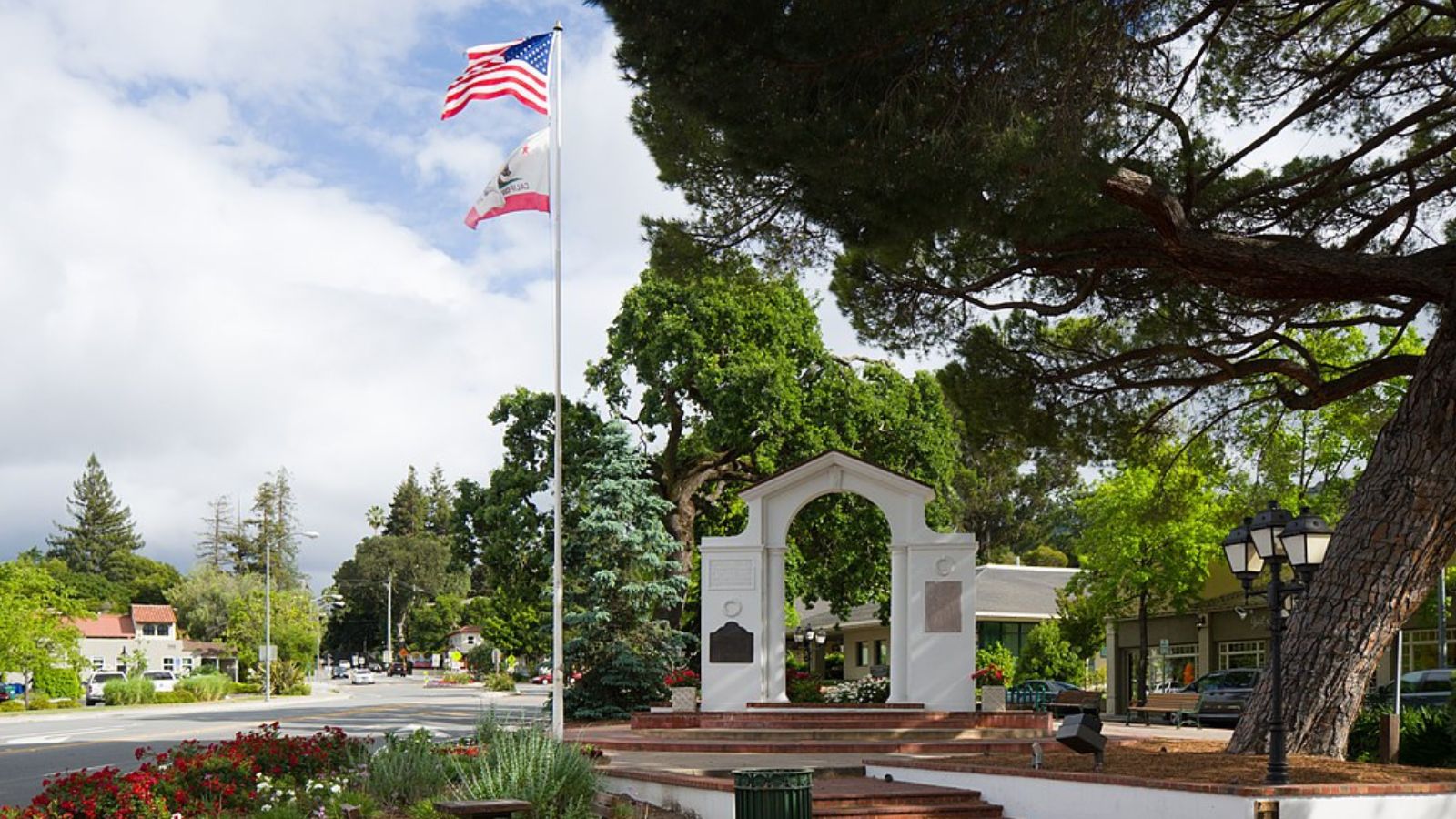
Why are people willing to pay so much to live here? What’s special about it?
Saratoga offers exceptional public schools, natural beauty, and proximity to Silicon Valley that creates an ideal environment for raising families in the technology industry. The community features rolling hills, parks, and open space while maintaining easy access to major technology companies and employment centers. Residents enjoy excellent cultural amenities including theaters, wineries, and recreational facilities while living in custom homes with panoramic valley views.
The city’s appeal stems from its successful balance of suburban sophistication and natural setting that attracts executives and professionals seeking family-friendly living. Many neighborhoods offer large lots with custom homes designed to take advantage of hillside locations and views, while excellent schools consistently rank among California’s best. The combination of educational quality, natural beauty, and technology industry access creates exceptional value for affluent families.
How Saratoga Rose to Prominence
Saratoga was founded in the 1850s as a lumber and agricultural community in the foothills of the Santa Cruz Mountains. The area’s natural springs and scenic location attracted visitors seeking health and recreation, leading to the development of resort hotels and spas. Early residents included farmers, loggers, and entrepreneurs who were drawn to the area’s natural resources and favorable climate.
The community’s transformation accelerated with Silicon Valley’s growth in the latter 20th century as technology professionals sought suburban alternatives to urban living. The establishment of excellent schools and recreational facilities attracted families while careful planning preserved the area’s natural character. Investment in cultural amenities and environmental protection has maintained Saratoga’s appeal to successive generations of affluent buyers seeking quality of life.
3 Interesting Tidbits
1. Cultural Hub – The Mountain Winery and Montalvo Arts Center provide world-class cultural programming including concerts, theater, and art exhibitions in stunning natural settings.
2. School Excellence – Saratoga High School consistently ranks among California’s top public schools, with graduates attending prestigious universities at exceptional rates.
3. Historic Charm – The historic downtown village maintains its small-town character with antique shops, cafes, and community events that bring residents together.
10. Portola Valley – 105% Home Price Increase Since 2010
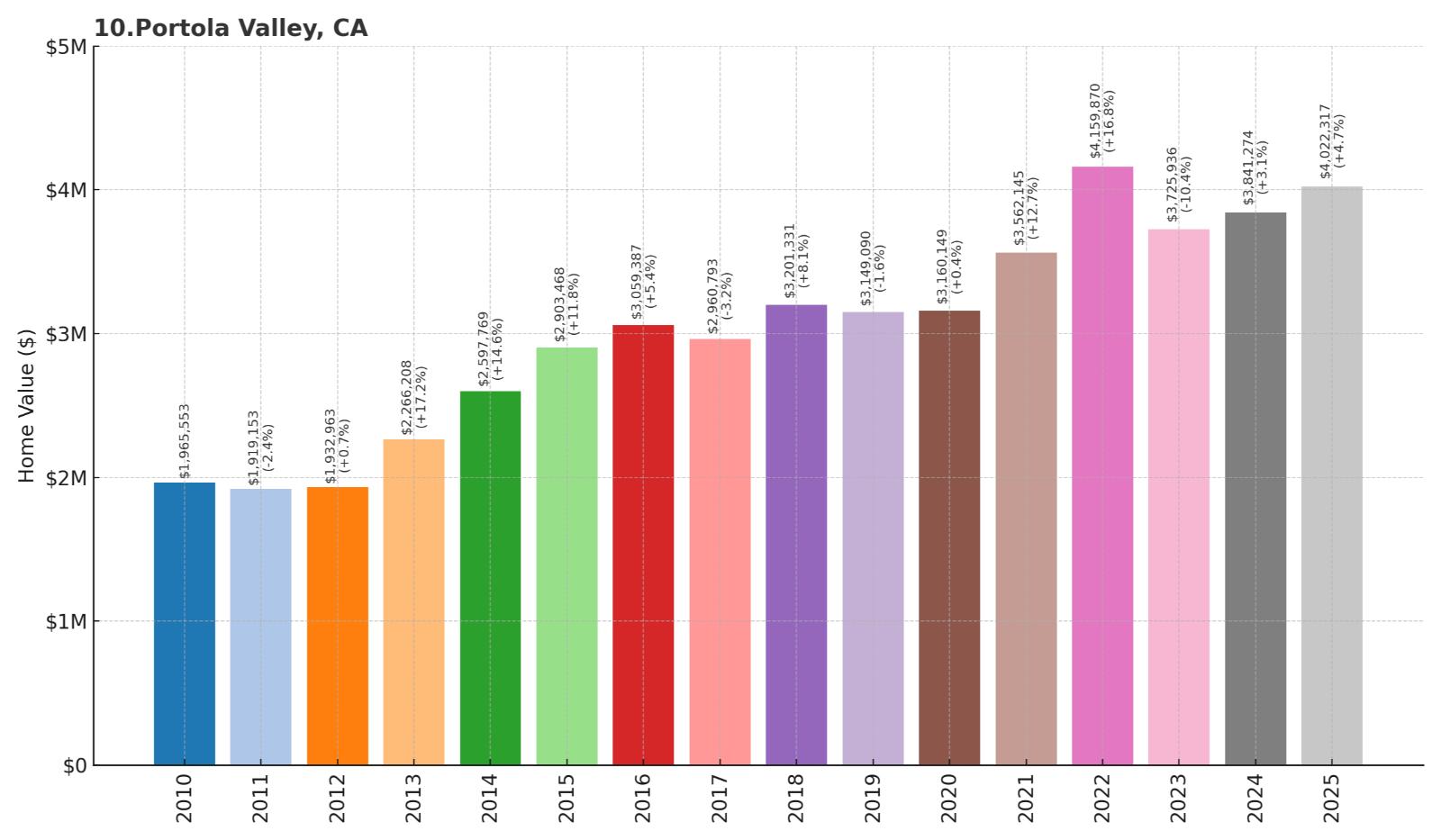
- 2010: $1,965,553
- 2011: $1,919,153
- 2012: $1,932,963
- 2013: $2,266,208
- 2014: $2,597,769
- 2015: $2,903,468
- 2016: $3,059,387
- 2017: $2,960,793
- 2018: $3,201,331
- 2019: $3,149,090
- 2020: $3,160,149
- 2021: $3,562,145
- 2022: $4,159,870
- 2023: $3,725,936
- 2024: $3,841,274
- 2025: $4,022,317
Portola Valley has more than doubled since 2010, starting from a high base of $2 million and reaching over $4 million by 2025. The community experienced steady growth through the 2010s followed by significant acceleration during pandemic years when values peaked above $4.1 million. This San Mateo County town represents one of the Peninsula’s most exclusive addresses, combining rural character with proximity to Stanford University and Silicon Valley.
Why Portola Valley?
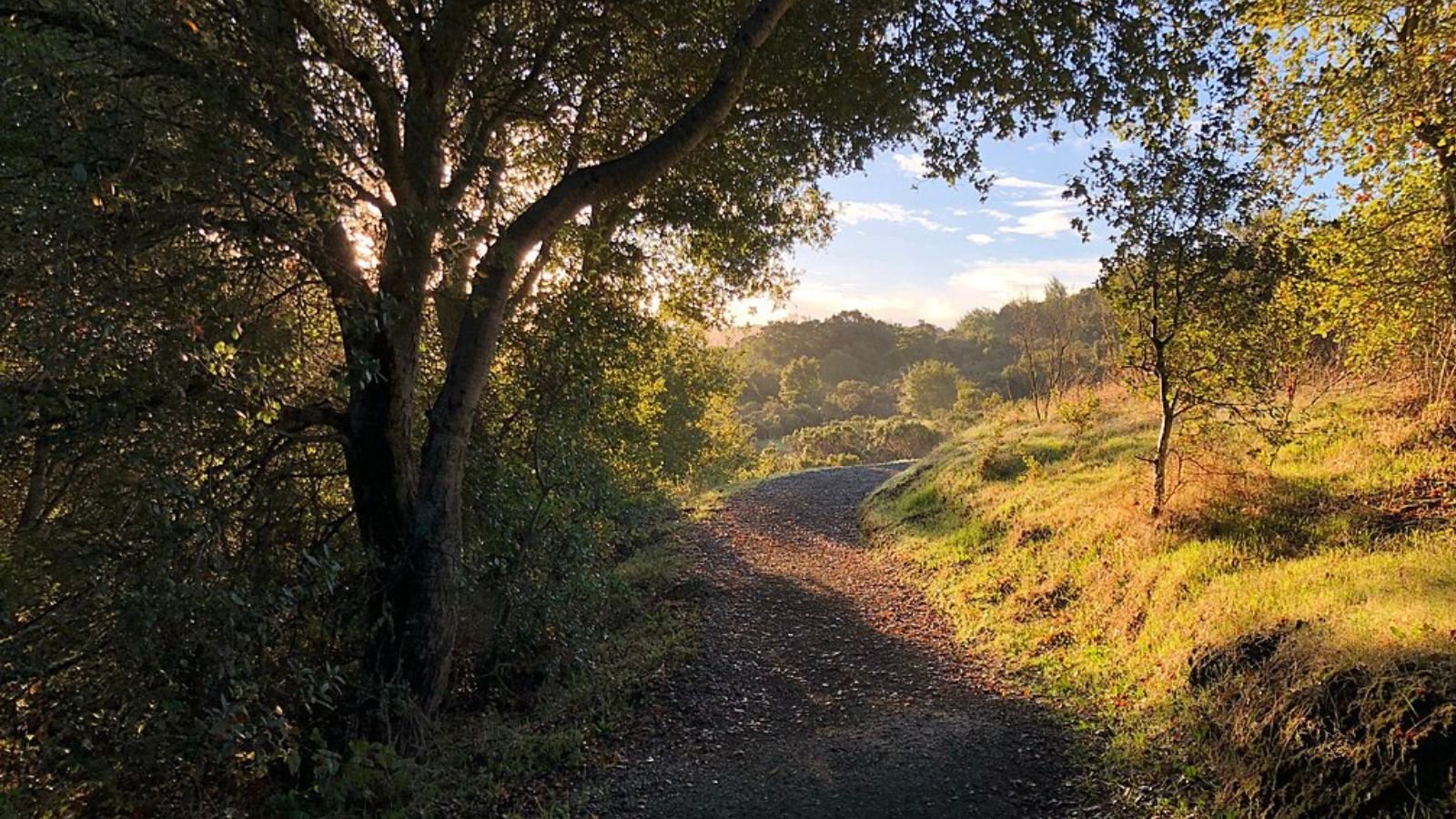
Why are people willing to pay so much to live here? What’s special about it?
Portola Valley offers expansive custom estates on large lots surrounded by protected open space and hiking trails that create a rural retreat atmosphere. The community attracts technology executives, venture capitalists, and Stanford faculty who value privacy, natural beauty, and proximity to innovation centers. Residents enjoy equestrian facilities, excellent schools, and custom homes designed to integrate with the natural environment while maintaining access to world-class universities and businesses.
The town’s exclusivity stems from its limited development and environmental protection that preserves rural character within the wealthy Peninsula corridor. Many properties span multiple acres with custom amenities including stables, tennis courts, and guest houses, providing resort-like living for affluent families. The combination of natural beauty, privacy, educational access, and proximity to wealth centers creates exceptional lifestyle value that justifies premium pricing.
How Portola Valley Rose to Prominence
Portola Valley was established in the 1920s as an exclusive residential community designed to preserve the area’s natural character while providing luxury living for wealthy Peninsula families. Early development centered around country estates and recreational facilities that attracted San Francisco business leaders and Stanford faculty seeking rural alternatives to urban living. The community’s founders established strict zoning and architectural controls that maintained its exclusive character.
The area’s proximity to Stanford University and emerging technology companies made it increasingly attractive to academics and business leaders throughout the 20th century. The town’s incorporation in 1964 provided local control over development while environmental protection preserved open space and rural atmosphere. Continued investment in schools and recreational facilities has maintained Portola Valley’s appeal to successive generations of wealthy professionals seeking privacy and natural beauty.
3 Interesting Tidbits
1. Open Space Paradise – Over 60% of the town consists of protected open space and parks, providing extensive hiking and equestrian trails for residents.
2. Architectural Heritage – Many homes were designed by renowned architects and feature custom details that reflect the area’s commitment to quality and natural integration.
3. Educational Excellence – The community’s proximity to Stanford University creates unique educational and cultural opportunities for residents of all ages.
9. Monte Sereno – 165% Home Price Increase Since 2010
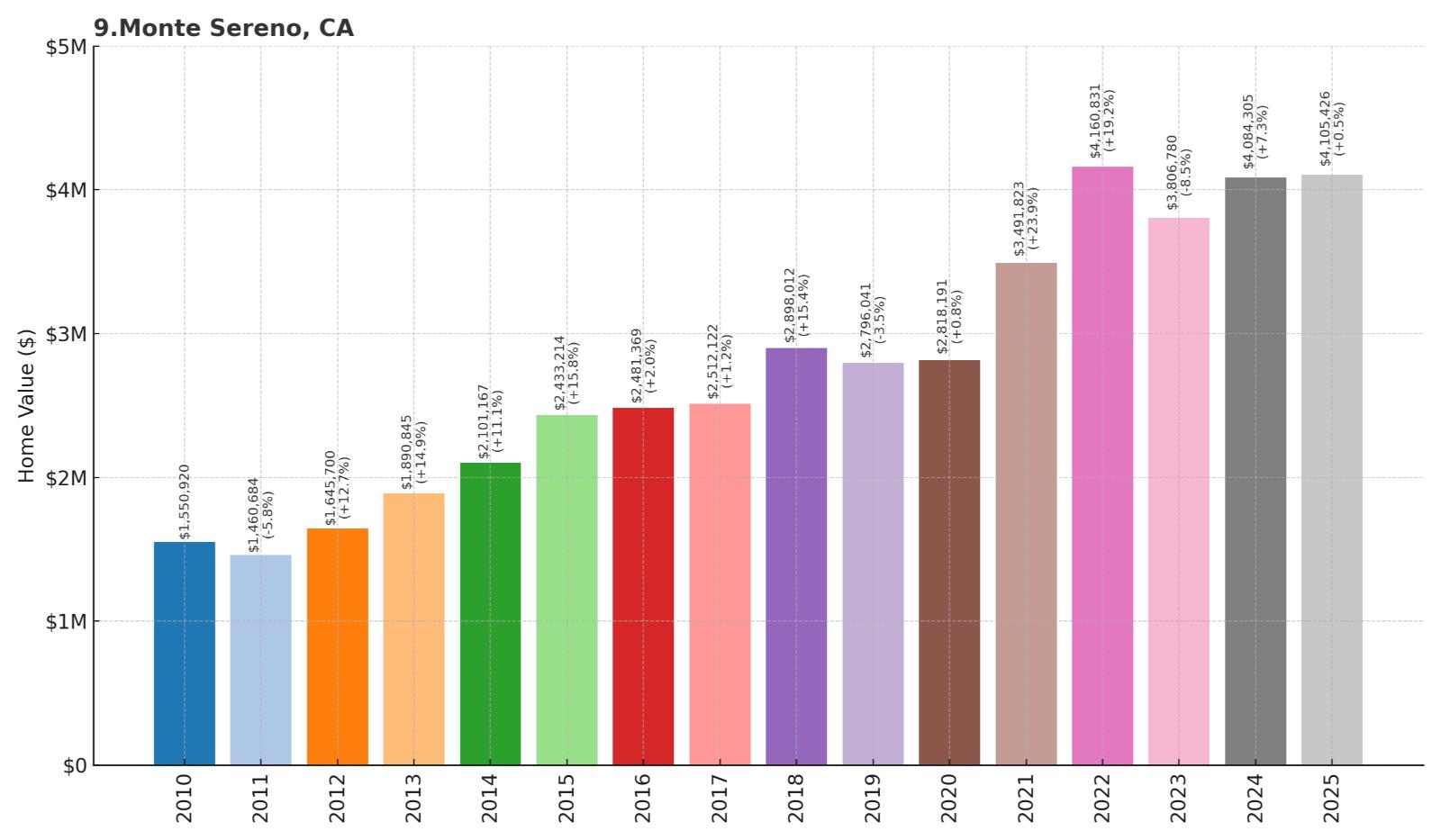
- 2010: $1,550,920
- 2011: $1,460,684
- 2012: $1,645,700
- 2013: $1,890,845
- 2014: $2,101,167
- 2015: $2,433,214
- 2016: $2,481,369
- 2017: $2,512,122
- 2018: $2,898,012
- 2019: $2,796,041
- 2020: $2,818,191
- 2021: $3,491,823
- 2022: $4,160,831
- 2023: $3,806,780
- 2024: $4,084,305
- 2025: $4,105,426
Monte Sereno has shown strong growth, rising from $1.6 million in 2010 to over $4.1 million by 2025. The community experienced steady appreciation through the 2010s followed by exceptional acceleration during pandemic years. This small Santa Clara County city has maintained values above $4 million, reflecting continued appeal among technology professionals and affluent families seeking luxury suburban living in the Silicon Valley foothills.
Why Monte Sereno?
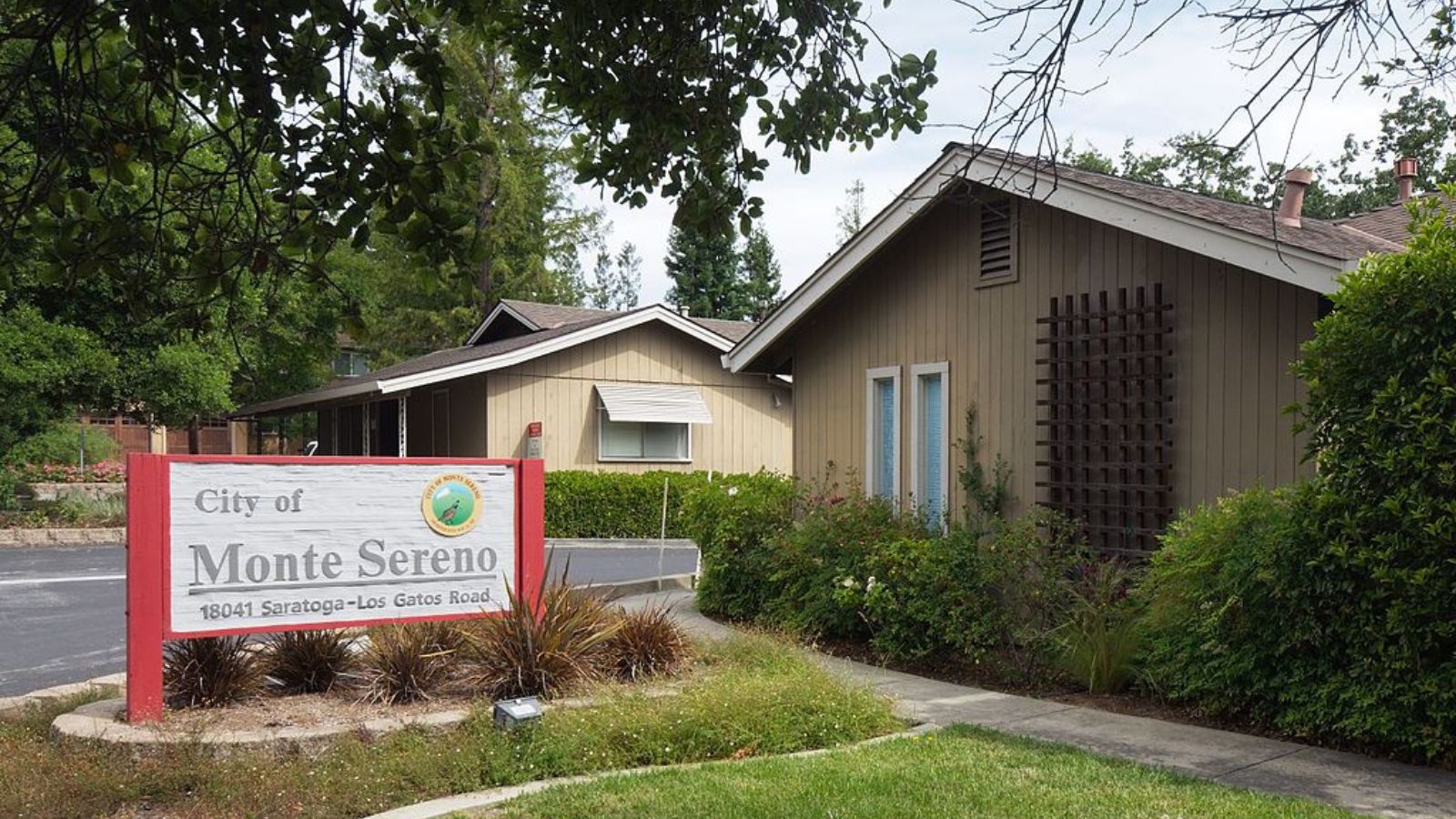
Why are people willing to pay so much to live here? What’s special about it?
Monte Sereno offers large custom estates on heavily wooded lots that provide privacy and natural beauty within Silicon Valley’s technology corridor. The community attracts executives and entrepreneurs who value space, excellent schools, and proximity to major technology companies and venture capital firms. Residents enjoy hillside locations with panoramic views while maintaining access to world-class dining, shopping, and cultural amenities in nearby Los Gatos and Saratoga.
The city’s exclusivity stems from its small size and strict development controls that preserve its residential character and natural setting. Many properties feature custom architecture and luxury amenities including pools, tennis courts, and guest houses, creating resort-like environments for affluent families. The combination of natural beauty, privacy, educational quality, and technology industry access creates exceptional value for buyers seeking luxury suburban living.
How Monte Sereno Rose to Prominence
Monte Sereno was incorporated in 1957 as a small residential community designed to preserve rural character while providing luxury living for affluent Silicon Valley families. The area’s hillside location and natural beauty attracted executives and professionals seeking alternatives to denser suburban developments. Early residents established strict zoning and architectural controls that maintained the community’s exclusive atmosphere and property values.
The community’s growth paralleled Silicon Valley’s expansion as technology companies attracted wealthy professionals seeking high-quality residential environments. The establishment of excellent schools and preservation of natural areas enhanced Monte Sereno’s appeal to families while limited development maintained exclusivity. Careful planning and community investment have preserved the area’s character while property values have appreciated dramatically due to sustained demand and limited supply.
3 Interesting Tidbits
1. Tiny but Mighty – Monte Sereno is one of California’s smallest incorporated cities by area, with only 1.6 square miles and about 3,500 residents.
2. Natural Setting – The city is nestled in the foothills of the Santa Cruz Mountains, providing a forested environment with numerous hiking trails and natural areas.
3. Tech Proximity – Despite its rural feel, the community is within minutes of major technology companies and Silicon Valley’s venture capital corridor.
8. Rancho Santa Fe – 132% Home Price Increase Since 2010
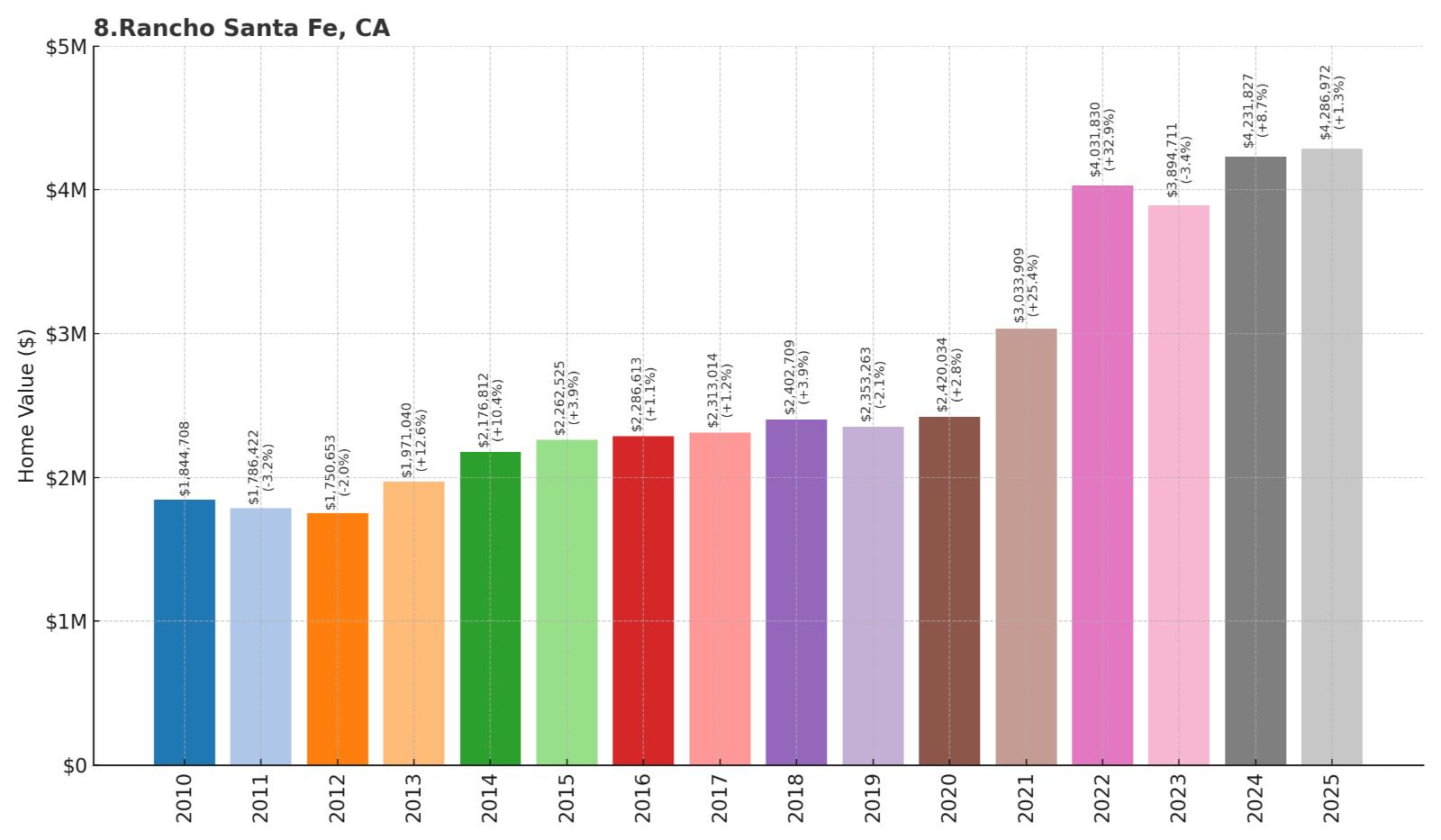
- 2010: $1,844,708
- 2011: $1,786,422
- 2012: $1,750,653
- 2013: $1,971,040
- 2014: $2,176,812
- 2015: $2,262,525
- 2016: $2,286,613
- 2017: $2,313,014
- 2018: $2,402,709
- 2019: $2,353,263
- 2020: $2,420,034
- 2021: $3,033,909
- 2022: $4,031,830
- 2023: $3,894,711
- 2024: $4,231,827
- 2025: $4,286,972
Rancho Santa Fe has more than doubled since 2010, rising from $1.8 million to over $4.2 million by 2025. The community experienced steady but modest growth through most of the 2010s followed by dramatic acceleration during and after the pandemic years. This San Diego County enclave represents one of California’s most prestigious planned communities, combining luxury living with equestrian culture and natural preservation.
Why Rancho Santa Fe?

Why are people willing to pay so much to live here? What’s special about it?
Rancho Santa Fe offers expansive custom estates on large lots within a master-planned community that preserves natural beauty and equestrian heritage. The community attracts executives, retirees, and celebrities who value privacy, space, and recreational amenities including golf courses, riding trails, and tennis facilities. Residents enjoy Mediterranean-style architecture and landscaping while maintaining access to San Diego’s beaches, cultural attractions, and business centers.
The area’s exclusivity stems from its comprehensive planning and architectural controls that maintain community character while preserving property values. Many estates span multiple acres with custom amenities including stables, guest houses, and recreational facilities that create resort-like living environments. The combination of natural beauty, recreational opportunities, privacy, and proximity to major metropolitan amenities creates exceptional lifestyle value for affluent buyers.
How Rancho Santa Fe Rose to Prominence
Rancho Santa Fe was developed in the 1920s by the Santa Fe Railway as a planned community designed to showcase California’s potential for luxury residential development. The original plan emphasized large lots, architectural controls, and preservation of natural character while providing recreational amenities including golf courses and equestrian facilities. Early residents included business leaders, celebrities, and wealthy families seeking a sophisticated rural lifestyle.
The community’s careful development and architectural standards attracted successive generations of affluent buyers who valued its unique combination of luxury and natural setting. The establishment of excellent schools and recreational facilities enhanced its appeal to families while continued investment in infrastructure and amenities maintained property values. Rancho Santa Fe’s reputation as a celebrity enclave and luxury destination has sustained demand among wealthy buyers seeking prestigious addresses.
3 Interesting Tidbits
1. Planned Perfection – The community was one of America’s first master-planned developments, with comprehensive architectural guidelines that continue to preserve its Mediterranean character.
2. Celebrity Haven – The area has been home to numerous celebrities, athletes, and business leaders who value its privacy and luxury amenities.
3. Equestrian Heritage – The community maintains extensive bridle trails and equestrian facilities, reflecting its long tradition of horse ownership and rural lifestyle.
7. Los Altos – 209% Home Price Increase Since 2010
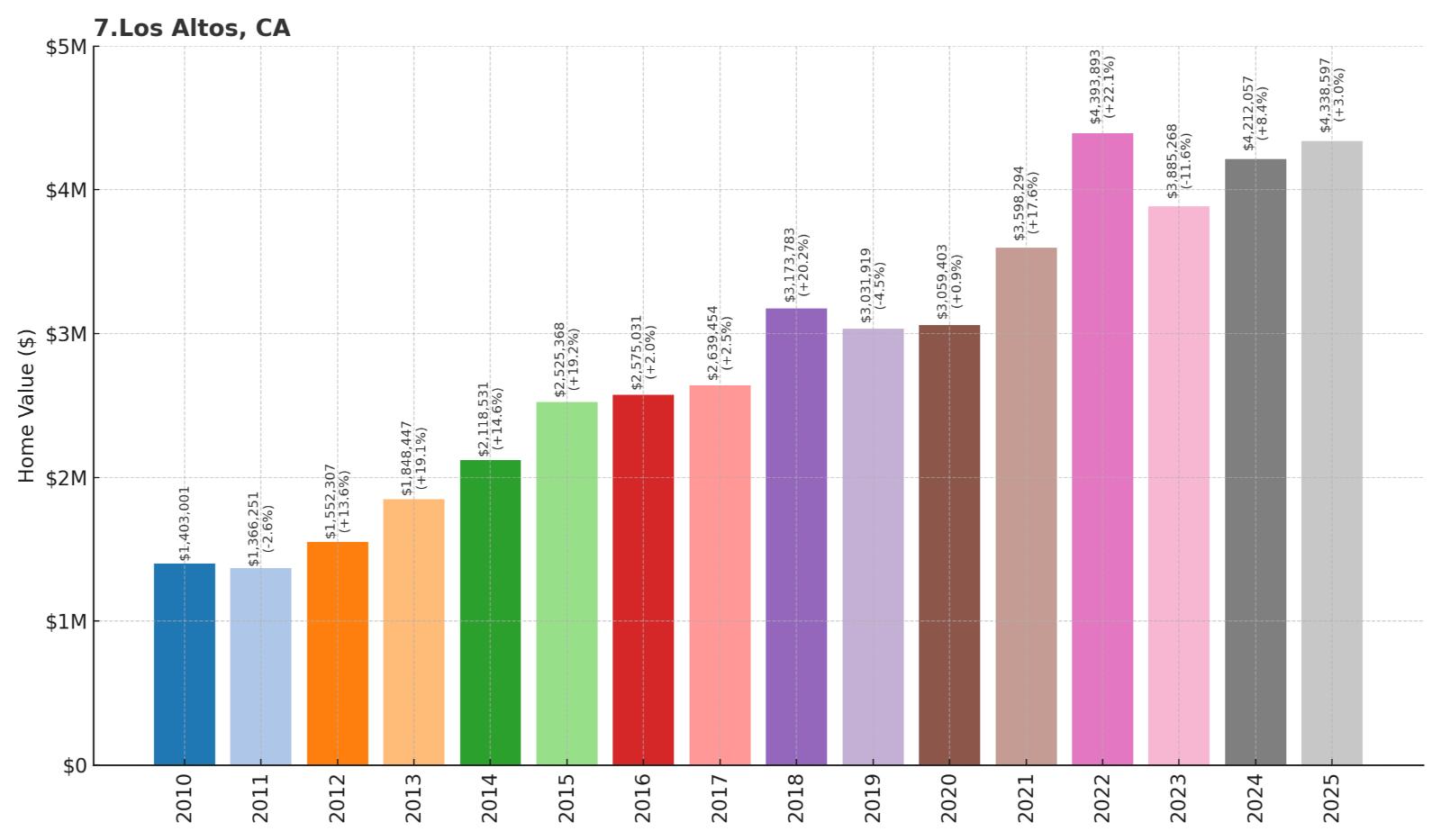
- 2010: $1,403,001
- 2011: $1,366,251
- 2012: $1,552,307
- 2013: $1,848,447
- 2014: $2,118,531
- 2015: $2,525,368
- 2016: $2,575,031
- 2017: $2,639,454
- 2018: $3,173,783
- 2019: $3,031,919
- 2020: $3,059,403
- 2021: $3,598,294
- 2022: $4,393,893
- 2023: $3,885,268
- 2024: $4,212,057
- 2025: $4,338,597
Los Altos has shown exceptional growth, more than tripling from $1.4 million in 2010 to over $4.3 million by 2025. The community experienced steady acceleration through the 2010s as Silicon Valley expansion drove demand for family-oriented luxury housing. Despite some volatility in recent years, Los Altos remains one of the Peninsula’s most sought-after residential addresses for technology professionals and affluent families seeking excellent schools and suburban sophistication.
Why Los Altos?
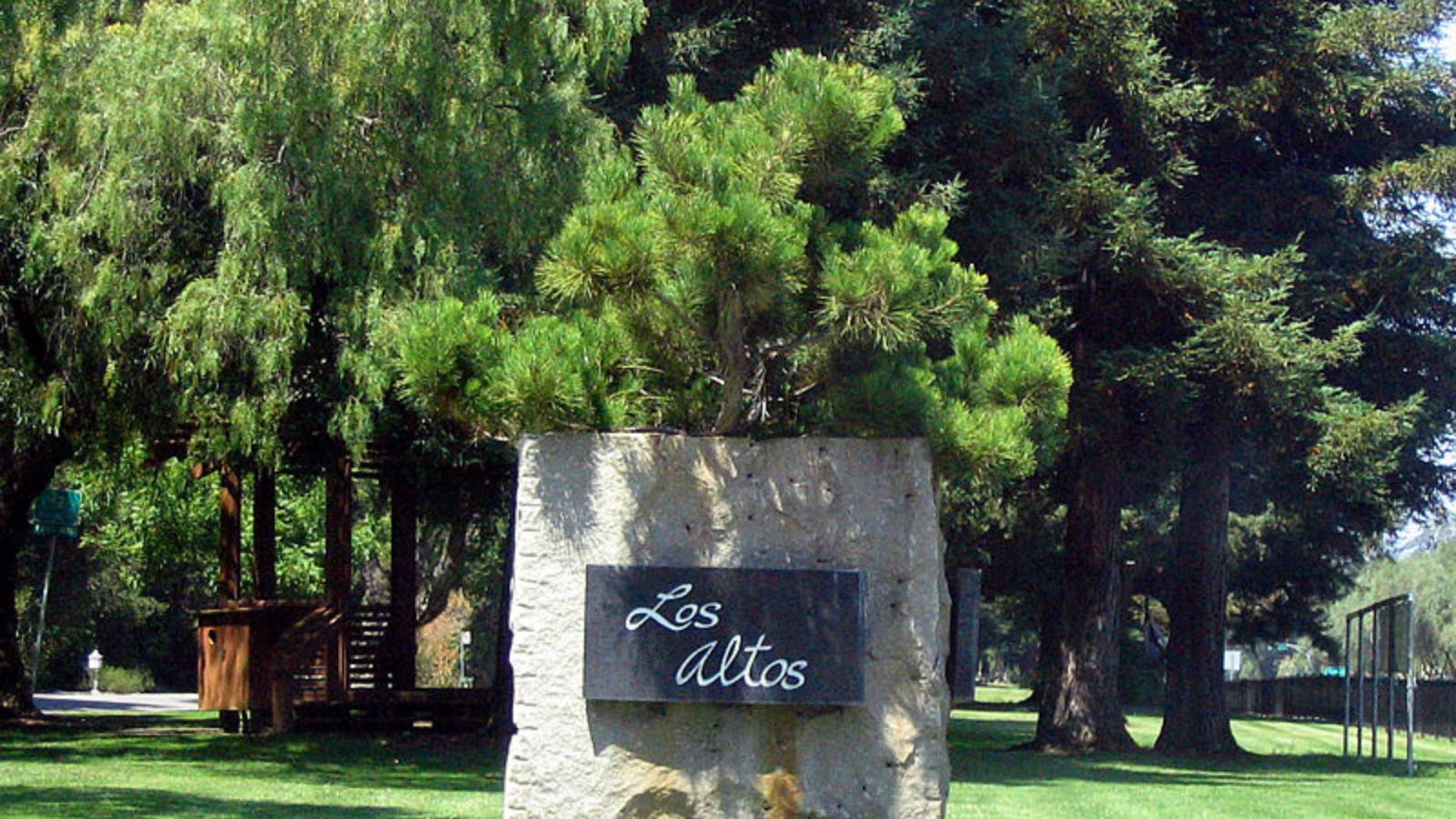
Why are people willing to pay so much to live here? What’s special about it?
Los Altos offers exceptional public schools, family-friendly neighborhoods, and proximity to Silicon Valley that creates an ideal environment for raising children in the technology industry. The community features tree-lined streets, parks, and excellent recreational facilities while maintaining easy access to major technology companies and employment centers. Residents enjoy a sophisticated suburban lifestyle with custom homes, excellent dining, and cultural amenities that appeal to educated professionals.
The city’s appeal stems from its successful balance of suburban convenience and educational excellence that attracts executives and professionals seeking family-oriented living. Many neighborhoods offer larger lots with custom homes designed for entertaining and family life, while excellent schools consistently rank among California’s best. The combination of educational quality, community amenities, and technology industry access creates exceptional value for affluent families willing to invest in their children’s futures.
How Los Altos Rose to Prominence
Los Altos was incorporated in 1952 as a suburban community designed to provide family-oriented living for professionals working in the emerging technology industry. The area’s development was carefully planned to preserve natural character while providing excellent schools and recreational facilities. Early residents included engineers, entrepreneurs, and business leaders who were attracted to the combination of suburban amenities and proximity to employment opportunities.
The community’s growth paralleled Silicon Valley’s expansion as technology companies attracted wealthy professionals seeking high-quality residential environments for their families. The establishment of exceptional schools and investment in recreational facilities enhanced Los Altos’ appeal while careful planning maintained its suburban character. The city’s association with technology industry success and educational excellence has sustained demand among affluent buyers seeking family-oriented luxury living.
3 Interesting Tidbits
1. Tech Heritage – Apple Computer was founded in a Los Altos garage by Steve Jobs and Steve Wozniak in 1976, making it a birthplace of personal computing revolution.
2. School Excellence – Los Altos schools consistently rank in the top 1% of California public schools, with graduates attending prestigious universities at exceptional rates.
3. Family Focus – The city maintains numerous parks, recreational programs, and family-oriented amenities that create an ideal environment for raising children in the technology industry.
6. Belvedere – 91% Home Price Increase Since 2010

- 2010: $2,322,563
- 2011: $2,137,193
- 2012: $2,405,381
- 2013: $2,709,870
- 2014: $2,981,625
- 2015: $3,358,315
- 2016: $3,573,050
- 2017: $3,691,485
- 2018: $3,786,668
- 2019: $3,743,209
- 2020: $3,656,839
- 2021: $4,382,802
- 2022: $4,973,768
- 2023: $4,669,790
- 2024: $4,522,053
- 2025: $4,439,152
Belvedere has nearly doubled since 2010, starting from a high base of $2.3 million and reaching $4.4 million by 2025. The community experienced steady growth through the 2010s followed by significant acceleration during pandemic years when values peaked near $5 million. This Marin County island community represents one of California’s most exclusive waterfront addresses, combining stunning bay views with small-town intimacy and proximity to San Francisco.
Why Belvedere?
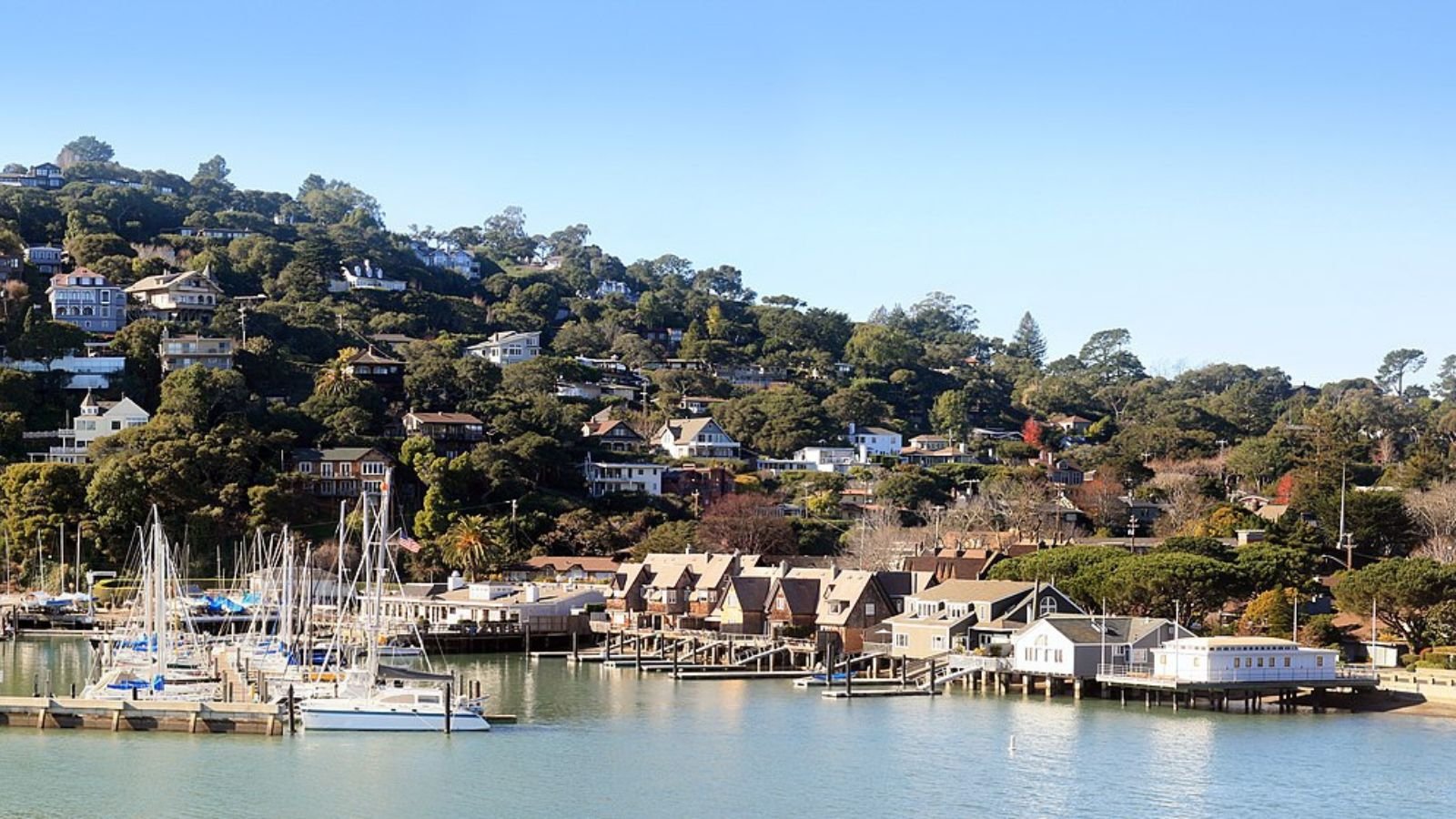
Why are people willing to pay so much to live here? What’s special about it?
Belvedere offers unparalleled San Francisco Bay views from a unique island location that provides privacy and exclusivity impossible to find elsewhere in the Bay Area. The community features custom waterfront homes with private docks and beaches while maintaining a small-town atmosphere with excellent schools and recreational facilities. Residents enjoy sailing, hiking, and outdoor activities while commuting easily to San Francisco employment and cultural centers via nearby ferry service.
The island’s appeal stems from its limited land area and waterfront location that creates scarcity and exceptional natural beauty for property owners. Many homes feature panoramic views of San Francisco, the Golden Gate Bridge, and surrounding bay waters, with architectural designs that maximize outdoor living and water access. The combination of natural beauty, exclusivity, and proximity to major metropolitan amenities creates unique lifestyle value that justifies premium pricing.
How Belvedere Rose to Prominence
Belvedere was developed in the early 1900s as an exclusive residential community designed to take advantage of its unique island location and spectacular bay views. Early residents included San Francisco business leaders who built elaborate summer homes and eventually permanent residences on the scenic peninsula. The community’s development was carefully controlled to preserve natural beauty while providing luxury amenities for wealthy families.
The area’s incorporation as a city in 1896 provided local control over development while the construction of the Richmond-San Rafael Bridge improved access to San Francisco employment centers. Post-war prosperity brought new residents who valued the combination of natural beauty, privacy, and metropolitan access. Continued investment in infrastructure and careful development planning has maintained Belvedere’s appeal to successive generations of affluent buyers seeking waterfront luxury.
3 Interesting Tidbits
1. Island Paradise – Belvedere is connected to the mainland by a narrow causeway, creating an island-like atmosphere with water on three sides and spectacular bay views.
2. Yacht Club Legacy – The San Francisco Yacht Club, founded in 1869, has its home base on Belvedere Island and provides world-class sailing facilities for residents.
3. Architectural Gems – Many homes were designed by renowned architects and feature unique designs that take advantage of waterfront locations and panoramic views.
5. Hidden Hills – 191% Home Price Increase Since 2010
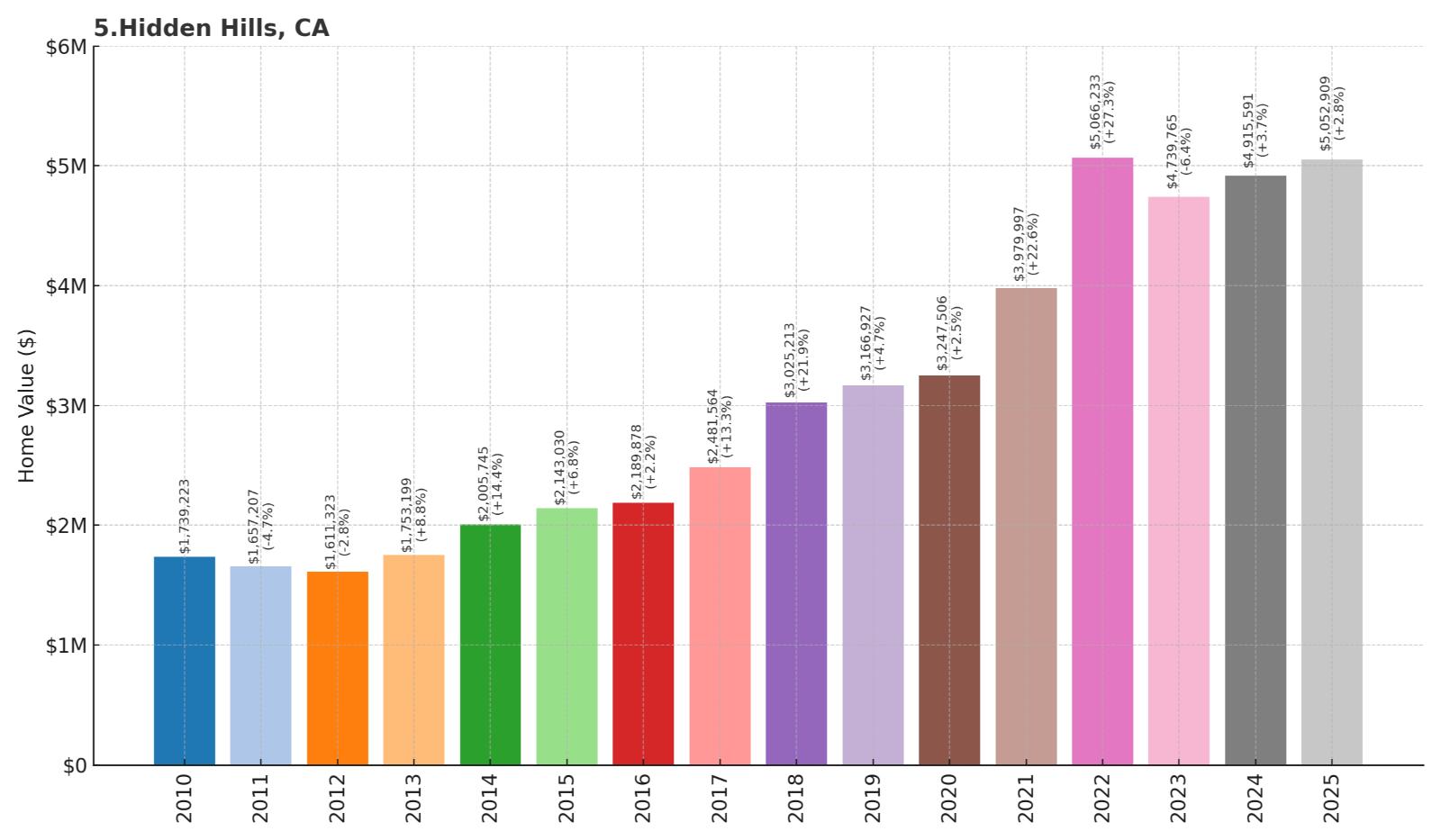
- 2010: $1,739,223
- 2011: $1,657,207
- 2012: $1,611,323
- 2013: $1,753,199
- 2014: $2,005,745
- 2015: $2,143,030
- 2016: $2,189,878
- 2017: $2,481,564
- 2018: $3,025,213
- 2019: $3,166,927
- 2020: $3,247,506
- 2021: $3,979,997
- 2022: $5,066,233
- 2023: $4,739,765
- 2024: $4,915,591
- 2025: $5,052,909
Hidden Hills has shown dramatic growth, nearly tripling from $1.7 million in 2010 to over $5 million by 2025. The community experienced steady appreciation through the 2010s followed by exceptional acceleration during pandemic years. This exclusive Los Angeles County enclave has maintained values above $5 million, reflecting sustained demand from celebrities, executives, and affluent families seeking ultimate privacy and luxury within the metropolitan area.
Why Hidden Hills?

Why are people willing to pay so much to live here? What’s special about it?
Hidden Hills offers ultimate privacy and security within a gated community that attracts celebrities, executives, and affluent families seeking seclusion from public attention. The community features expansive custom estates on large lots with equestrian facilities, pools, and luxury amenities that create resort-like living environments. Residents enjoy rural atmosphere with horse trails and open space while maintaining access to Los Angeles entertainment industry and business centers.
The area’s exclusivity stems from its gated structure and strict security measures that provide privacy impossible to find in other Los Angeles communities. Many properties span multiple acres with custom architecture and luxury amenities including guest houses, tennis courts, and entertainment facilities. The combination of privacy, luxury, space, and proximity to entertainment industry creates unique lifestyle value that appeals to high-profile buyers willing to pay premium prices for seclusion.
How Hidden Hills Rose to Prominence
Hidden Hills was developed in the 1950s as a planned equestrian community designed to provide rural lifestyle within Los Angeles County’s suburban expansion. The original development emphasized large lots, horse facilities, and natural preservation while maintaining access to entertainment industry employment centers. Early residents included entertainment executives, celebrities, and business leaders who valued privacy and space while maintaining career connections.
The community’s gated structure and security measures attracted celebrities seeking refuge from public attention while the equestrian facilities appealed to families wanting rural lifestyle. The establishment of excellent schools and recreational amenities enhanced Hidden Hills’ appeal while continued investment in security and infrastructure maintained its exclusive character. The area’s association with entertainment industry success has sustained demand among high-profile buyers seeking privacy and luxury.
3 Interesting Tidbits
1. Celebrity Central – The community has been home to numerous A-list celebrities including the Kardashian family, Drake, and many other entertainment industry figures.
2. Equestrian Paradise – All properties must accommodate horses, and the community maintains extensive bridle trails that create a rural atmosphere within urban Los Angeles.
3. Ultimate Privacy – The gated community structure and security measures provide levels of privacy and protection that attract high-profile residents seeking seclusion.
4. Hillsborough – 141% Home Price Increase Since 2010
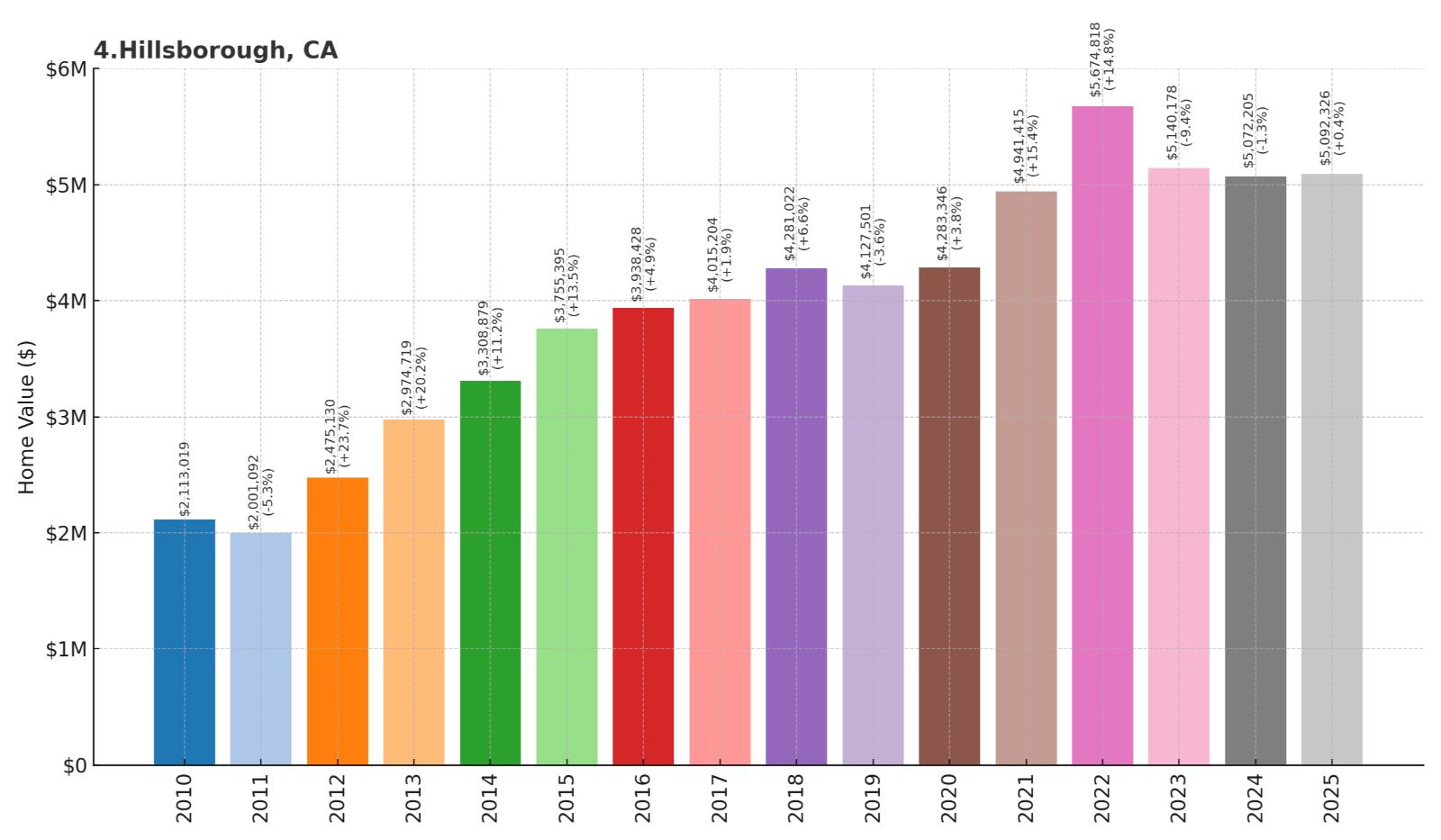
- 2010: $2,113,019
- 2011: $2,001,092
- 2012: $2,475,130
- 2013: $2,974,719
- 2014: $3,308,879
- 2015: $3,755,395
- 2016: $3,938,428
- 2017: $4,015,204
- 2018: $4,281,022
- 2019: $4,127,501
- 2020: $4,283,346
- 2021: $4,941,415
- 2022: $5,674,818
- 2023: $5,140,178
- 2024: $5,072,205
- 2025: $5,092,326
Hillsborough has more than doubled since 2010, starting from a substantial base of $2.1 million and reaching $5.1 million by 2025. The community experienced consistent growth through the 2010s followed by significant acceleration during pandemic years when values peaked above $5.6 million. This San Mateo County town represents one of the Peninsula’s most established wealthy communities, combining old-money elegance with proximity to Silicon Valley innovation centers.
Why Hillsborough?
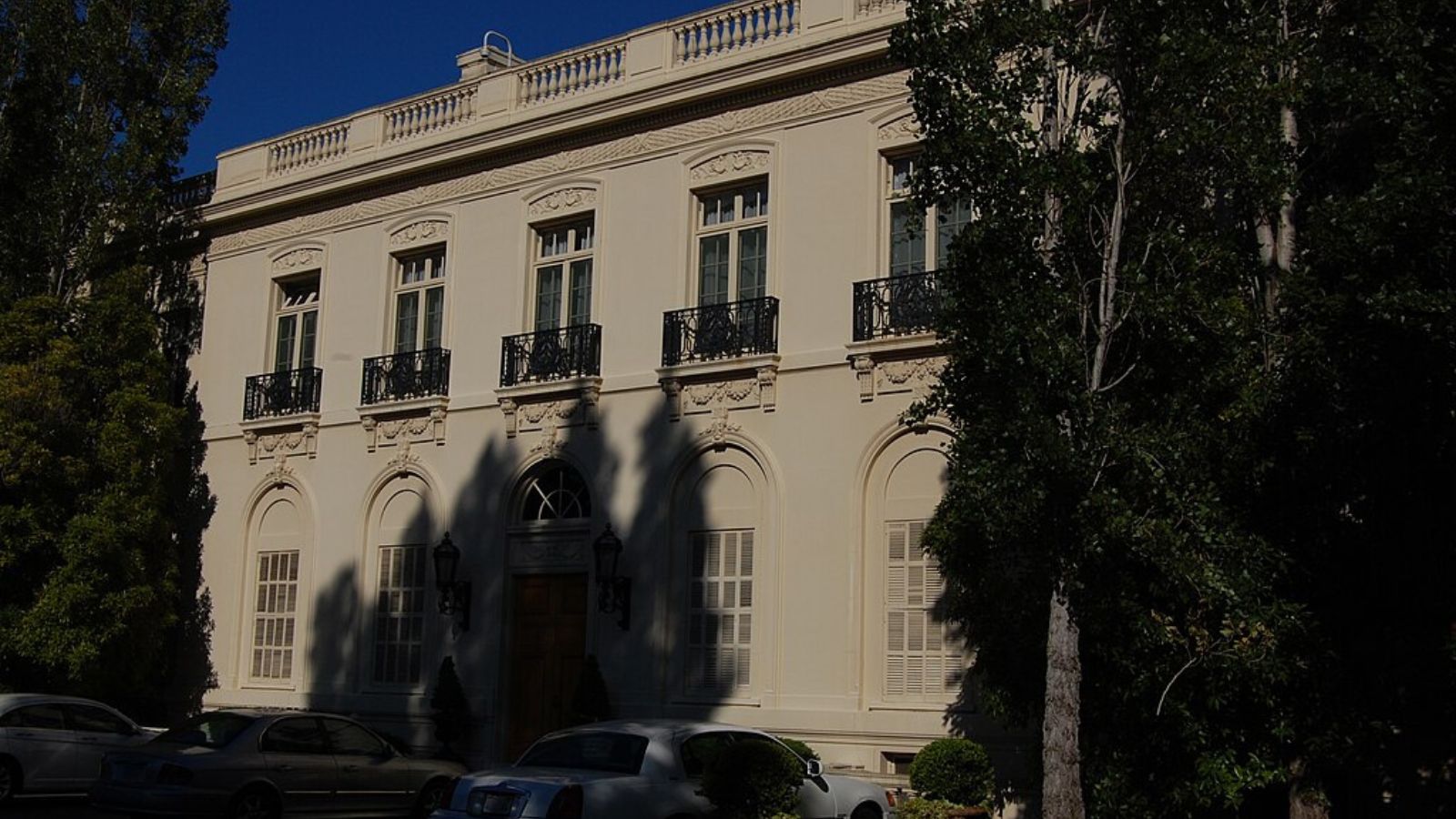
Why are people willing to pay so much to live here? What’s special about it?
Hillsborough offers grand estates on large lots within a community that has maintained its exclusive character for over a century. The town attracts old-money families, technology executives, and international buyers who value tradition, privacy, and prestigious addresses within the Bay Area. Residents enjoy beautifully landscaped properties, excellent schools, and sophisticated amenities while maintaining easy access to San Francisco and Silicon Valley employment centers.
The community’s appeal stems from its long history of wealth and sophistication that creates unparalleled prestige value for property owners. Many estates feature historic architecture and mature landscaping that reflect generations of careful stewardship, while strict zoning maintains property values and character. The combination of tradition, natural beauty, educational excellence, and proximity to wealth centers creates exceptional lifestyle value that justifies premium pricing.
How Hillsborough Rose to Prominence
Hillsborough was incorporated in 1910 as an exclusive residential community designed to attract San Francisco’s wealthiest families seeking suburban estates while maintaining business connections to the city. Early residents included railroad barons, banking executives, and industrial leaders who built elaborate mansions on large lots designed by renowned architects. The community’s development established patterns of luxury and exclusivity that continue today.
The town’s careful planning and architectural controls attracted successive generations of wealthy families while the proximity to emerging technology centers brought new residents with substantial resources. Investment in excellent schools and recreational facilities enhanced Hillsborough’s appeal while environmental protection preserved natural beauty. The community’s reputation for tradition and sophistication has maintained its status as one of California’s most prestigious addresses.
3 Interesting Tidbits
1. Mansion Legacy – The town features numerous historic mansions designed by renowned architects including Julia Morgan, who also designed Hearst Castle.
2. Country Club Culture – Hillsborough Country Club, established in 1924, provides world-class golf and social facilities that enhance the community’s exclusive atmosphere.
3. School Excellence – The Hillsborough City School District consistently ranks among California’s best, attracting families who prioritize educational quality.
3. Montecito – 135% Home Price Increase Since 2010
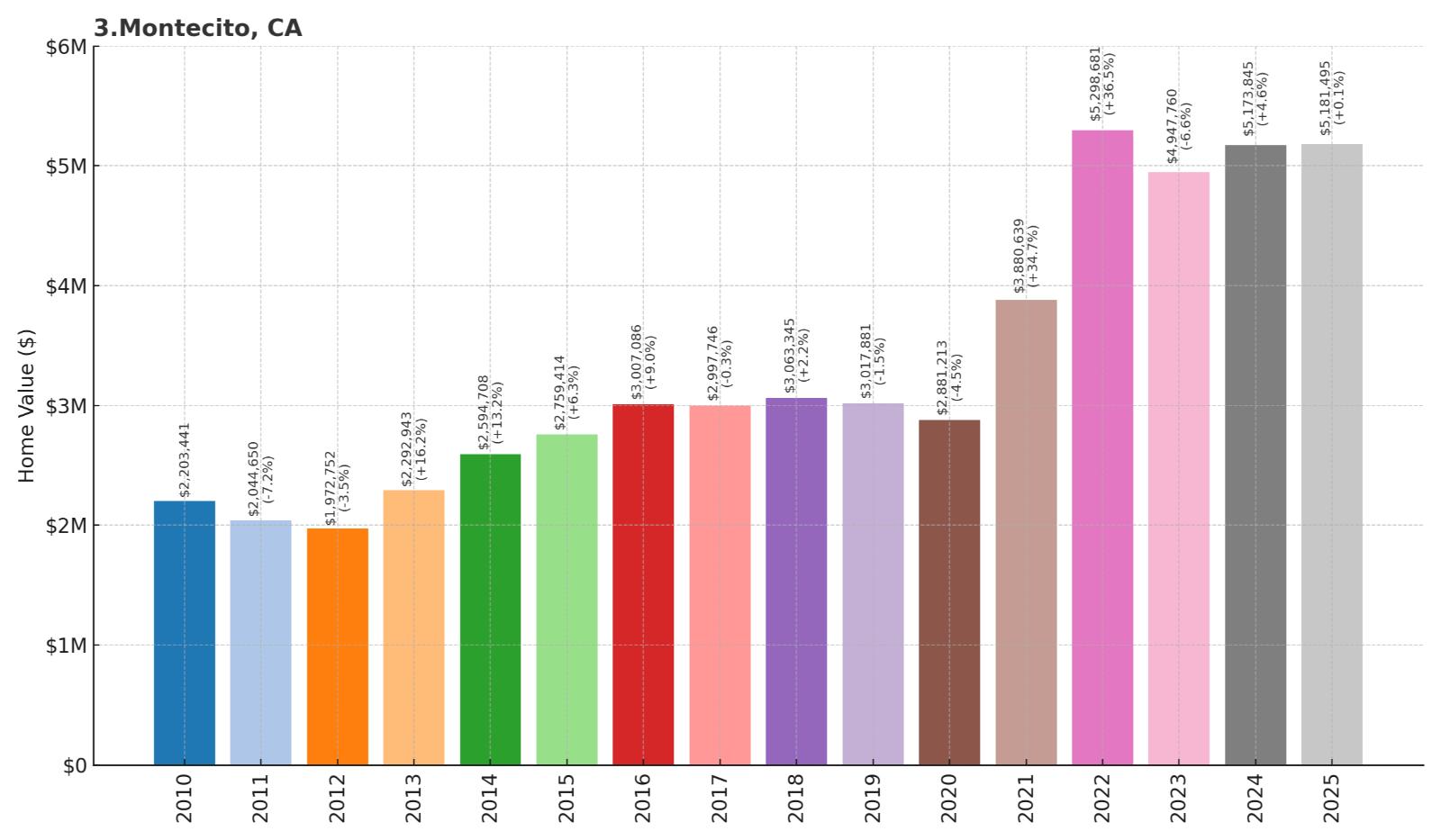
- 2010: $2,203,441
- 2011: $2,044,650
- 2012: $1,972,752
- 2013: $2,292,943
- 2014: $2,594,708
- 2015: $2,759,414
- 2016: $3,007,086
- 2017: $2,997,746
- 2018: $3,063,345
- 2019: $3,017,881
- 2020: $2,881,213
- 2021: $3,880,639
- 2022: $5,298,681
- 2023: $4,947,760
- 2024: $5,173,845
- 2025: $5,181,495
Montecito has more than doubled since 2010, rising from $2.2 million to over $5.1 million by 2025. The community experienced modest growth through most of the 2010s followed by dramatic acceleration during pandemic years. This Santa Barbara County enclave represents one of California’s most prestigious coastal communities, combining celebrity culture with natural beauty and Mediterranean-style luxury living that appeals to affluent buyers seeking coastal sophistication.
Why Montecito?

Why are people willing to pay so much to live here? What’s special about it?
Montecito offers a unique combination of celebrity culture, pristine beaches, and Mediterranean climate that creates an aspirational lifestyle destination. The community attracts Hollywood celebrities, business executives, and wealthy retirees who value privacy, natural beauty, and luxury amenities within a sophisticated coastal setting. Residents enjoy world-class dining, shopping, and cultural attractions while living in custom estates with ocean views and private beach access.
The area’s exclusivity stems from its natural boundaries and limited development between mountains and ocean that creates scarcity and exceptional beauty. Many properties offer dramatic ocean and mountain views with custom architecture designed to maximize outdoor living and natural integration. The combination of celebrity appeal, natural beauty, cultural sophistication, and coastal lifestyle creates unique prestige value that justifies premium pricing for affluent buyers.
How Montecito Rose to Prominence
Montecito developed in the late 1800s as a winter resort destination for wealthy East Coast families seeking California’s favorable climate and natural beauty. The construction of luxury hotels and the arrival of railroad connections attracted prominent families who built elaborate estates among the area’s oak trees and coastal bluffs. Early residents included industrialists, railroad executives, and entertainment pioneers who valued the community’s natural setting and exclusive atmosphere.
The area’s transformation into a celebrity enclave accelerated during Hollywood’s golden age when movie stars discovered its privacy and luxury amenities. Post-war development brought new residents while careful planning preserved the community’s character and natural beauty. The establishment of world-class cultural institutions and continued investment in luxury amenities has maintained Montecito’s appeal to successive generations of wealthy buyers seeking coastal prestige.
3 Interesting Tidbits
1. Celebrity Haven – The community has been home to numerous A-list celebrities including Oprah Winfrey, Ellen DeGeneres, and many other entertainment industry figures.
2. Resort Heritage – The historic Montecito Inn, built in 1928 by Charlie Chaplin, reflects the area’s long association with Hollywood glamour and luxury hospitality.
3. Natural Beauty – The community is situated between the Santa Ynez Mountains and Pacific Ocean, creating dramatic landscapes and microclimates that support diverse gardens and outdoor living.
2. Los Altos Hills – 134% Home Price Increase Since 2010
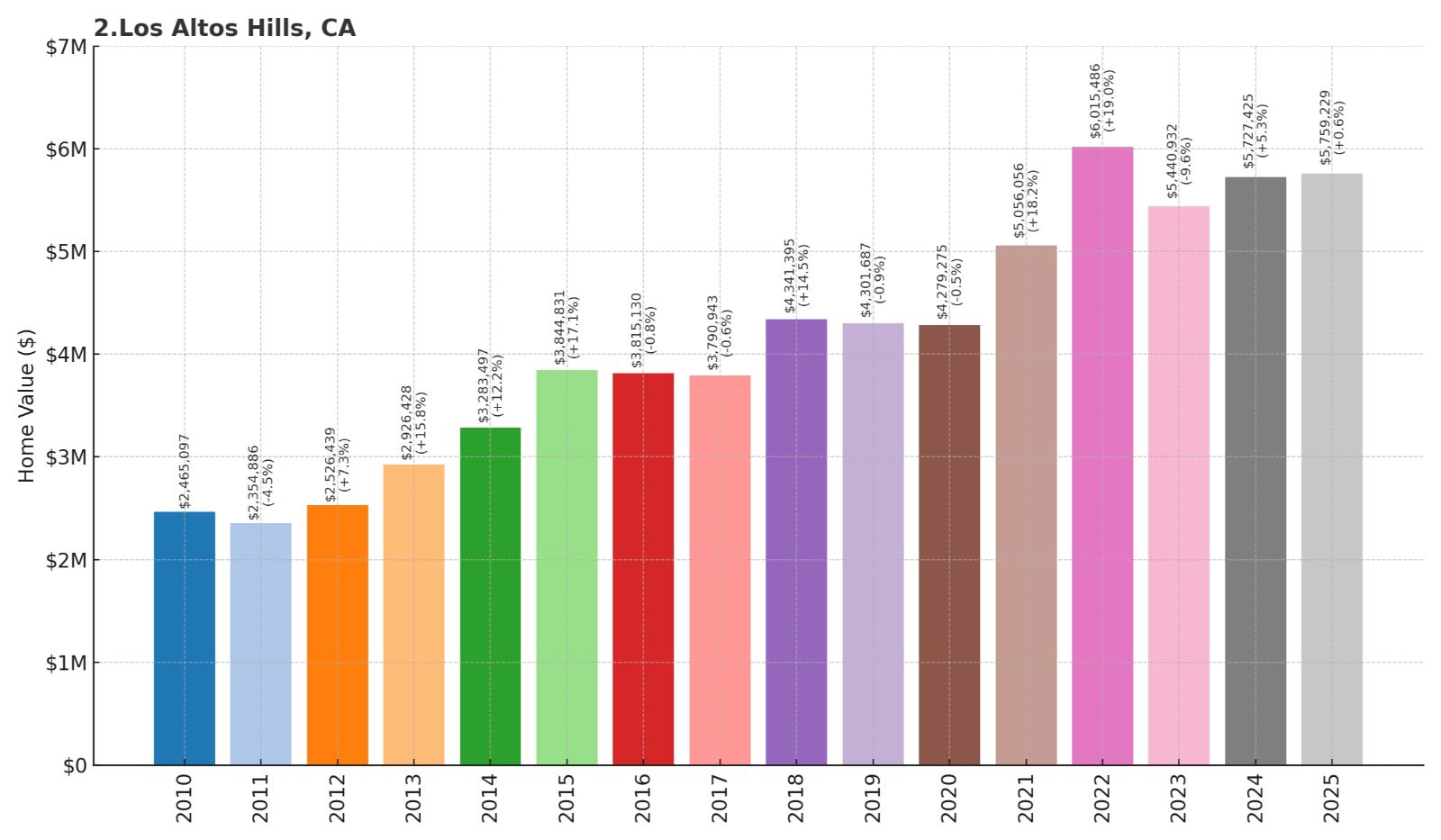
- 2010: $2,465,097
- 2011: $2,354,886
- 2012: $2,526,439
- 2013: $2,926,428
- 2014: $3,283,497
- 2015: $3,844,831
- 2016: $3,815,130
- 2017: $3,790,943
- 2018: $4,341,395
- 2019: $4,301,687
- 2020: $4,279,275
- 2021: $5,056,056
- 2022: $6,015,486
- 2023: $5,440,932
- 2024: $5,727,425
- 2025: $5,759,229
Los Altos Hills has more than doubled since 2010, starting from a high base of $2.5 million and reaching $5.8 million by 2025. The community experienced steady growth through the 2010s followed by exceptional acceleration during pandemic years when values peaked above $6 million. This Santa Clara County enclave represents the pinnacle of Silicon Valley residential luxury, combining technology industry wealth with natural beauty and privacy that appeals to the region’s most successful entrepreneurs and executives.
Why Los Altos Hills?

Why are people willing to pay so much to live here? What’s special about it?
Los Altos Hills offers expansive custom estates on large hillside lots that provide panoramic Silicon Valley views and ultimate privacy for technology industry leaders. The community attracts successful entrepreneurs, executives, and venture capitalists who value space, natural beauty, and proximity to innovation centers. Residents enjoy custom homes with luxury amenities, excellent schools, and recreational facilities while maintaining access to world-class business opportunities and cultural attractions.
The town’s exclusivity stems from its limited development and strict zoning that preserves rural character within the heart of Silicon Valley wealth creation. Many properties span multiple acres with custom architecture designed to take advantage of hillside locations and views, while environmental protection maintains natural beauty. The combination of technology industry proximity, natural setting, privacy, and investment potential creates exceptional value for buyers seeking the ultimate in Silicon Valley luxury living.
How Los Altos Hills Rose to Prominence
Los Altos Hills was incorporated in 1956 as an exclusive residential community designed to preserve rural character while providing luxury living for Silicon Valley’s emerging technology leaders. The area’s hillside location and natural beauty attracted executives and entrepreneurs seeking alternatives to suburban tract development. Early residents established strict zoning and environmental controls that maintained the community’s exclusive atmosphere and natural setting.
The community’s growth paralleled Silicon Valley’s expansion as technology companies created unprecedented wealth and attracted global talent to the region. Investment in excellent schools and recreational facilities enhanced Los Altos Hills’ appeal while careful development planning preserved its character. The area’s association with technology industry success and innovation has sustained demand among wealthy buyers seeking prestigious addresses within the world’s technology capital.
3 Interesting Tidbits
1. Tech Titans – The community has been home to numerous technology industry leaders including Google executives, venture capitalists, and successful entrepreneurs.
2. Natural Preserve – Much of the town consists of protected open space and parks that provide hiking trails and preserve the area’s rural character.
3. Architectural Excellence – Many homes were designed by renowned architects and feature custom details that reflect the area’s commitment to quality and natural integration.
1. Atherton – 147% Home Price Increase Since 2010
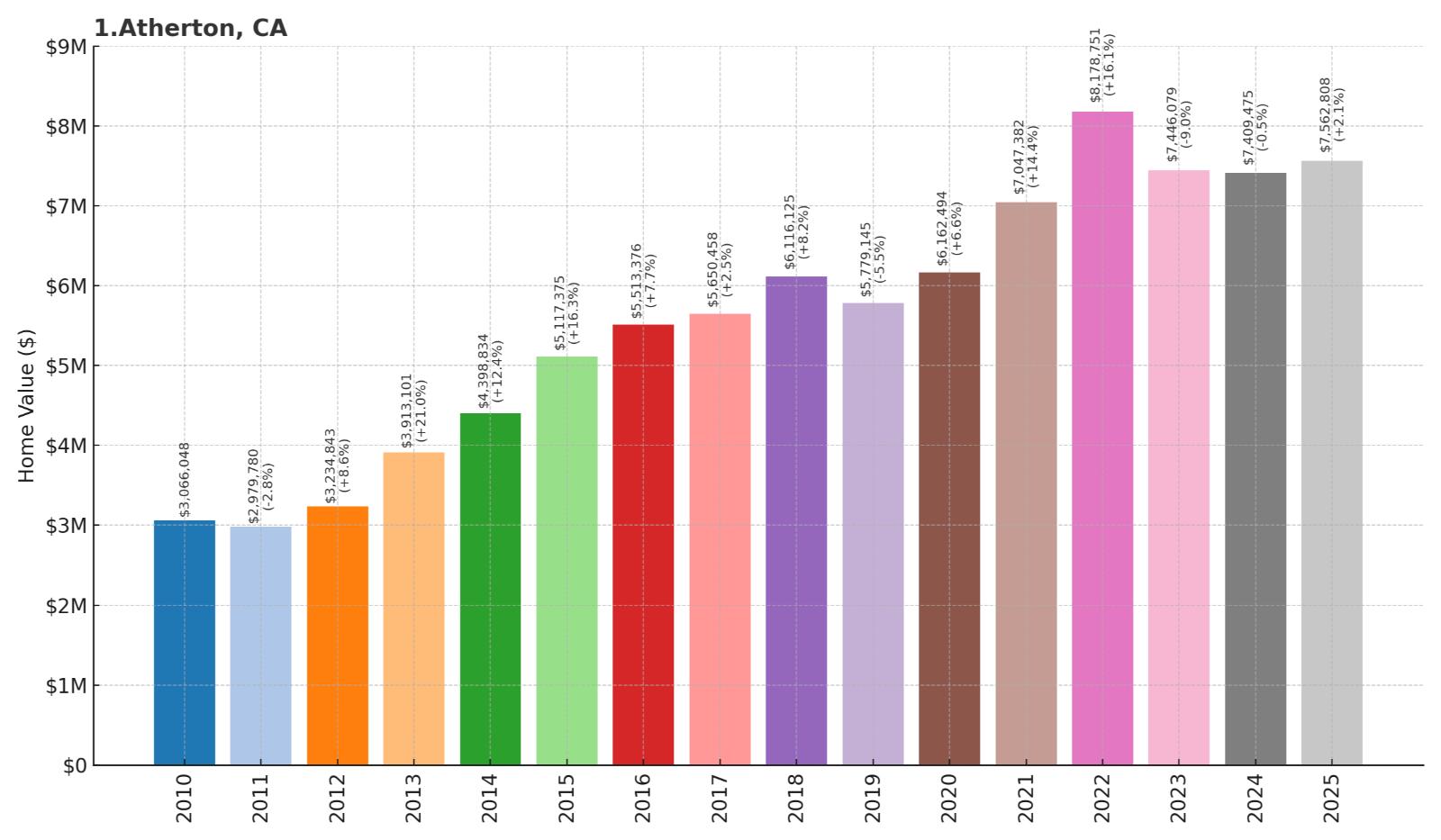
- 2010: $3,066,048
- 2011: $2,979,780
- 2012: $3,234,843
- 2013: $3,913,101
- 2014: $4,398,834
- 2015: $5,117,375
- 2016: $5,513,376
- 2017: $5,650,458
- 2018: $6,116,125
- 2019: $5,779,145
- 2020: $6,162,494
- 2021: $7,047,382
- 2022: $8,178,751
- 2023: $7,446,079
- 2024: $7,409,475
- 2025: $7,562,808
Atherton has more than doubled since 2010, starting from an already substantial base of $3.1 million and reaching $7.6 million by 2025. The community experienced consistent growth through the 2010s followed by exceptional acceleration during pandemic years when values peaked above $8.1 million. This San Mateo County town represents the absolute pinnacle of American residential real estate, combining Silicon Valley wealth with privacy and sophistication that attracts the nation’s most successful technology leaders and entrepreneurs.
Why Atherton?
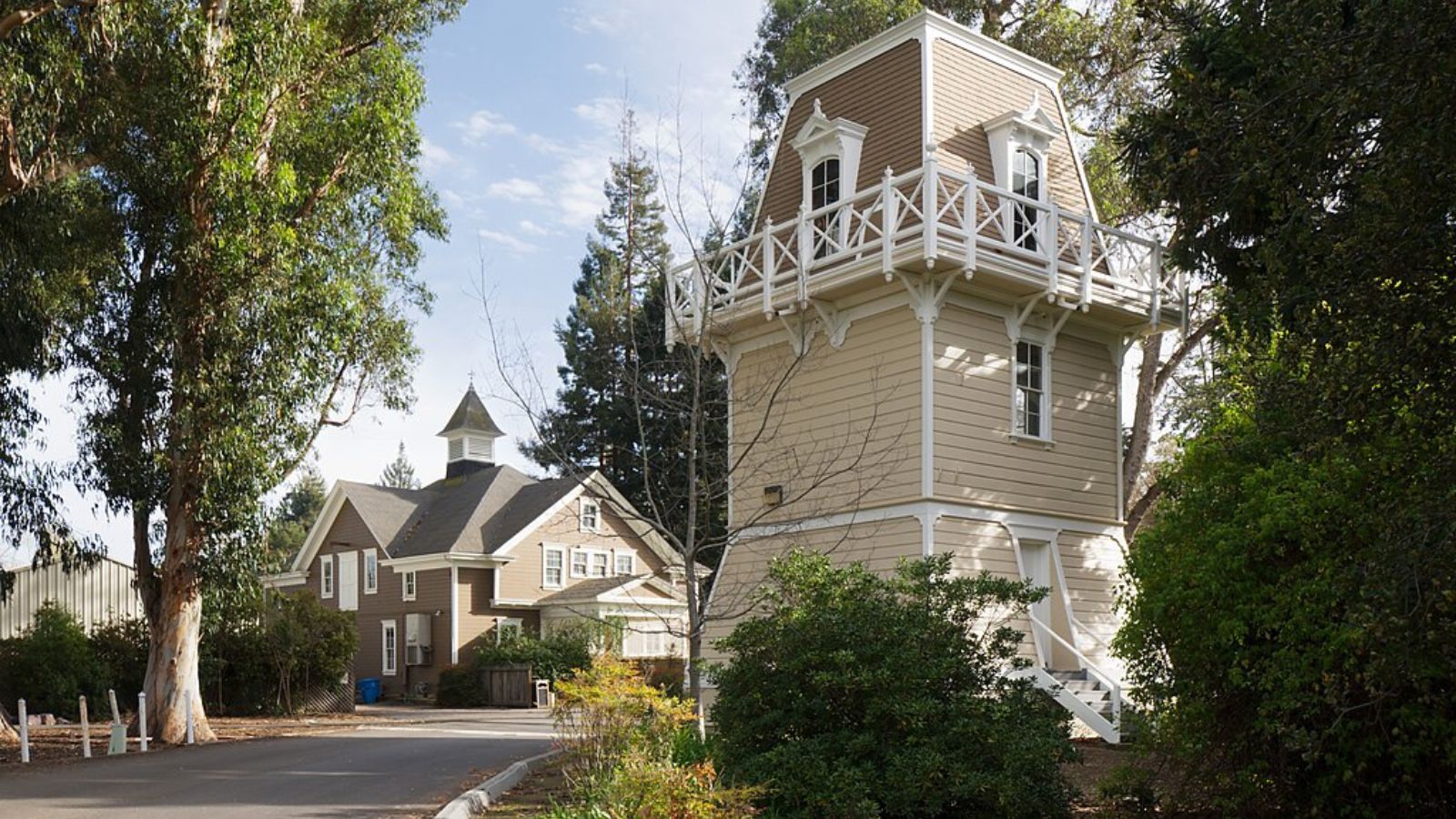
Why are people willing to pay so much to live here? What’s special about it?
Atherton offers the ultimate in privacy, luxury, and proximity to Silicon Valley innovation that appeals to the world’s most successful technology leaders and entrepreneurs. The community features expansive custom estates on large lots with complete privacy and security while maintaining access to Stanford University and major technology companies. Residents enjoy custom architecture, luxury amenities, and recreational facilities while living in America’s most expensive residential community.
The town’s exclusivity stems from its limited housing stock and association with unprecedented technology industry wealth that creates unparalleled prestige value. Many estates feature custom amenities including guest houses, tennis courts, pools, and extensive landscaping that create resort-like environments for affluent families. The combination of ultimate privacy, luxury, proximity to innovation centers, and investment potential creates exceptional value that justifies record-breaking pricing for the nation’s wealthiest buyers.
How Atherton Rose to Prominence
Atherton was incorporated in 1923 as an exclusive residential community designed to attract San Francisco’s wealthiest families seeking suburban estates while maintaining business connections to the city. Early residents included railroad executives, banking leaders, and industrial magnates who built elaborate mansions on large lots designed to provide privacy and luxury. The community’s development established patterns of exclusivity and sophistication that continue today.
The town’s transformation into America’s most expensive community accelerated with Silicon Valley’s growth as technology companies created unprecedented wealth and attracted global talent. The proximity to Stanford University and major technology firms made Atherton increasingly attractive to entrepreneurs, executives, and venture capitalists seeking prestigious addresses. Continued investment in privacy, security, and luxury amenities has maintained Atherton’s status as the ultimate American residential destination for the world’s wealthiest individuals.
3 Interesting Tidbits
1. America’s Most Expensive – Atherton consistently ranks as the most expensive zip code in the United States, with median home values exceeding most cities’ entire real estate markets.
2. Tech Royalty – The community is home to numerous technology industry billionaires, including executives from major companies and successful entrepreneurs who shaped the digital age.
3. Ultimate Privacy – Many estates are completely hidden from public view, with gated driveways and extensive landscaping that provide complete privacy for high-profile residents.




